Overview:
The article provides a step-by-step guide on how to copy conditional formatting in Power BI, emphasizing its importance for enhancing data visualization and communication of insights. It supports this by detailing the process involved, troubleshooting common issues, and sharing best practices that ensure effective and consistent application of conditional formatting across visuals, ultimately improving operational efficiency and user engagement.
Introduction
In the dynamic landscape of data visualization, conditional formatting in Power BI emerges as a game-changer, enabling organizations to transform raw data into compelling narratives. By applying visual cues that highlight trends and critical metrics, users can create reports that not only inform but also engage stakeholders effectively.
As businesses strive to enhance their operational efficiency and decision-making processes, understanding the nuances of conditional formatting becomes essential. This article delves into practical strategies for mastering this feature, offering:
- A step-by-step guide
- Troubleshooting tips
- Advanced techniques that ensure data integrity and accessibility
Whether navigating common challenges or exploring best practices, readers will discover actionable insights that elevate their data storytelling and drive impactful results in their organizations.
Understanding Conditional Formatting in Power BI
Power BI copy conditional formatting enables users to enhance their data visualization by applying visual cues that highlight trends, outliers, and critical metrics. This feature of Power BI copy conditional formatting alters the appearance of visuals according to established conditions—such as values exceeding a specific threshold—making outputs not only more informative but also intuitive. For instance, consider the Admin Monitoring Workspace, which utilizes power bi copy conditional formatting to provide organizations with a comprehensive view of their inventory and usage metrics.
This capability directly tackles common challenges in utilizing insights from Power BI dashboards, such as time-consuming document creation and information inconsistencies. By integrating RPA solutions, organizations can automate repetitive tasks, further streamlining report generation and enhancing operational efficiency. The workspace updates automatically as new content is added, reflecting ongoing customer feedback and ensuring its relevance.
As a result, users can effectively communicate insights and engage stakeholders with clear, actionable information narratives. Notably, the blog post discussing these features garnered 124,433 views, indicating significant interest in the topic. As pawlowski6132 noted, ‘It’s not 90 days.
It’s 30 days. The question is, how to obtain as much as desired, highlighting the urgency of effective information management. Furthermore, with data integration and data security challenges representing 20% and 14% respectively, understanding and utilizing conditional styles, particularly power bi copy conditional formatting, is crucial for anyone aiming to elevate their data storytelling capabilities in 2024, especially as Power BI continues to evolve and incorporate user-driven enhancements.
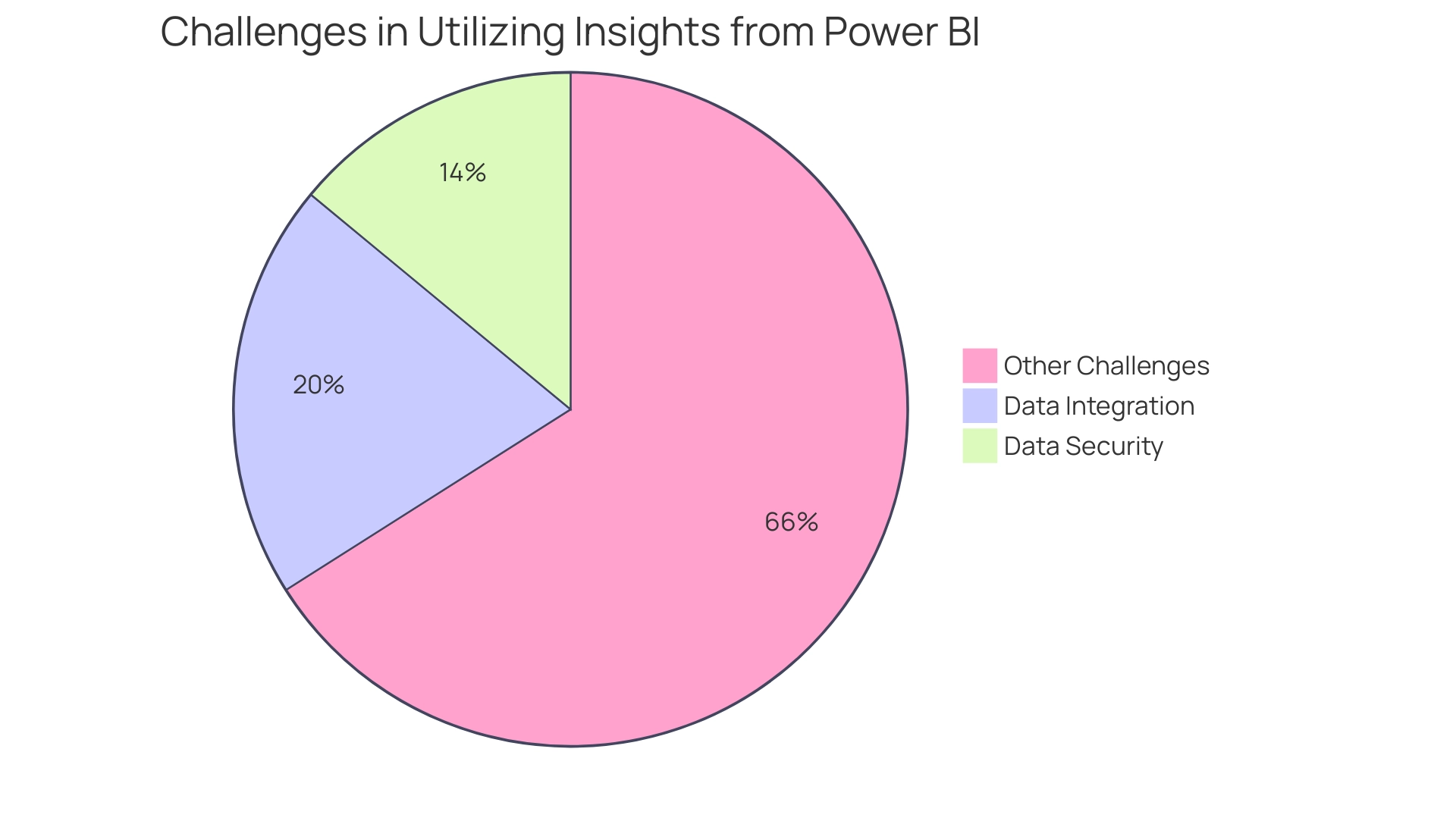
Step-by-Step Guide to Copying Conditional Formatting in Power BI
- Select the Visual: Begin by clicking on the visual from which you wish to perform power bi copy conditional formatting.
- Open Format Pane: Next, navigate to the Visualizations pane and select the paint roller icon to access the customization options.
- Locate Conditional Styles: Scroll down until you find the ‘Conditional styles’ section within the pane.
- Power BI copy conditional formatting: Use the ‘Copy’ option located next to the specific conditional style settings you wish to replicate.
- Select Target Visual: Click on the visual where you want to apply the copied style.
- Power BI copy conditional formatting: In the format pane of the target visual, select ‘Conditional style’ and then choose the ‘Paste’ option to use the power bi copy conditional formatting settings.
- Review and Adjust: Finally, examine the visual to confirm that the layout reflects your intentions. Make any necessary adjustments to achieve the desired appearance.
Implementing these steps not only streamlines your reporting process but also aligns with the principles of Robotic Process Automation (RPA) to enhance operational efficiency in a rapidly evolving AI landscape. By automating manual styling tasks, you reduce errors and free your team for more strategic activities, driving data-driven insights crucial for business growth. With over 4,538 views on this topic, it’s clear that effective structuring is essential for enhancing communication through visuals. As Scott Sugar aptly states, ‘The ability to communicate with people, regardless of distance or location, is one of the best things about tech.’ Furthermore, by recognizing unused reports through metrics, as emphasized in the ‘Unused Reports Count’ case study, RPA can assist in directing your efforts toward the most pertinent visuals, thereby improving decision-making and operational efficiency.
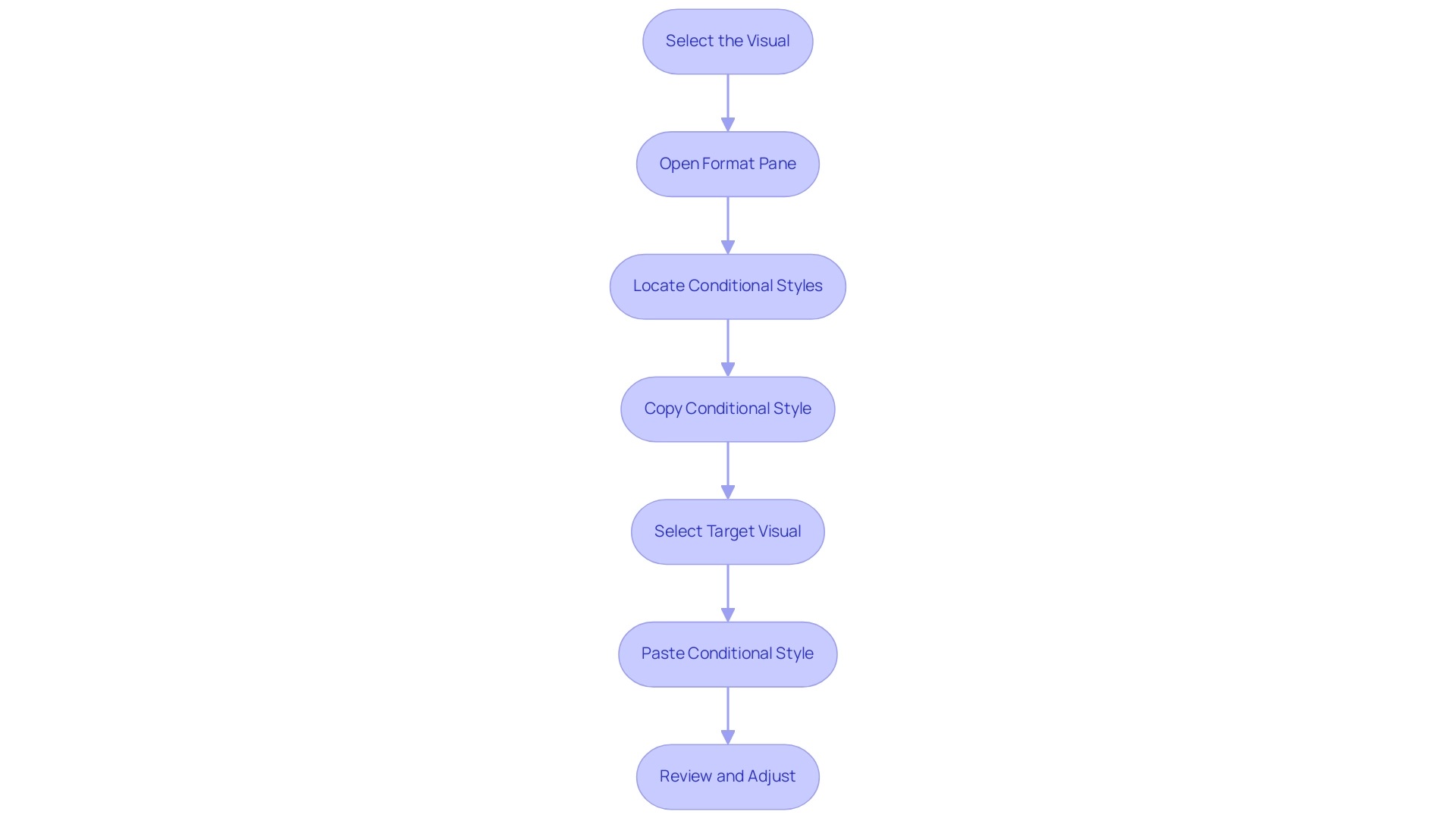
Troubleshooting Common Issues with Conditional Formatting Copying
-
Formatting Not Appearing: When copied formatting does not appear, it’s crucial to check that both visuals are compatible and support the same type of formatting. This compatibility is essential to ensure that your desired design, such as power bi copy conditional formatting, is reflected accurately across different visuals. As Rajendra Ongole noted, ambiguous relationships can lead to incorrect results, making data verification even more critical in this context.
-
Errors During Copying: Should you encounter errors during the copying process, a simple yet effective first step is to restart Power BI or check for any available updates. Keeping your software up-to-date can often resolve unexpected issues, streamline your workflow, and help with the common challenge of time-consuming report creation, particularly when utilizing power bi copy conditional formatting.
Inconsistent Results: If you observe that the layout looks different across visuals, take the time to confirm that the information types and field settings align perfectly. Inconsistent information types can lead to unexpected results, making this verification a key step in maintaining visual integrity and ensuring accurate insights driven by information, particularly when applying power bi copy conditional formatting. Given that combining sales information monthly instead of daily can significantly affect reporting trends, using Power BI to copy conditional formatting is vital for ensuring accurate formatting.
Governance Strategies: To reduce inconsistencies, it’s essential to implement a strong governance strategy. This method can assist in upholding information integrity across reports and encourage confidence in the insights obtained from BI dashboards. Without proper governance, organizations may face challenges in achieving reliable and actionable insights.
-
Undo Changes: In cases where you accidentally overwrite your formatting, don’t forget that the ‘Undo’ feature (Ctrl + Z) is your ally. This quick action can revert your visuals back to their previous state, saving you from potential frustrations and ensuring your work is preserved.
-
Real-World Challenges: Additionally, it’s important to consider the integration challenges highlighted in the case study titled ‘Integration and Connectivity Challenges.’ As organizations expand, combining BI with external systems can result in challenges such as API modifications and inconsistent formats. Documenting integration points and utilizing intermediate storage can enhance flexibility and scalability in Power BI environments, thereby addressing challenges in leveraging insights effectively. Moreover, stakeholders should ensure that documents not only present information but also provide clear, actionable guidance to facilitate informed decision-making.
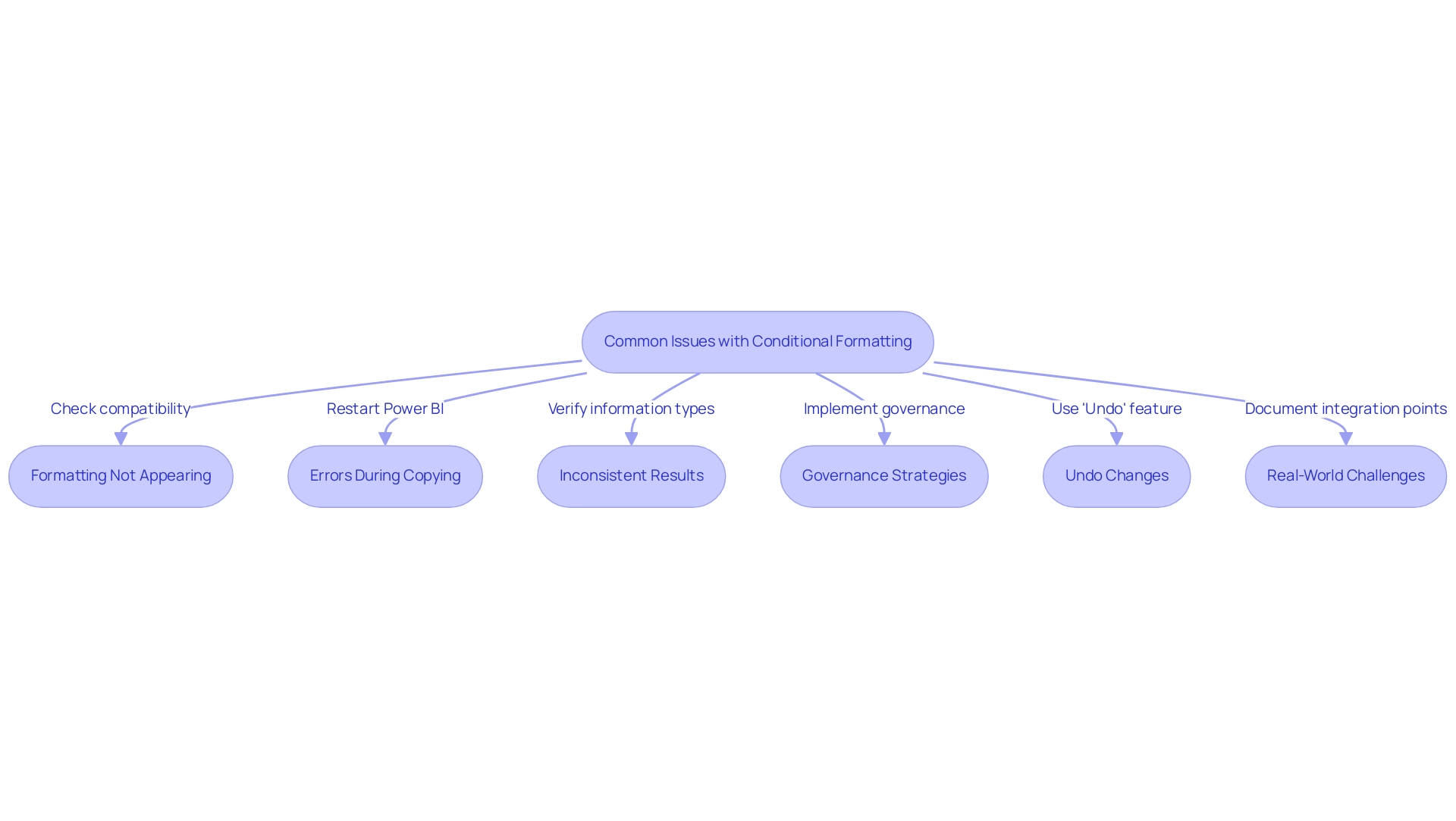
Advanced Tips for Effective Conditional Formatting in Power BI
-
Utilize DAX for Dynamic Formatting: Harness the power of DAX expressions to establish dynamic formatting rules that allow you to use power bi copy conditional formatting based on complex conditions. This method not only generates documents that communicate information effectively but also emphasizes key insights customized to your audience’s requirements. By dedicating just 7 minutes to the ‘Power BI Slicer Tutorial’, you can significantly enhance your understanding of these essential techniques, addressing the common challenge of time-consuming document creation.
-
Combine with Other Visuals: Pair Power BI copy conditional formatting with additional visuals, such as slicers and charts, to weave a cohesive and comprehensive narrative. This integration enhances the clarity of your summaries, allowing stakeholders to swiftly understand the narrative, thereby minimizing confusion arising from inconsistencies. When dealing with total hierarchies, remember to calculate ‘Total’ as a calculated column or utilize a different visual for clarity. Significantly, implementing a governance strategy can further mitigate inconsistencies by ensuring integrity across reports.
-
Implement Color Gradients: Employ color gradients to effectively illustrate variations in intensity. This technique simplifies the visualization of ranges and trends, making it easier for viewers to identify key patterns and outliers in your data, ultimately providing the actionable guidance that stakeholders often seek.
-
Test Across Various Devices: To ensure your documents maintain their effectiveness and appeal, always preview them on different devices. This step is crucial in confirming that your conditional design remains visually compelling and functional across all viewing platforms. As Fowmy aptly states,
Next time you aim to elevate the visual appeal of your BI visuals, keep this handy technique in mind to breathe new life into your visuals.
Furthermore, consider the case study titled ‘Power BI Copy Conditional Formatting for Matrix Levels‘, which showcases a practical workaround for using power bi copy conditional formatting techniques at different levels of a matrix visual. This case study illustrates how applying these techniques can greatly improve the efficiency and visual appeal of your BI analysis, while also emphasizing the significance of a governance strategy in ensuring consistency.
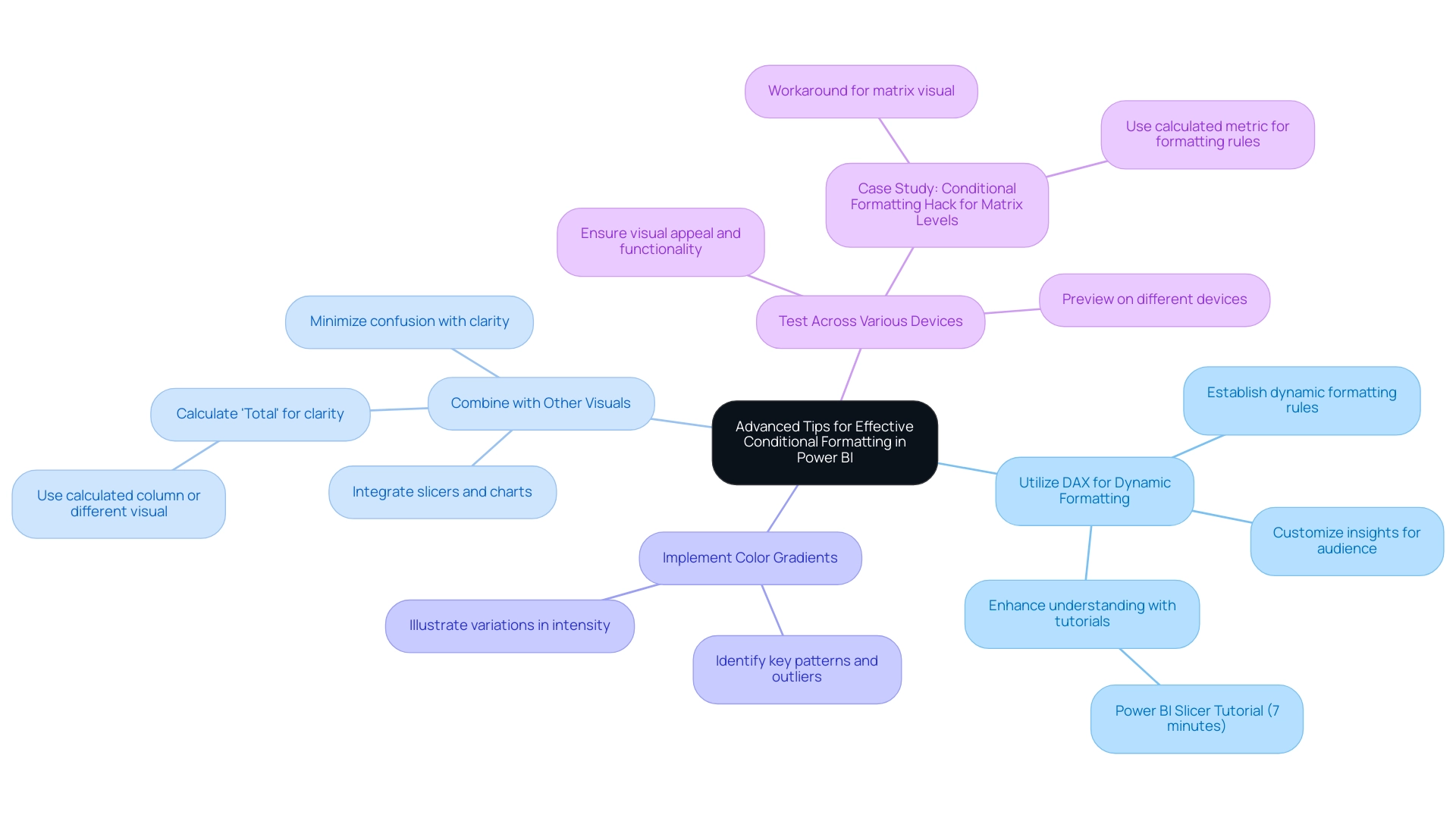
Best Practices for Using Conditional Formatting in Power BI
-
Maintain Consistency: Establishing a uniform color scheme and design rules across all visuals is vital for creating a cohesive report, especially when you’re working towards a polished final product in your 3-Day Power BI Sprint. Consistency helps in user understanding, enabling stakeholders to interpret information more effectively.
-
Limit Overuse: While conditional styling can be a powerful tool, excessive use can clutter your visuals and overwhelm users. Apply styling strategically to emphasize critical data points, ensuring that the most important information stands out without creating confusion. This approach enhances the actionable insights that Business Intelligence aims to deliver.
-
Test for Accessibility: Consider the accessibility of your color choices to accommodate all users, including those with color vision deficiencies. For instance, the feedback from DataRich, a new member, highlights the importance of inclusive design:
As someone who is partially color-blind, I appreciate the mention of that.
This insight emphasizes the necessity for careful color choice in your documents to maximize the effectiveness of your BI tools. -
Document Your Rules: Keeping a comprehensive record of the conditional formatting rules you apply is essential for maintaining consistency, especially when updating documents. This practice not only enhances operational efficiency but also supports users in navigating the dashboard with Power BI copy conditional formatting. For instance, sorting by axis can help users quickly find specific categories within many options. Furthermore, the case study titled ‘Help the User’ illustrated that supportive features such as pop-ups and documentation greatly enhance user confidence and effectiveness, emphasizing the significance of these practices in your work. Furthermore, remember that pie charts are most effective when there are fewer than eight categories, which can guide your visual design choices and ensure that your actionable insights are clearly communicated. By following these best practices, you can leverage the insights generated from the fully functional report created during your 3-Day Power BI Sprint, which can also serve as a template for future projects, ensuring a professional design from the start, particularly through the use of Power BI copy conditional formatting.

Conclusion
Harnessing the power of conditional formatting in Power BI is essential for transforming raw data into meaningful insights. By applying visual cues that highlight trends and critical metrics, organizations can create reports that not only engage stakeholders but also drive informed decision-making. The step-by-step guide provided offers a clear pathway to effectively copy and apply conditional formatting, while troubleshooting tips ensure that users can navigate common challenges with ease.
Advanced techniques, such as utilizing DAX for dynamic formatting and integrating color gradients, further enhance the storytelling capabilities of Power BI reports. Adhering to best practices—like maintaining consistency, limiting overuse, and testing for accessibility—ensures that the visuals remain clear and impactful. Documenting formatting rules also facilitates ongoing improvements and streamlines future reporting efforts.
As Power BI continues to evolve, mastering conditional formatting will empower organizations to elevate their data visualization efforts. By embracing these strategies, users can unlock the full potential of their data, ultimately fostering a culture of data-driven decision-making that can lead to substantial operational efficiencies and competitive advantages. Now is the time to implement these insights and transform how data narratives are communicated within organizations.
Overview:
To convert UTC to local time in Power BI using DAX, users should follow a systematic step-by-step approach that includes creating a new column and applying the appropriate DAX formula to adjust for local time offsets. The article emphasizes that mastering this conversion process is essential for accurate data analysis and reporting, particularly in light of challenges such as Daylight Saving Time adjustments and the need for precise temporal information to enhance decision-making.
Introduction
In the realm of data analysis, the ability to accurately convert Coordinated Universal Time (UTC) to local time is not just a technical necessity; it’s a strategic advantage. As organizations increasingly rely on tools like Power BI for decision-making, understanding the nuances of time conversion becomes vital to ensure that insights drawn from data are precise and actionable.
The complexities introduced by local time variations and Daylight Saving Time (DST) can hinder effective reporting, leading to potential misinterpretations that impact business outcomes. This article delves into the essential methods and DAX functions required for seamless UTC to local time conversion, while also addressing common challenges faced by professionals in this space.
By mastering these techniques and leveraging automation solutions, organizations can enhance their operational efficiency and harness the full potential of their data analytics capabilities.
Understanding UTC and Local Time Conversion in Power BI
Coordinated Universal Time (UTC) serves as the global standard for regulating clocks and schedules, remaining consistent throughout the year without seasonal adjustments. This reliability makes UTC an invaluable reference for information analysis, as noted in the Wikipedia page about UTC±00:00. Nevertheless, local hours vary between areas and are influenced by changes like Daylight Saving Time (DST), complicating information interpretation and creating challenges such as lengthy report generation and inconsistencies in figures.
For professionals utilizing Power BI, it is crucial to use the method to power bi convert utc to local time dax to ensure that visualizations accurately reflect the intended moment for analysis and reporting. Rajani Vepa emphasizes that mastering this conversion is foundational for achieving precise insights in your reports and dashboards, ultimately enhancing decision-making processes. Moreover, grasping the historical background of temporal standards, such as the shift from Greenwich Mean Time (GMT) to UTC, demonstrates the development of clock management and its importance in information analysis.
By leveraging Business Intelligence and RPA solutions like EMMA RPA and Power Automate, organizations can automate repetitive tasks and address these challenges, improving operational efficiency and driving growth through actionable insights. Failing to extract meaningful insights can leave businesses at a competitive disadvantage, underscoring the urgency of utilizing these tools effectively.
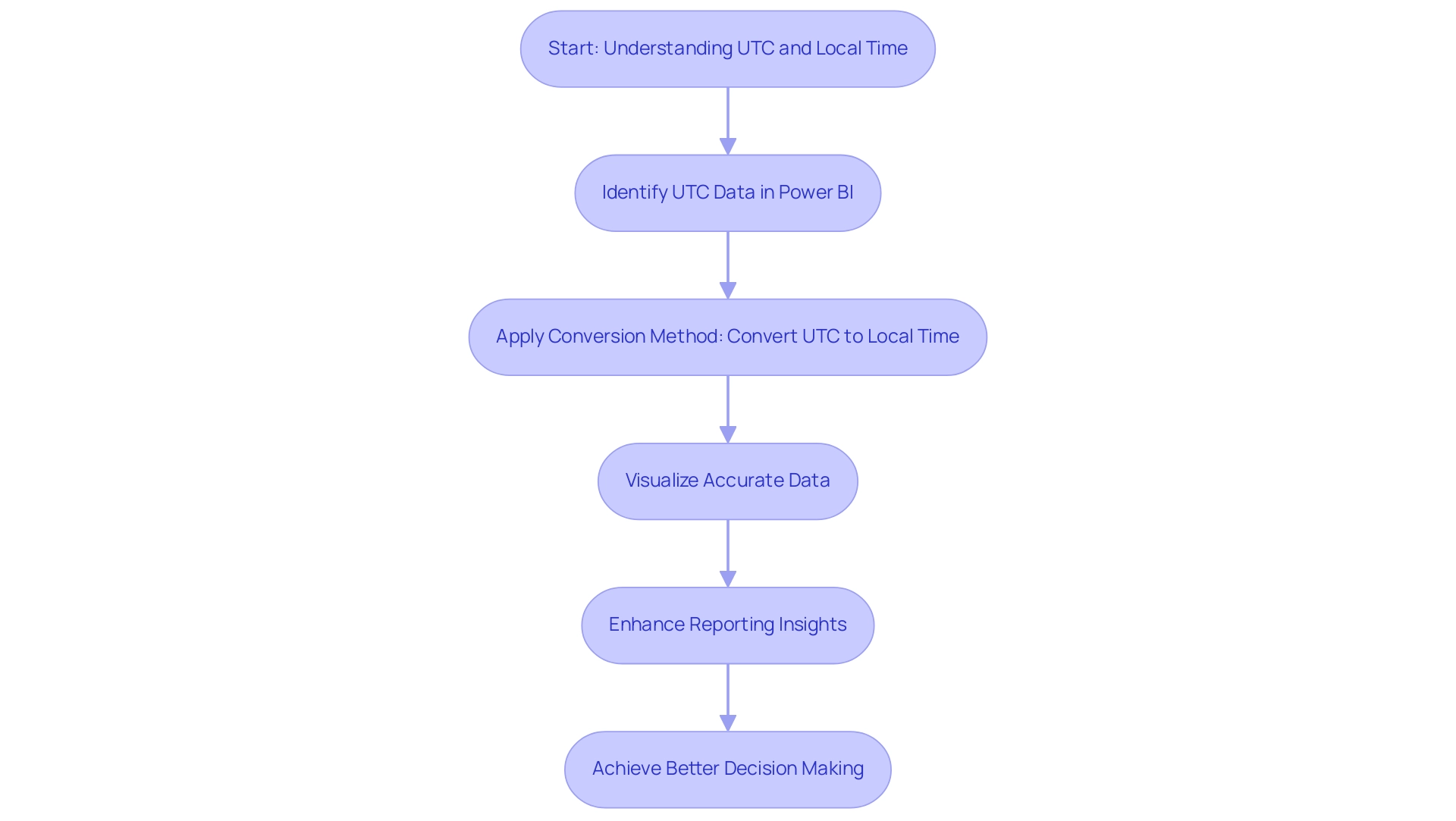
Step-by-Step Guide to Converting UTC to Local Time Using DAX
The procedure to power bi convert utc to local time dax is simple yet essential, as it transforms UTC to local hours, enhancing your analysis capabilities, particularly in light of possible delays in importing new usage information that can last up to 24 hours. Prompt data analysis is crucial for operational efficiency, so follow this step-by-step guide to ensure precision in your reporting:
- Open Power BI Desktop: Start your Power BI application and load the dataset that contains your UTC timestamps.
- Create a New Column: Navigate to the Data view, select your target table, and then click on ‘Modeling’ followed by ‘New Column’.
- Enter the DAX Formula: Input the following DAX formula to facilitate the conversion from UTC to local time:
DAX
LocalTime = UTCDateTime + TIME(Offset Hours, 0, 0)
Here, replaceOffset Hourswith the number of hours your local time zone differs from UTC. - Validate the Results: Once the new column is created, review it to confirm that the conversion has been executed correctly. Visualizing this information in your reports can help ensure its accuracy. Remember, to see all workspace usage metrics, you may need to remove the default filter applied to the report.
- Preserve Your Work: Ultimately, remember to store your Power BI file to protect the modifications you’ve made.
By mastering this process, you enhance your analytical toolkit, enabling more effective decision-making based on precise local temporal information. This mastery is crucial, particularly considering the typical challenges organizations encounter, such as spending more time on creating reports than utilizing insights from Power BI dashboards, resulting in confusion and mistrust in information. To enhance operational efficiency, consider incorporating RPA solutions to automate the report creation process, allowing your team to focus on analysis rather than information compilation.
Additionally, implementing governance strategies can help ensure consistency across reports, addressing one of the key challenges highlighted in the context. As illustrated by the case study on report usage metrics with Private Links, organizations face challenges in data reporting when metrics are not accurately captured. As Igor Plotnikov, a BI/Data Engineer, noted,
Hope I managed to expand your arsenal in tackling this challenge.
Embracing these techniques positions you for success in your operational efficiency goals.
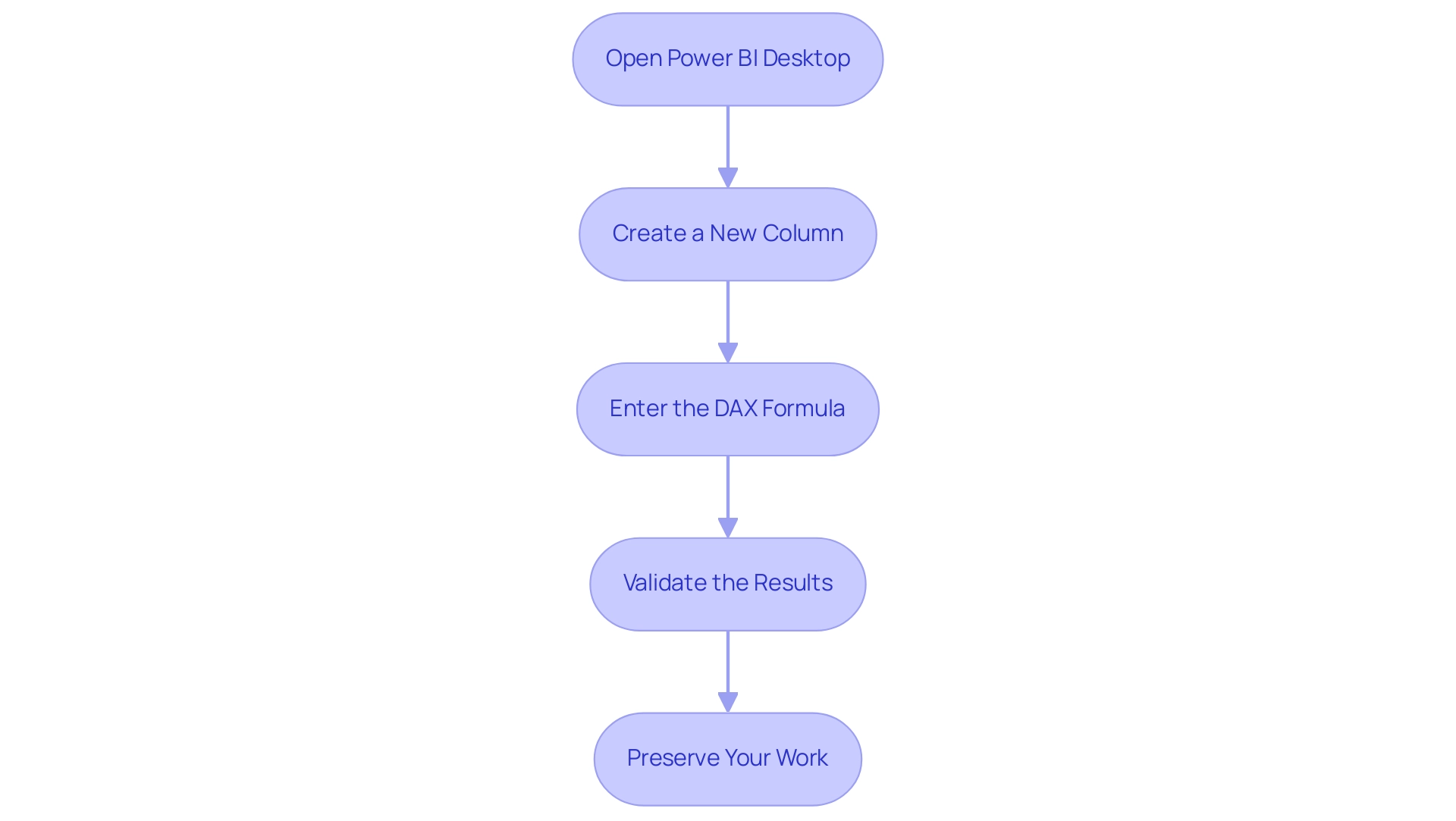
Navigating Daylight Saving Time in Time Conversion
Daylight Saving Time (DST) introduces complexities that affect how Power BI converts UTC to local time DAX, as the necessary offset can shift throughout the year. To effectively manage power bi convert utc to local time dax in your DAX calculations, leveraging conditional logic is essential. The following DAX formula illustrates how to adjust for DST:
LocalTime =
IF(
MONTH(UTCDateTime) IN {3, 4, 5, 6, 7, 8, 9} && DAY(UTCDateTime) >= 14,
UTCDateTime + TIME(Offset Hours + 1, 0, 0),
UTCDateTime + TIME(Offset Hours, 0, 0)
)
This formula systematically checks whether the date falls within the DST period, adjusting the offset to reflect the correct local time throughout the year.
As noted by Dr. Adam Spira, “fortunately, most people can acclimate to the time change within a week or so,” indicating that while adjustments are necessary, they are manageable. Furthermore, comprehending the cost linked to the DST shift, as projected in the S30 Table, emphasizes the financial consequences of these modifications in reporting. The S30 Table contains a file size of 3.8KB, emphasizing the importance of managing information efficiently when dealing with DST.
A practical example can be seen in the case study of Hawaii, which does not observe DST; this study found no significant impacts on mortality rates, illustrating the complexities and effects of DST on analysis. This understanding is essential, particularly when considering the implications of DST on information accuracy and reporting efficiency. In a rapidly evolving AI landscape, embracing Robotic Process Automation (RPA) can streamline these manual data handling challenges, including automating the DST adjustment process and enhancing report creation efficiency, thereby allowing your team to focus on strategic, value-adding activities.
Furthermore, by automating these processes, organizations can mitigate the financial impacts associated with DST adjustments, ultimately driving better operational efficiency.
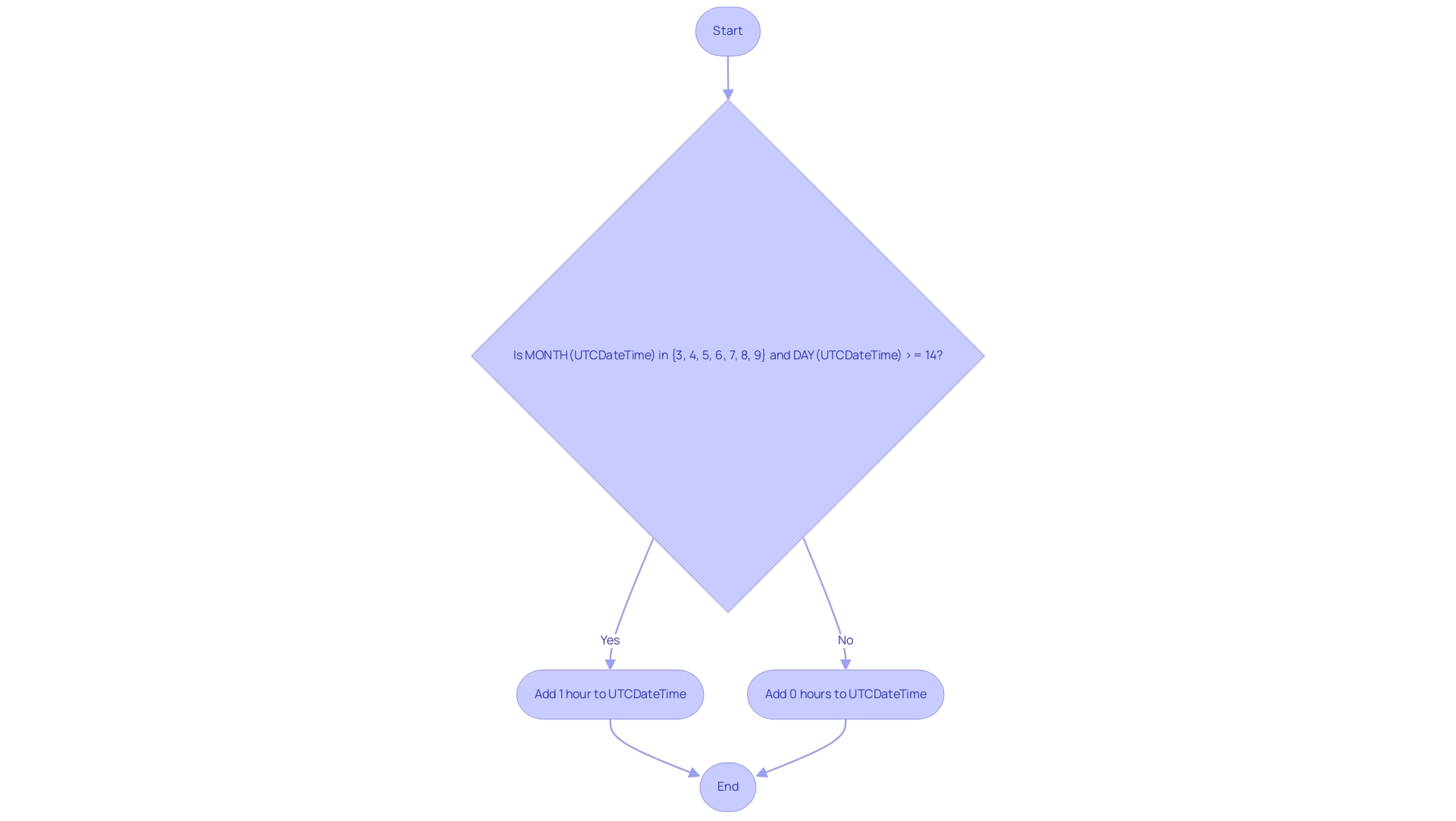
Common Challenges and Solutions in UTC to Local Time Conversion
Converting UTC to local hours might appear simple, but it often presents several challenges that require careful consideration:
- Incorrect Offsets: Always check the offset hours for accuracy. It is essential to use a reliable source to verify your local zone’s current offset from UTC, as this can fluctuate based on various factors. Flawed duration transformation can result in substantial problems; for example, with a bounce rate of 50.9%, ensuring accurate data analysis is essential to maintain user engagement. Utilizing Robotic Process Automation (RPA) can assist in automating these checks by integrating with dependable zone databases, greatly minimizing human error and enhancing operational efficiency.
Daylight Saving Time (DST) Changes: For regions that observe DST, your DAX formulas need to utilize the method to power bi convert utc to local time dax to manage these seasonal adjustments. Implement conditional logic within your calculations to automatically adjust offsets based on the time of year, ensuring accurate transformations for power bi convert utc to local time dax. The significance of accuracy in these calculations is emphasized by the fact that 48% of users abandon carts due to unexpected costs, highlighting the need for precise information management to avoid operational pitfalls. RPA can facilitate this process by automatically updating and applying DST rules across all relevant datasets, ensuring consistency and reliability.
- Data Type Issues: Confirm that your UTC timestamps are formatted correctly as date/time values. If timestamps are stored as text, utilize the
DATEVALUEorTIMEVALUEfunctions to transform them before applying the necessary adjustments, preventing potential errors in your analysis. Authenticity in information is as crucial as in reviews, where focusing on quality can yield better outcomes than simply accumulating a large volume of information. Automating these transformations through RPA not only improves information integrity but also optimizes your workflow, enabling your team to concentrate on more strategic tasks.
Zone Variations: When handling information across several regions, it can be advantageous to establish a lookup table that links each location with its corresponding UTC offset and DST regulations. This method streamlines the transformation process, making it more manageable to handle diverse datasets using Power BI convert UTC to local time DAX. As VWO is relied upon by numerous top brands, ensuring precise temporal transformation can improve the dependability of your analysis, directly affecting operational efficiency. By implementing RPA, you can automate the upkeep of this lookup table, ensuring it remains current without manual intervention, thus liberating your team to focus on more strategic initiatives.
As you address these challenges, keep in mind that accuracy and dependability are essential for effective conversion, directly influencing the quality of your information analysis. Embracing RPA in this context not only enhances efficiency but also empowers your team to focus on strategic initiatives that drive business growth.
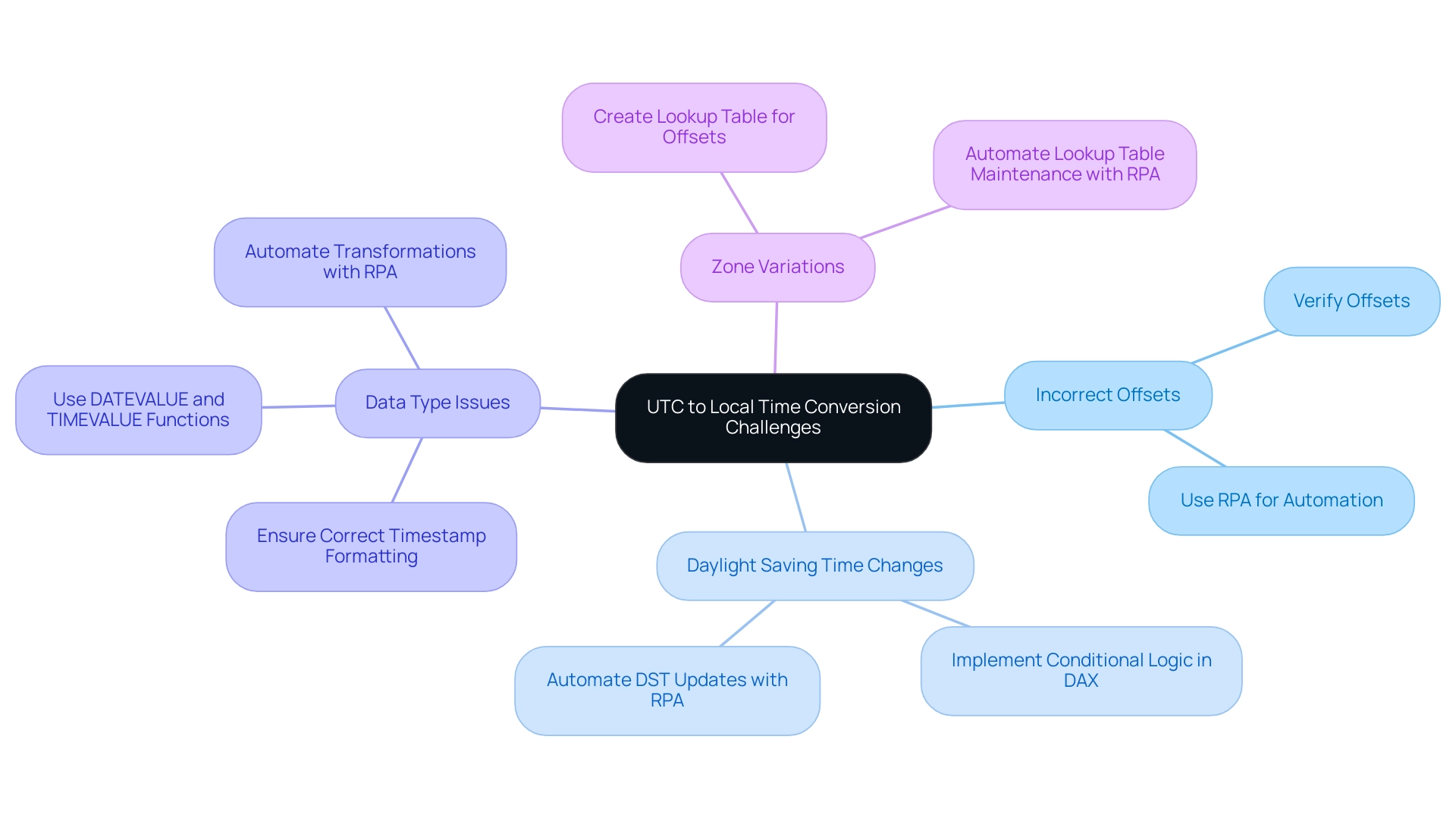
Key DAX Functions for Time Conversion in Power BI
To successfully convert UTC to local time in Power BI, it is essential to understand and utilize several DAX functions that facilitate accurate time calculations, ultimately enhancing your operational efficiency and data-driven insights:
- DATEVALUE: This function is invaluable as it converts a date presented in text format into a proper date value, ensuring that subsequent calculations are performed correctly and reducing time spent on report creation.
- TIMEVALUE: Likewise, TIMEVALUE transforms moments expressed as text into a numerical value, which is essential for ensuring precision in temporal calculations and resolving inconsistencies in information.
- IF: The IF function allows for the implementation of conditional logic, enabling you to accommodate variations such as Daylight Saving Time adjustments effectively, which can often lead to inconsistencies in reporting.
- MONTH: This function extracts the month from a date, helping determine whether a particular date falls within the Daylight Saving Time period, thus providing clarity and actionable guidance for stakeholders.
- QUARTER: The QUARTER(
) function can also be beneficial for comprehending seasonal trends in your information, which may influence temporal adjustments and overall analytical insights. - ADDCOLUMNS: By utilizing ADDCOLUMNS, you can create new columns derived from existing ones, making it easy to incorporate local adjustments directly into your dataset, streamlining your reporting process.
For example, consider a scenario where you calculate the total sales amount for the Western region in January 2022 using a DAX formula. This practical application showcases how these functions can be utilized effectively in real-world scenarios, enhancing your ability to leverage insights from Power BI dashboards.
Incorporating Robotic Process Automation (RPA) alongside these DAX functions can further enhance operational efficiency by automating repetitive reporting tasks, allowing your team to concentrate on analysis rather than input. Mastering these functions not only empowers you to handle time conversions with greater precision through power bi convert utc to local time dax but also enhances your overall analysis capabilities, addressing the common challenge of report creation.
Additionally, having a robust governance strategy in place is crucial to mitigate inconsistencies. This strategy ensures that data is accurate and reliable, providing stakeholders with clear, actionable guidance based on well-governed data.
As Sovan Pattnaik, a Technical Specialist in Data and Analytics, notes, “This is very helpful. Thank you so much!” This sentiment reflects the growing acknowledgment of the significance of these functions in enhancing user proficiency with DAX, particularly in the context of conversions.
With the recent updates in DAX functions for 2024, taking the time to familiarize yourself with these tools will significantly elevate your operational efficiency in Power BI.
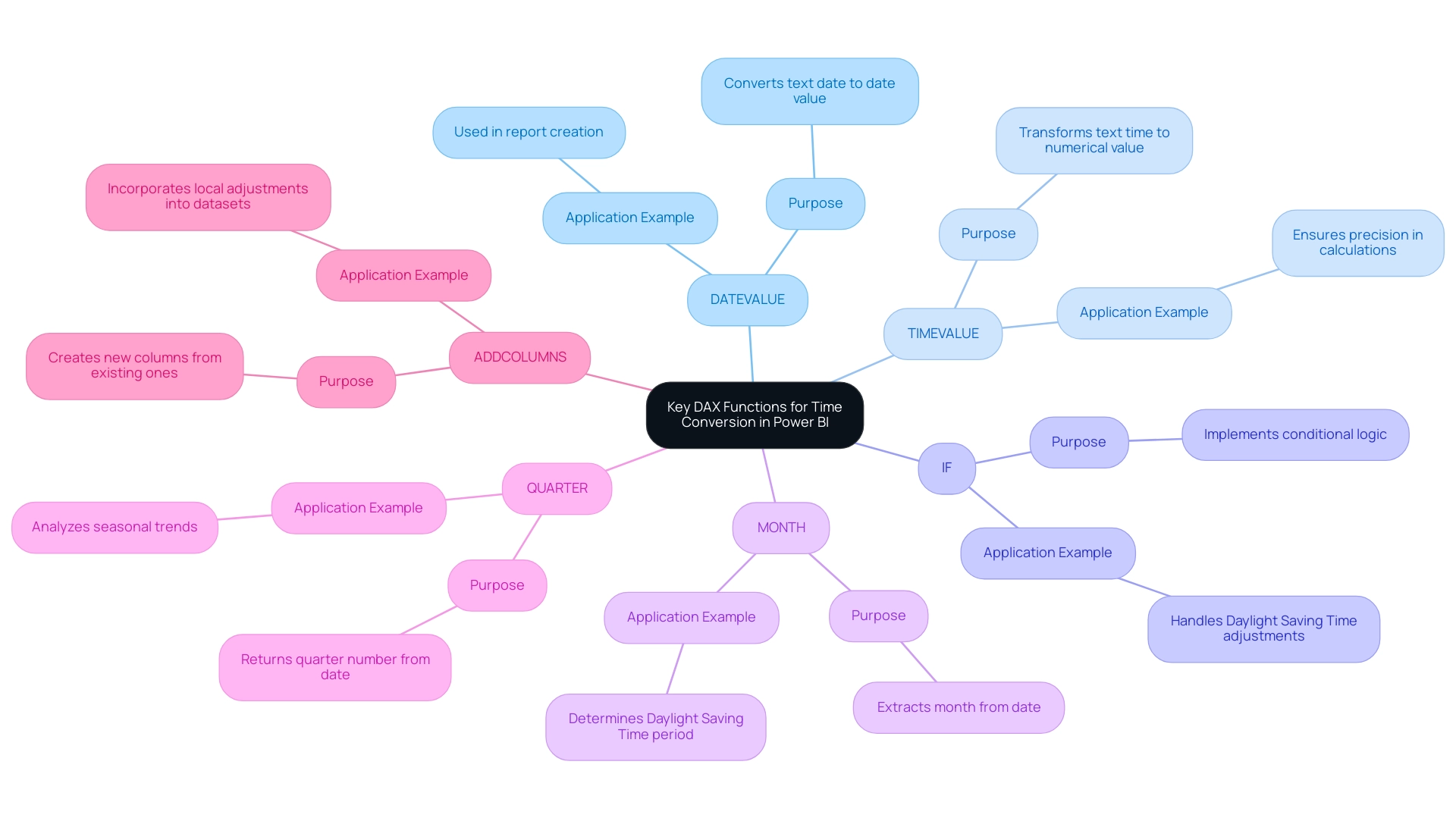
Conclusion
Mastering the conversion of Coordinated Universal Time (UTC) to local time in Power BI is more than just a technical skill; it is a cornerstone for effective data analysis and decision-making. Understanding the nuances of UTC, local time variations, and Daylight Saving Time (DST) is essential for ensuring that reports are accurate and insights are actionable. By following the outlined step-by-step guide and utilizing key DAX functions, professionals can enhance their reporting capabilities and overcome common challenges associated with time conversion.
The integration of Robotic Process Automation (RPA) into these processes provides a significant advantage, enabling organizations to automate repetitive tasks, reduce human error, and maintain data integrity. This not only streamlines workflows but also allows teams to focus on strategic initiatives that drive business growth. The case studies and examples highlighted throughout the article underscore the importance of accuracy and reliability in time conversion, directly impacting the quality of data analysis and operational efficiency.
As organizations embrace these techniques and tools, they position themselves to leverage their data analytics capabilities fully. The combination of mastering DAX functions, implementing effective governance strategies, and automating processes through RPA creates a robust framework for successful time conversion. This is a crucial step toward making informed decisions that propel operational efficiency and enhance overall business performance. Embracing these practices ensures that organizations remain competitive in a data-driven landscape, turning challenges into opportunities for growth and efficiency.
Overview:
The article provides a comprehensive step-by-step guide on performing cluster analysis in Power BI, detailing the importance of clustering methods and their applications in extracting actionable insights from data. It emphasizes that effective clustering, supported by techniques such as K-Means and Hierarchical Clustering, enhances decision-making and operational efficiency, as evidenced by case studies demonstrating significant improvements in business performance.
Introduction
In the realm of data analysis, clustering emerges as a transformative technique that empowers organizations to uncover hidden patterns and relationships within their datasets. By grouping similar data points, companies can drive strategic decisions that enhance operational efficiency and foster growth.
With the increasing complexity of data landscapes, mastering clustering methods such as:
- K-Means
- Hierarchical Clustering
- DBSCAN
in Power BI is not just advantageous; it’s essential.
This article delves into the fundamentals of clustering, providing a comprehensive guide on executing cluster analysis in Power BI, exploring various methods, and outlining best practices for successful implementation. By equipping decision-makers with actionable insights and practical strategies, organizations can harness the full potential of their data, paving the way for informed decision-making and sustained business success.
Understanding Clustering: The Basics
Clustering is a powerful method in information examination that supports Power BI cluster analysis by grouping similar points based on specific attributes, enabling organizations to unveil hidden patterns and structures within their collections. As Zyzanski et al. emphasize, the importance of comprehending the characteristics of grouped information is crucial for precise evaluation, clarifying how points correspond with each other within clusters.
By utilizing grouping methods like K-Means, Hierarchical Grouping, and DBSCAN in Power BI cluster analysis, decision-makers can improve their visualizations, making connections between elements clearer and more accessible—essential for fostering insights based on information and operational efficiency. Recent progress in grouping methods, especially in 2024, highlights its increasing importance in information evaluation. For example, the case study titled ‘Intracluster Correlation Examination‘ illustrated that a higher intracluster correlation signifies a more pronounced grouping effect, essential for comprehending the implications of grouping in statistical evaluation.
As Saurav Kaushik, a passionate data science enthusiast, notes,
Clustering techniques are vital for uncovering complex relationships and driving insightful choices.
Furthermore, a testimonial from a leading retail firm showcased how applying grouping analysis in their BI strategy led to a 20% increase in operational efficiency. This foundational technique not only aids in understanding information but also empowers organizations to harness Business Intelligence for actionable insights and make informed, insight-driven decisions effectively.
The advantages of Power BI cluster analysis in Power BI lead to enhanced analytical capabilities, allowing organizations to explore their information landscapes with confidence and precision, ultimately fostering business growth.
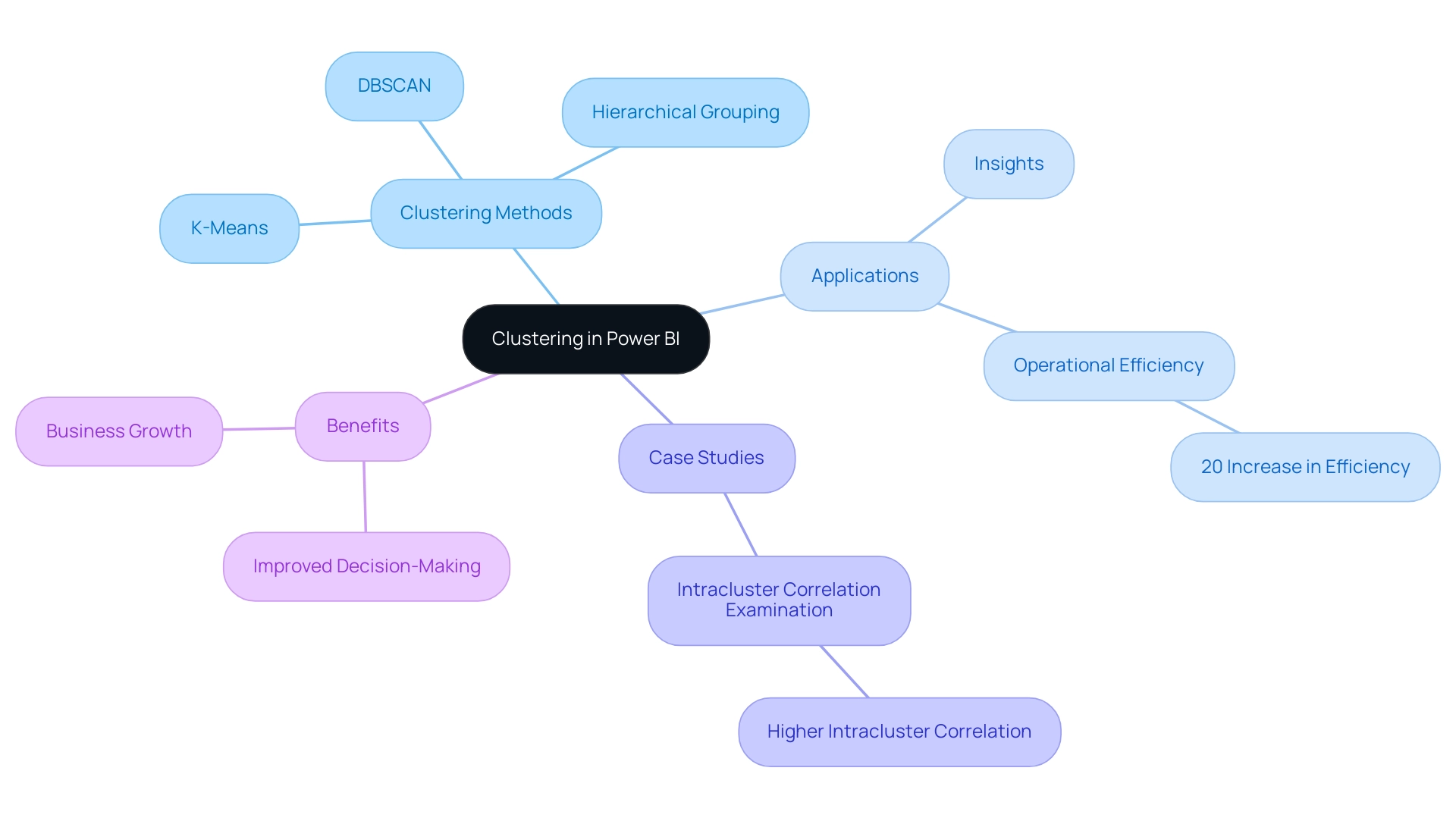
Step-by-Step Guide to Performing Cluster Analysis in Power BI
-
Open Power BI Desktop: Begin by launching the Power BI application and loading your dataset, ensuring that you have all necessary data at hand. This step is crucial in utilizing the strength of Business Intelligence to promote informed decision-making and reduce the competitive disadvantage of lacking actionable information.
-
Navigate to the Report View: Switch to the report view, which is essential for creating and manipulating visualizations effectively, helping to alleviate the challenges of time-consuming report creation.
The analysis of data can be greatly improved by utilizing power bi cluster analysis.
-
Select the Visualization Pane: Choose a scatter chart or another visualization that supports clustering, which is crucial for power bi cluster analysis and extracting actionable insights.
-
Add Information Fields: Drag and drop the relevant fields into the X and Y axes of your scatter chart, setting the stage for insightful representation that can highlight operational efficiencies.
-
Power BI cluster analysis can provide valuable insights.
Enable Clustering in Power BI Cluster Analysis: With the scatter chart selected, access the ‘Analytics’ pane and choose ‘Add Clusters’. This function will automatically group your data points based on their similarities, utilizing power bi cluster analysis to enhance data interpretability. Note that HDBSCAN can effectively identify groupings when all features show a within-feature difference corresponding to Cohen’s values of 0. The analysis of data can be greatly improved by utilizing power bi cluster analysis, which can be a valuable standard for your evaluation.
The analysis of data can be significantly enhanced through power bi cluster analysis.
-
Adjust Power BI Cluster Analysis Settings: Fine-tune the settings for power bi cluster analysis, including the number of clusters and the distance metrics. This customization aligns the analysis with your specific objectives in the power bi cluster analysis and improves the accuracy of your findings, ensuring that the conclusions are both relevant and actionable.
-
Review the Results: Analyze the clusters generated in your visualization, interpreting the insights they provide. As noted by Jason Himmelstein,
Selecting the correct data type is important as it influences how your visual calculations can be used in your charts and affects available formatting options for further customization.
This selection is crucial for effective grouping and visualization.
The data insights can be significantly improved through power bi cluster analysis.
-
Reference Case Study: Consider the findings from the case study titled “Statistical Power and Accuracy in Power BI Cluster Analysis,” which defined statistical power in the context of power bi cluster analysis and demonstrated the effectiveness of various methods in detecting true subgroups based on silhouette scores. This case study illustrates the significance of employing robust methods to obtain dependable knowledge, especially in improving operational efficiency through Business Intelligence.
-
Integrate RPA Solutions: To further enhance your operational efficiency, consider integrating RPA solutions such as EMMA RPA and Power Automate. These tools can automate repetitive tasks and streamline your data processes, enabling you to concentrate on evaluation and decision-making.
-
Save Your Report: When you’re satisfied with your analysis, save your Power BI report for future reference and sharing, ensuring your findings are preserved for stakeholders and can drive strategic decisions.
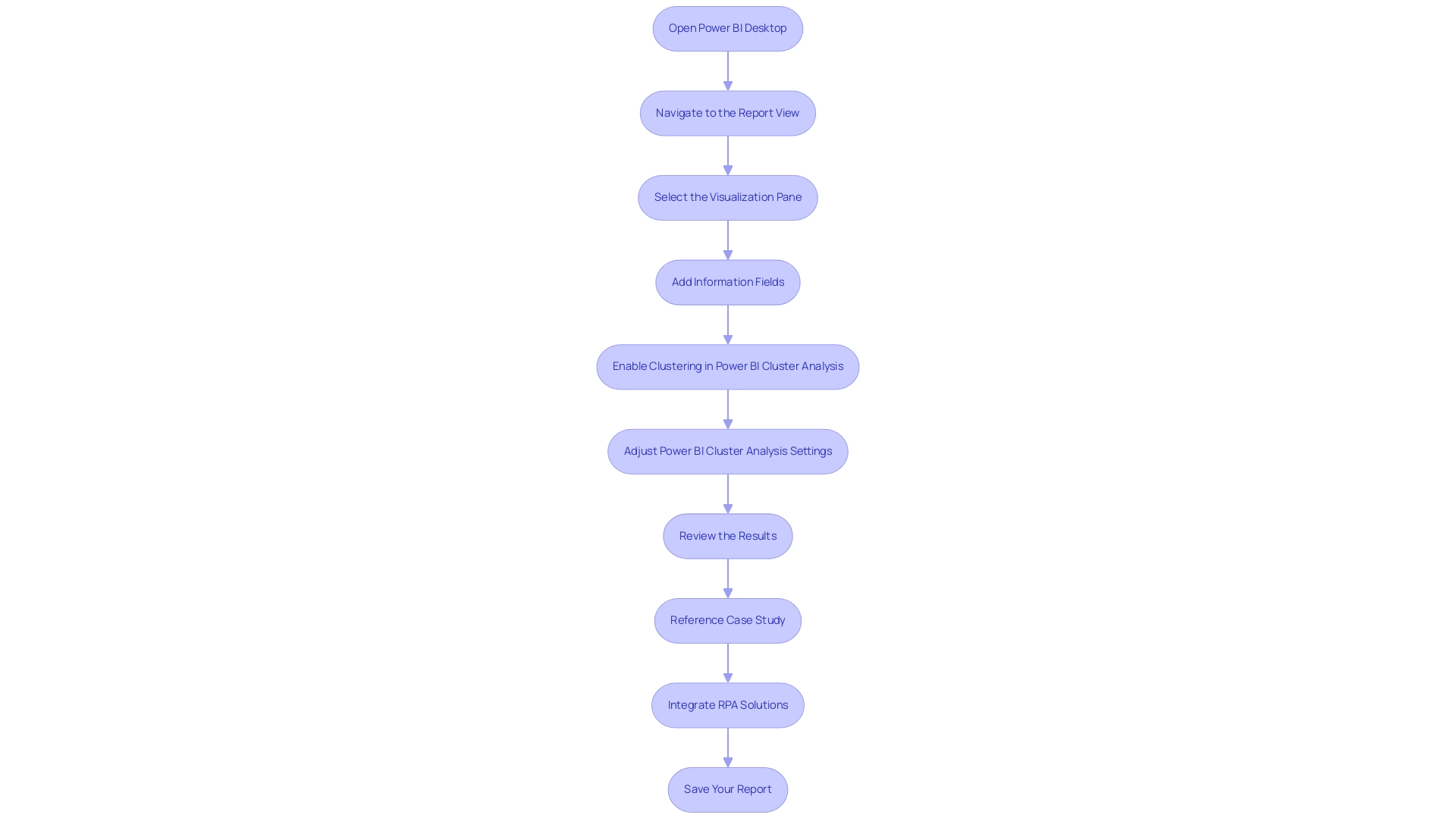
Exploring Clustering Methods in Power BI
Power BI presents a diverse array of clustering methods tailored to meet various analytical needs, playing a crucial role in enhancing Business Intelligence:
- K-Means Clustering: This widely-used method excels in partitioning larger datasets into K distinct clusters based on distance metrics. Its flexibility enables users to specify the number of clusters, making it especially effective for situations where rapid understanding is required. As companies aim to utilize insights based on information for expansion, recent trends indicate an increasing number of publications addressing K-Means grouping, highlighting its lasting significance in information analysis.
The effectiveness of K-Means can be validated using metrics such as the Adjusted Rand index and normalized mutual information, essential for external validation of grouping results.
- Hierarchical Clustering: This technique constructs a dendrogram or tree of clusters, offering a nuanced view of the relationships within the information. It is especially beneficial for smaller datasets where the complexity of relationships warrants a detailed examination.
Expert insights emphasize hierarchical grouping’s benefit in uncovering complex structures that may not be evident through alternative techniques. Tripti Jain, a Business Analyst at Paytm, observes that preparing data for grouping in the context of Power BI cluster analysis involves key steps such as using Power Query Editor to clean data, addressing missing values and inconsistencies, transforming categorical variables into numerical ones, and aggregating data for different analysis levels.
- DBSCAN (Density-Based Spatial Clustering of Applications with Noise): DBSCAN stands out for its ability to identify clusters of varying shapes and sizes, making it a robust choice when the dataset contains noise.
This method is particularly advantageous when traditional grouping techniques may falter, effectively distinguishing between dense regions and noise.
- Python Integration: For those seeking advanced analytical capabilities, Power BI’s integration with Python allows users to utilize additional grouping libraries, such as Scikit-learn. This feature allows the implementation of personalized grouping methods, serving users who need more tailored solutions for their analysis requirements.
Alongside these grouping techniques, the integration of RPA solutions such as EMMA RPA and Power Automate can significantly enhance operational efficiency. These tools automate repetitive tasks, addressing issues such as time-consuming report creation and inconsistencies, thereby allowing teams to concentrate on strategic decision-making. Understanding and utilizing these grouping methods alongside RPA empowers operations efficiency directors to harness the full potential of Power BI cluster analysis.
This, in turn, enables information-driven decision-making that addresses the challenges of time-consuming report creation and inconsistencies, ultimately fostering business growth and innovation.
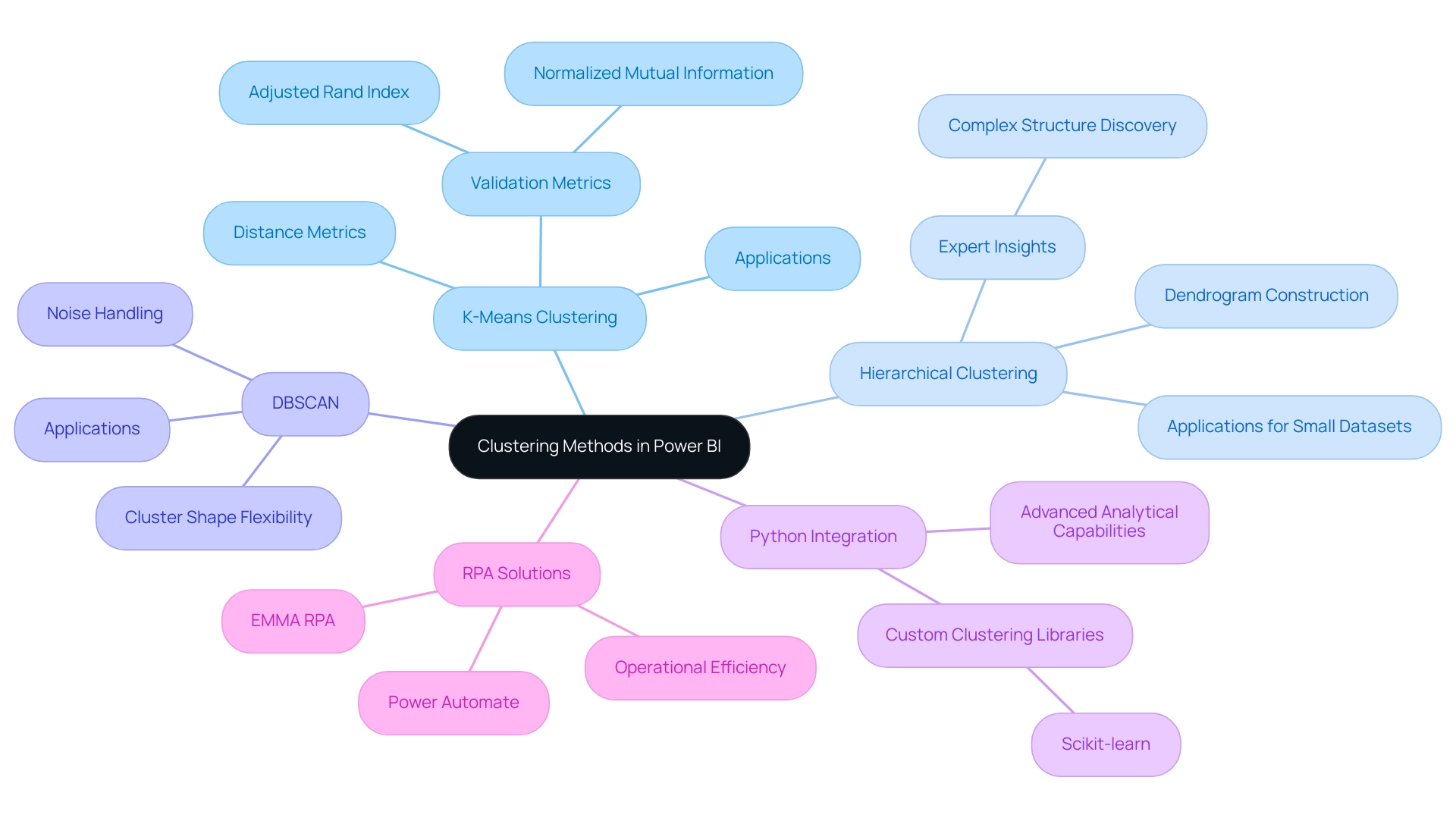
Preparing Your Data for Effective Clustering
To organize your information for effective grouping and improve operational efficiency, follow these essential steps:
-
Data Cleaning: Start by removing duplicates, addressing missing values, and correcting inconsistencies. Clean information is essential, resulting in more precise grouping outcomes. Techniques such as fuzzy matching, provided by the fuzzywuzzy library, are useful for identifying and removing near-duplicates, further enhancing the quality of information. Recent studies emphasize that efficient information preparation can greatly enhance grouping precision, making it a crucial initial step in addressing technology implementation difficulties.
-
Feature Selection: Identify and select relevant features that contribute to meaningful grouping outcomes. Features that do not add value can obscure important patterns, ultimately leading to misleading results. As Lokesh B. emphasizes,
By scaling features to have similar scales (e.g., mean 0, standard deviation 1 for standardization), you prevent features with wider ranges from dominating distance calculations. This guarantees an equitable comparison of information and improves cluster formation, essential for fostering insights based on information.
-
Normalization: Scale your data to ensure that all features contribute equally to the grouping process. This is particularly vital for distance-based methods, such as K-Means, where the relative scale of features can dramatically influence results.
-
Exploratory Data Analysis (EDA): Conduct EDA to gain insights into your dataset’s distribution and relationships. Visualizations can reveal hidden patterns and guide your feature selection process, ensuring a more informed approach that aligns with your business goals.
-
Define Objectives: Clearly outline your clustering objectives. Comprehending what you intend to accomplish will guide your preparation and analysis, aligning your efforts with your overall business strategy. Implementing strategies that leverage RPA to automate manual workflows enhances efficiency and allows your team to focus on strategic initiatives. Additionally, addressing quality challenges through RPA can help mitigate barriers to AI adoption, ensuring that your information is not only clean but also actionable. The swift expansion of machine learning highlights the significance of power bi cluster analysis in enhancing business understanding and operational effectiveness. Furthermore, leveraging Business Intelligence tools like power bi cluster analysis can transform your cleaned information into actionable insights, enabling informed decision-making that drives growth and innovation.

Best Practices for Successful Cluster Analysis
To achieve successful cluster analysis, consider implementing the following best practices to tackle challenges related to data quality and enhance your AI adoption journey:
-
Iterate and Refine: Embrace the iterative nature of clustering. Experiment with various methods and parameters to identify the optimal fit for your dataset, thereby enhancing the quality of your clusters and addressing inconsistencies that may arise from poor master information quality, such as incomplete or flawed entries.
-
Use PCA for Enhanced Clarity: Implement Principal Component Analysis (PCA) to improve cluster quality by ensuring that the variables are meaningful and less redundant. This approach leads to better-defined clusters, facilitating clearer insights from your data, which is crucial for effective decision-making.
-
Power BI Cluster Analysis Visualization: Visualization is essential for evaluating the clarity of your grouping results. Employ scatter plots and decomposition trees to observe the distinctiveness of your clusters, enabling you to make informed adjustments as needed and mitigate the challenges of time-consuming report creation in Power BI dashboards.
-
Evaluate Results: Implement robust metrics such as silhouette scores and the Davies-Bouldin index to assess performance of groupings. These metrics offer valuable insights into the appropriateness and effectiveness of your grouping solutions. For instance, an adjusted Rand index of 1 indicates a perfect match in grouping, while a value of 0 suggests chance performance. Moreover, the gap statistic serves as a powerful tool, comparing within-cluster dispersion to expected dispersion, guiding you toward the optimal number of clusters and aiding in avoiding both underfitting and overfitting.
-
Stay Updated: The landscape of data evaluation and AI is ever-evolving. Regularly update your knowledge on new grouping techniques and enhancements in power bi cluster analysis to expand your analytical capabilities and improve your grouping strategies. This ongoing learning is essential to address your uncertainty about integrating AI and to counter the common perception that AI projects are time-intensive and costly.
-
Collaborate and Share Insights: Foster a collaborative environment by working with your team to share findings and insights derived from your clustering evaluation. As highlighted by data expert Say, “You could run a few algorithms for determining the best number of clusters and see how your Gaussian model compares.” A consensus on a number of clusters is an indication of strong differentiation in the dataset. Such collaboration will not only enhance your understanding but also facilitate more effective decision-making based on your analysis, guiding you toward overcoming the perceived barriers to AI adoption.
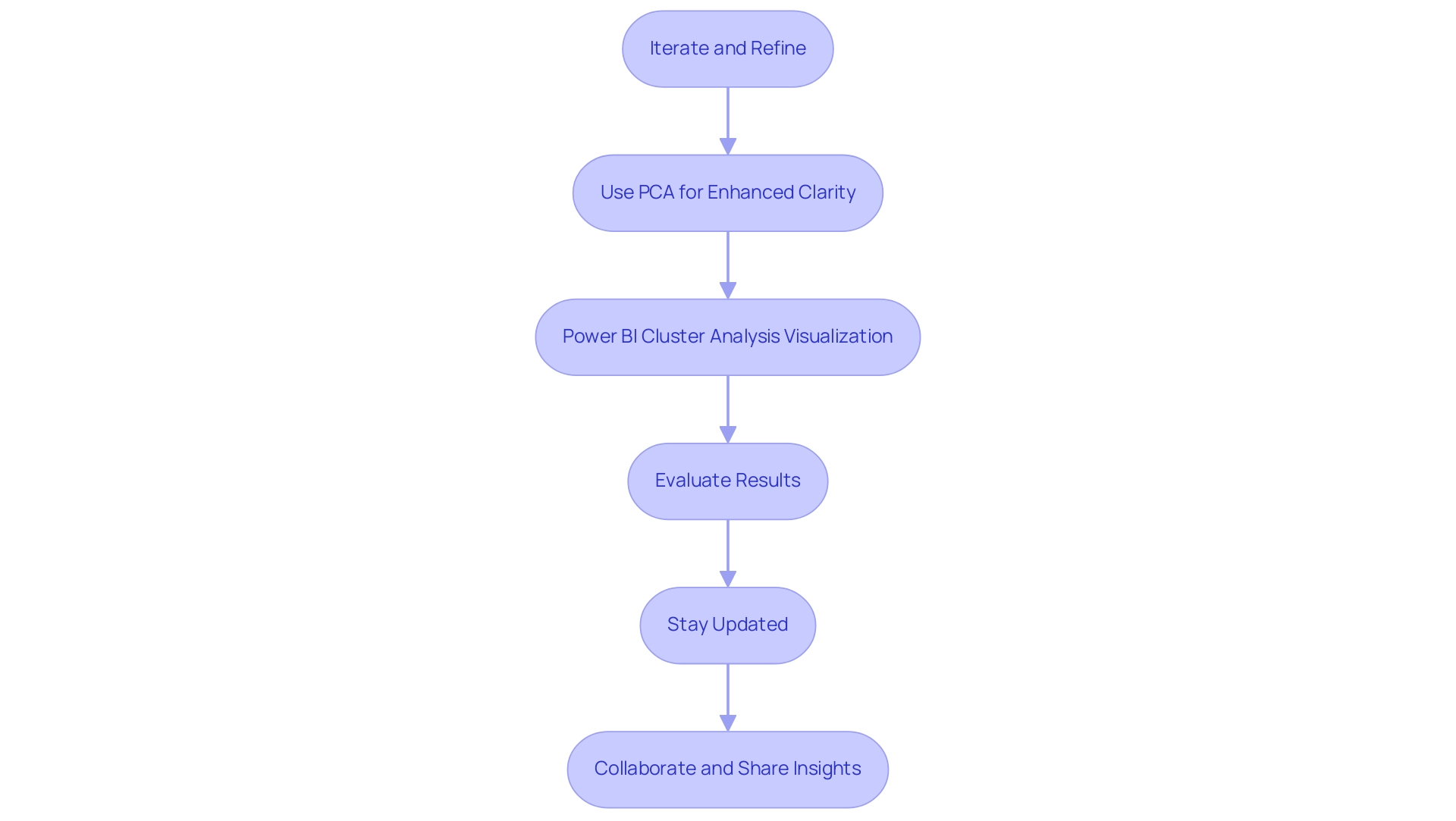
Conclusion
Harnessing the power of clustering techniques in Power BI is essential for organizations looking to unlock the full potential of their data. By utilizing methods such as:
- K-Means
- Hierarchical Clustering
- DBSCAN
businesses can reveal hidden patterns and relationships that drive informed decision-making. The step-by-step guide provided illustrates how to effectively implement cluster analysis, enabling teams to visualize and interpret data with greater clarity.
Preparing data for clustering is equally critical, with best practices emphasizing the importance of:
- Data cleaning
- Feature selection
- Normalization
These foundational steps ensure that the insights derived from clustering are both accurate and actionable. Moreover, incorporating advanced techniques like Principal Component Analysis (PCA) and leveraging automation through RPA can significantly enhance operational efficiency and streamline processes.
Ultimately, the effective use of clustering in Power BI not only aids in data interpretation but also empowers organizations to make strategic decisions that foster growth and innovation. By embracing these practices and staying updated with evolving techniques, decision-makers can drive their organizations toward a future where data-driven insights are at the forefront of operational success.
Overview:
To connect Power BI to Databricks, users must ensure they have an active account, the latest version of Power BI Desktop, a configured cluster, appropriate access permissions, and the correct connection string. The article provides a detailed step-by-step guide that outlines the necessary prerequisites and procedures, emphasizing the importance of using Direct Query mode for real-time data access and recommending best practices for optimizing the integration process.
Introduction
In the dynamic landscape of data analytics, the ability to connect Power BI with Databricks is a game-changer for organizations seeking to enhance their operational efficiency and data-driven decision-making. This integration not only streamlines reporting processes but also empowers teams with real-time insights and robust data visualization capabilities.
As businesses navigate the complexities of data management, understanding the prerequisites, best practices, and troubleshooting techniques becomes essential. This article serves as a comprehensive guide, providing practical steps and strategies to ensure a seamless connection between Power BI and Databricks, ultimately driving innovation and growth in an increasingly competitive environment.
Getting Started: Prerequisites for Connecting Power BI to Databricks
To effectively establish a connection between Power BI and Databricks, and to fully leverage Business Intelligence and RPA for operational efficiency, it is essential to fulfill the following prerequisites:
- Active Account: Confirm that you have an active account. If you are new, consider signing up for a trial to explore the capabilities that can enhance your data-driven insights.
- Latest Version of Power BI Desktop: Download and install the latest version of Power BI Desktop from the Microsoft website to ensure compatibility and access to new features designed for efficiency.
- Configured Cluster: Set up and ensure that a cluster is operational. This cluster is critical for executing your queries efficiently, with the ability to add a compute cluster in as little as 5 minutes, thus improving your operational workflows.
- Appropriate Access Permissions: Verify that you possess the necessary permissions to access both the workspace and the specific data you plan to analyze, addressing any potential data inconsistencies.
- Connection String: Obtain the connection details for your instance, which is essential for establishing the link during configuration.
Understanding the connection modes is crucial as well. As Albert Wang noted, “Shared-no-isolation mode does not support unity catalog,” which is vital to consider when setting up your integration.
For a practical example, consider the case study titled “Power BI connect to Databricks,” which illustrates how users can connect Power BI to Azure Databricks clusters and SQL warehouses. This integration not only allows users to publish reports to the BI service but also enables single sign-on (SSO) using Microsoft Entra ID credentials, streamlining the reporting process and providing actionable guidance.
It’s important to recognize the challenges of data extraction and how RPA solutions can mitigate these issues, such as task repetition fatigue and outdated systems. Lastly, it’s advantageous to examine the comparison available for selecting between the Azure Connector and the Connector for Business Intelligence, as this can assist you in making informed choices about your integration strategy. By addressing these prerequisites, you can streamline the connection process and mitigate common issues, paving the way for a seamless integration experience that drives growth and innovation.
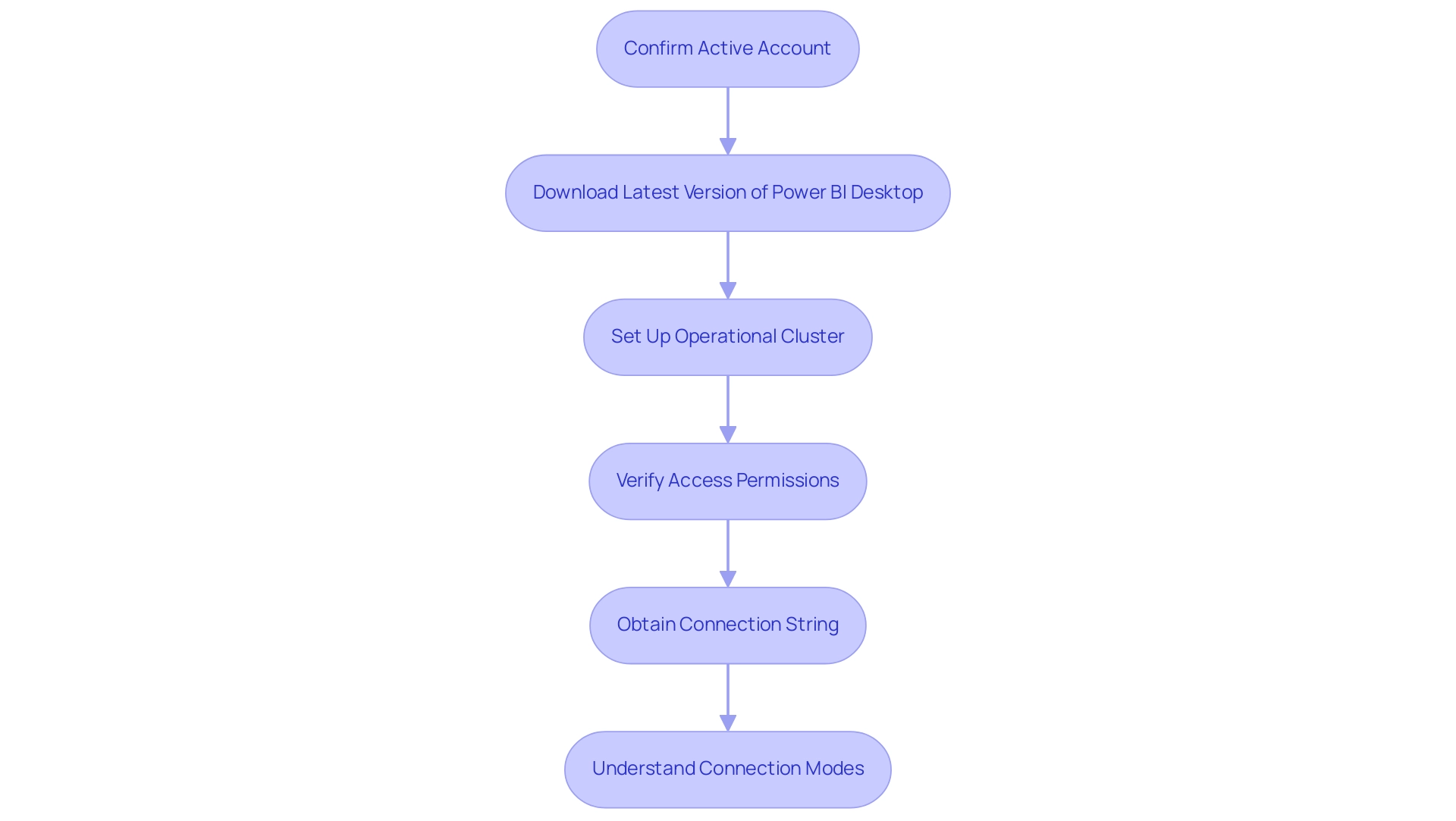
Step-by-Step Guide to Establishing the Connection
To seamlessly connect the business intelligence tool to the data platform and enhance your data analytics capabilities while leveraging Robotic Process Automation (RPA) for operational efficiency, follow these steps:
- Open Power BI Desktop: Start by launching the application on your device.
- Get Data: Navigate to the ‘Home’ tab and select ‘Get Data’. Click on ‘More…’ to access the expanded Get Data window.
- Select the platform: In the search bar of the Get Data window, type ‘the platform name’, choose it from the list, and click ‘Connect’.
- Enter Connection Information: You will be prompted to provide the necessary connection details:
- Server Hostname: Enter the server hostname associated with your Databricks account.
- HTTP Path: Input the HTTP path corresponding to your Databricks cluster.
- Authentication: Choose the authentication method that suits your setup (typically, the Token method is recommended) and input your access token for secure access.
- Load Information: Once connected, select the tables or datasets you wish to import into BI and click ‘Load’.
It’s important to note that the connector limits the number of imported rows to the Row Limit that was set earlier, which is a crucial operational constraint to consider during your information import process.
By integrating RPA into this workflow, you can automate repetitive information import tasks, significantly reducing the time spent on manual handling and minimizing the risk of errors. For example, RPA can be employed to arrange routine information imports or oversee information flows, guaranteeing that your analytics are consistently founded on the most up-to-date details.
By adhering to these steps, you will enable Power BI to connect to Databricks and create a strong link between BI and the database platform. This integration not only streamlines your analytics workflow but also improves security and access management, especially with the incorporation of a cloud platform on AWS with Business Intelligence through SSO using Microsoft Entra ID. This advancement allows your team to focus on deriving insights rather than managing governance, ultimately driving insights and operational efficiency through the power of automation.
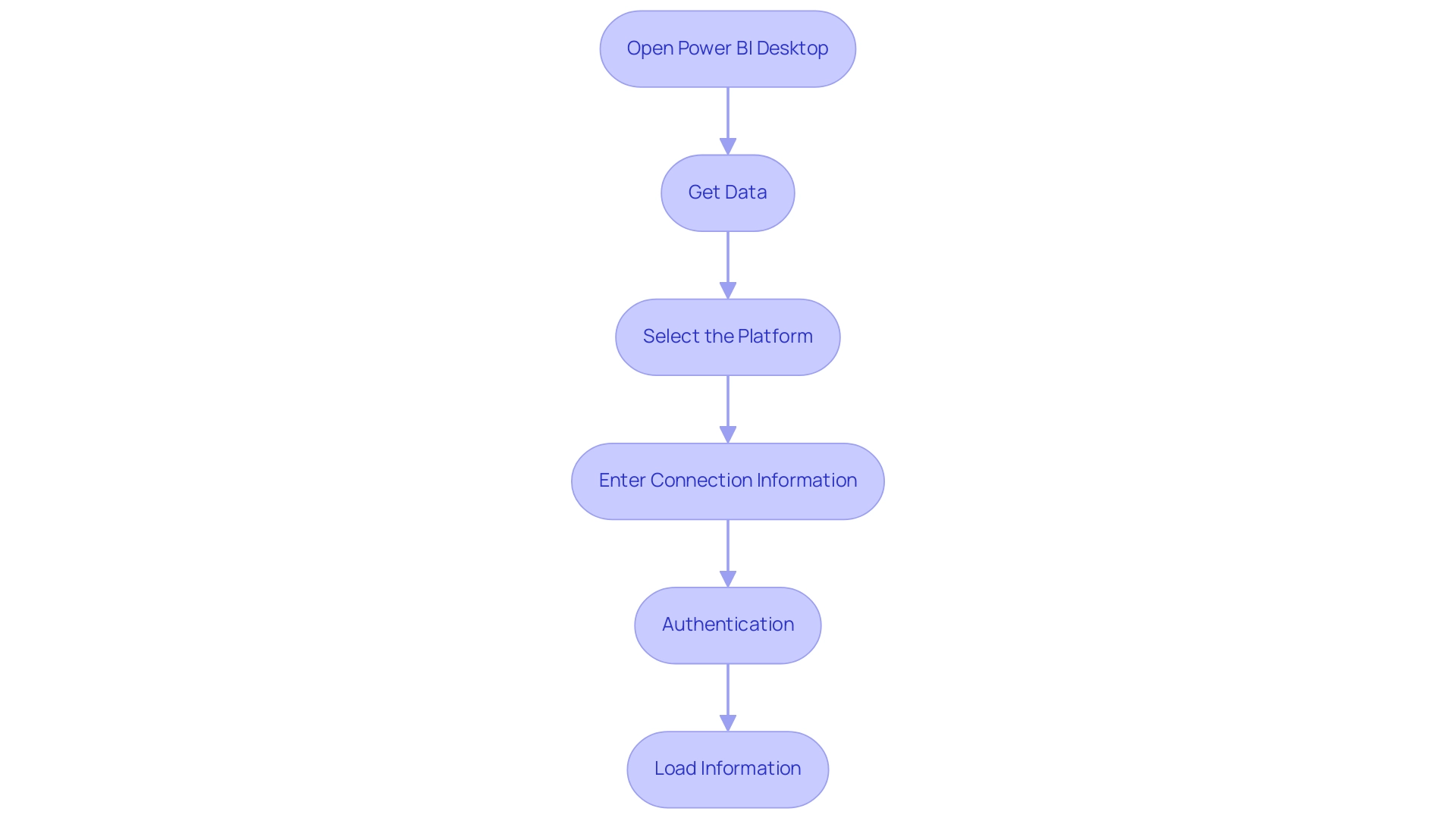
Best Practices for Optimizing Power BI and Databricks Integration
To achieve optimal integration of Power BI with Databricks, consider the following best practices that can significantly enhance your workflow and address common challenges:
-
Utilize Direct Query Mode: Whenever possible, use Direct Query to enable real-time access to information without the necessity of importing large datasets into BI. This approach not only streamlines operations but also ensures that your reports reflect the most current information. Notably, when using the integration of Power BI connect to Databricks, datasets can be published in as little as 10 to 20 seconds, showcasing the efficiency of this platform.
-
Limit Imports: Focus on importing only the essential information required for your analyses. This practice improves performance and minimizes load times, leading to a smoother user experience, thereby mitigating the time-consuming report creation challenges.
-
Optimize Queries: Craft efficient queries within the platform to reduce processing time and conserve resources. Well-structured queries can dramatically enhance the performance of your reports, addressing the issue of inconsistencies.
-
Utilize Dataflows: Harness the capabilities of BI dataflows to preprocess your information in the analytics platform before visualization. This step not only simplifies the reporting process but also enhances information management, facilitating more actionable guidance for decision-making.
-
Monitor Performance Metrics: Regularly evaluate the performance indicators in both BI tools to identify any potential bottlenecks. Continuous monitoring allows for timely interventions, ensuring optimal performance.
-
Integrate RPA Solutions: Consider leveraging Robotic Process Automation (RPA) to streamline tasks related to information management and reporting. RPA can automate repetitive processes, reducing manual errors and freeing up your team to focus on strategic analysis and decision-making.
Applying these best practices will not only improve the efficiency of your business intelligence and data integration but also enable Power BI to connect to Databricks, contributing to a more agile and responsive data environment. As noted by esteemed contributor Szymon Dybczak, “strategic approaches to query performance can yield significant improvements,” making it essential to adopt these methodologies in your everyday operations. Additionally, as organizations transition from traditional methods to digital solutions, the emphasis on strategic planning becomes crucial in maximizing the benefits of digital adoption.
This integration ultimately supports the drive for data-driven insights that are vital for informed decision-making.
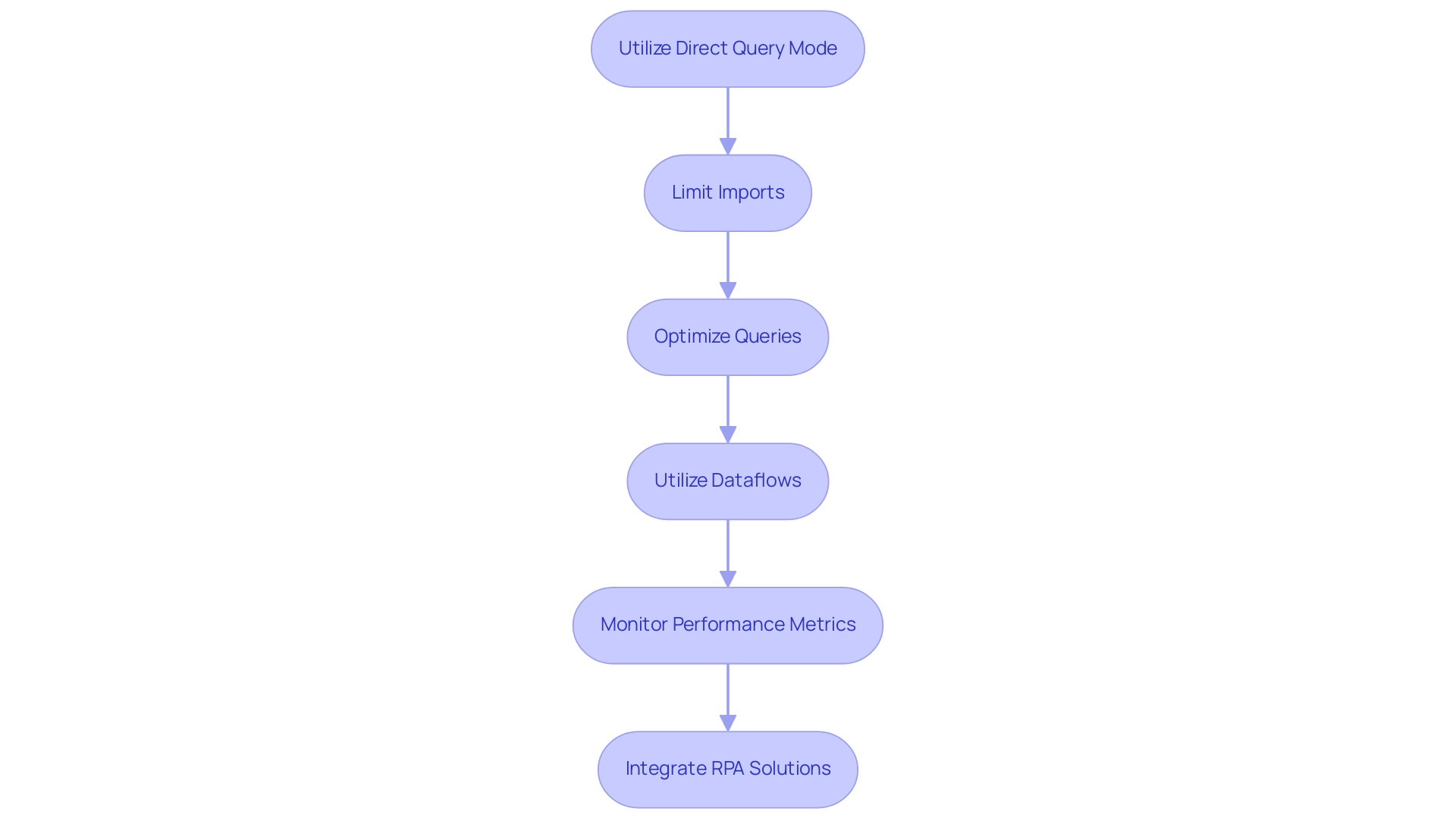
Troubleshooting Common Connection Issues
When linking the business intelligence tool to the data platform, experiencing problems can be irritating, particularly when your emphasis is on improving operational efficiency through informed decision-making. Applying these troubleshooting tips, together with Robotic Process Automation (RPA) and customized AI solutions, can assist you in resolving frequent issues while enhancing your reporting processes:
- Check Network Link: A stable internet link is essential for ensuring that Power BI can connect to Databricks seamlessly. Ensure your network is functioning optimally to avoid time-consuming disruptions.
- Verify Credentials: Double-check that you’re entering the correct server hostname, HTTP path, and authentication token. A small error can lead to connection failures. Note that a personal access token with a lifetime of 7 is required for BI authentication.
- Cluster Status: Confirm that your cluster is actively running; if it’s stopped or terminated, restart it to establish a fresh connection.
- Firewall Settings: Ensure your firewall configurations allow Power BI to connect to Databricks. Adjust your firewall configurations if necessary to enable this communication.
- Review Error Messages: Pay close attention to any error messages during your connection attempt, as they can provide valuable insights into the underlying issues.
Additionally, integrating RPA can automate the monitoring of these connections, allowing your team to focus on strategic tasks rather than troubleshooting. Recent guidance from community support, such as Liu Yang, emphasizes the importance of updating BI Desktop. Users experiencing frozen issues should consider uninstalling and reinstalling BI Desktop, especially since Microsoft’s engineers are currently addressing known issues with the application. You can download the latest version directly from the official Microsoft Download Center to ensure optimal performance. For those still facing challenges, a workaround involves navigating to File > Options and Settings > Options > Preview features to untick ‘Power BI Desktop infrastructure update.’ Alternatively, setting ‘Load Tables simultaneously’ and clearing the cache in BI Desktop can also enhance stability. A user successfully resolved their issues by uninstalling BI Desktop and installing a previous version, which serves as a potential solution for others experiencing similar problems with the latest updates. By adhering to these troubleshooting steps and considering RPA and AI solutions, you can effectively resolve common connection issues and understand how to power bi connect to databricks, successfully integrating your business intelligence tools with the data platform, ultimately enhancing your operational efficiency and driving better business outcomes.
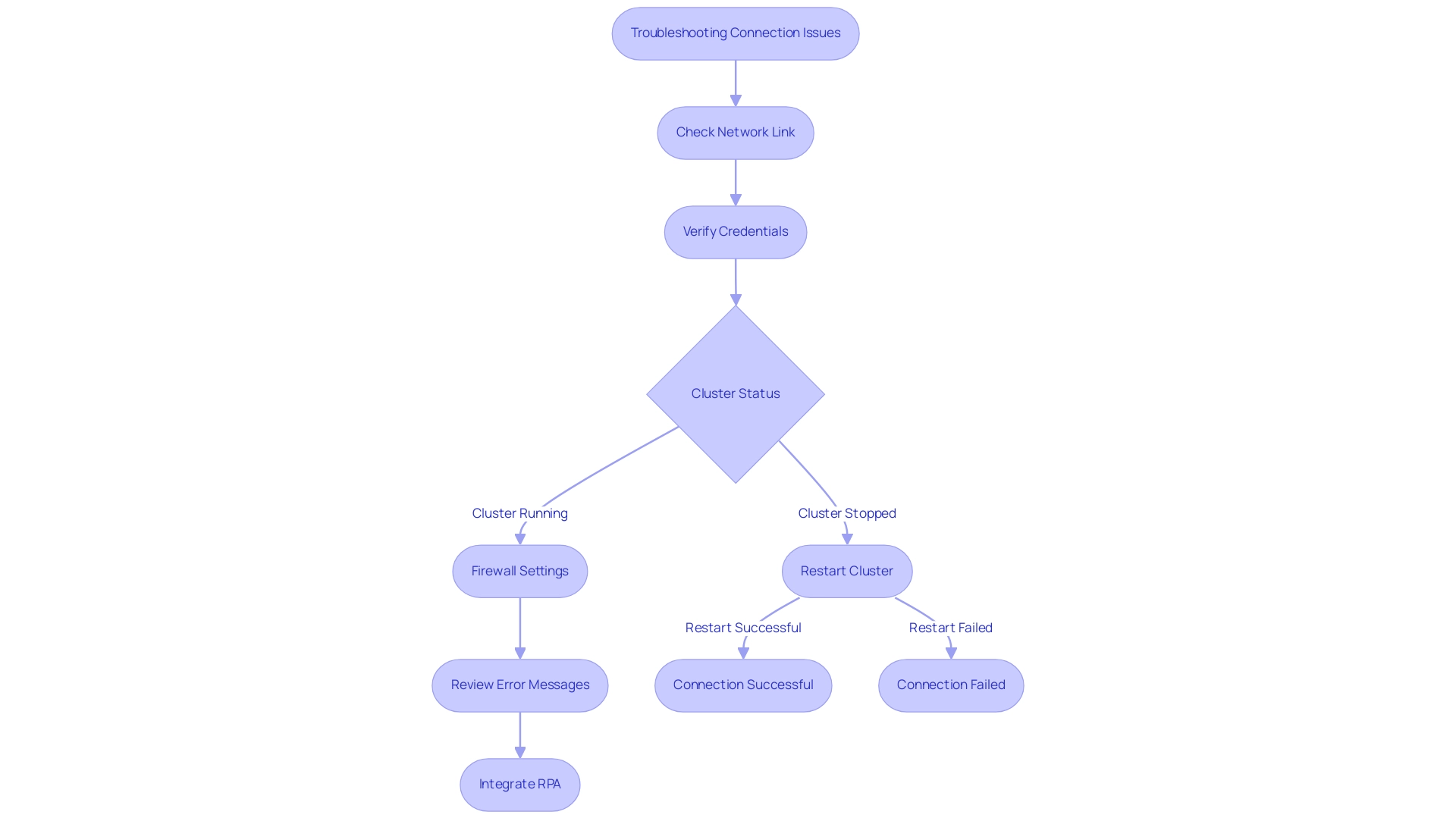
Benefits of Connecting Power BI to Databricks
Combining the BI tool with Azure unlocks a multitude of benefits that can significantly enhance your organization’s analytics capabilities, addressing the common challenges faced in leveraging insights from dashboards:
- Enhanced Data Visualization: Users can leverage Power BI connect to Databricks to excel in visualization capabilities, creating compelling representations of complex datasets. This visual clarity aids in interpreting information quickly and efficiently, overcoming issues related to inconsistencies.
- Real-Time Insights: The integration facilitates access to real-time information, empowering stakeholders to make timely decisions based on the most current details available. This immediacy is crucial in today’s fast-paced business environment, helping you navigate the challenges of time-consuming report creation.
- Streamlined Reporting: By combining the strengths of both tools, reporting processes become more straightforward. This synergy enables efficient information analysis, reducing the time spent on compiling reports and increasing focus on actionable insights.
- Enhanced Collaboration: With combined information sources, teams can work together more effectively, sharing insights and analyses seamlessly. This fosters a culture of data-driven decision-making throughout the organization, essential for driving growth and innovation.
- Scalability: The integration supports scalable information solutions, ensuring that as your organization grows, your analytics capabilities can expand without compromise. Azure Data Lake Storage Gen2 exemplifies this scalability, offering a cost-effective solution for storing unstructured and semi-structured information, thus facilitating self-service queries without predefined schemas. Incorporating RPA solutions alongside Power BI connect to Databricks can further enhance operational efficiency. RPA can automate repetitive tasks involved in information collection and reporting, allowing teams to concentrate on analysis and decision-making.
By harnessing these advantages, organizations can maximize their analytics efforts, ultimately driving improved business outcomes. Notably, starter warehouses are now serverless by default, further enhancing the efficiency of this integration and allowing for a more streamlined approach to data management. Additionally, the billing system tables will remain available at no additional cost across clouds, including one year of free retention, ensuring a cost-effective pathway to enhanced analytics.
As you prepare for the integration, consider reaching out to your Databricks account team for information on participating in private or gated public previews, which can provide early access to new features and functionalities.
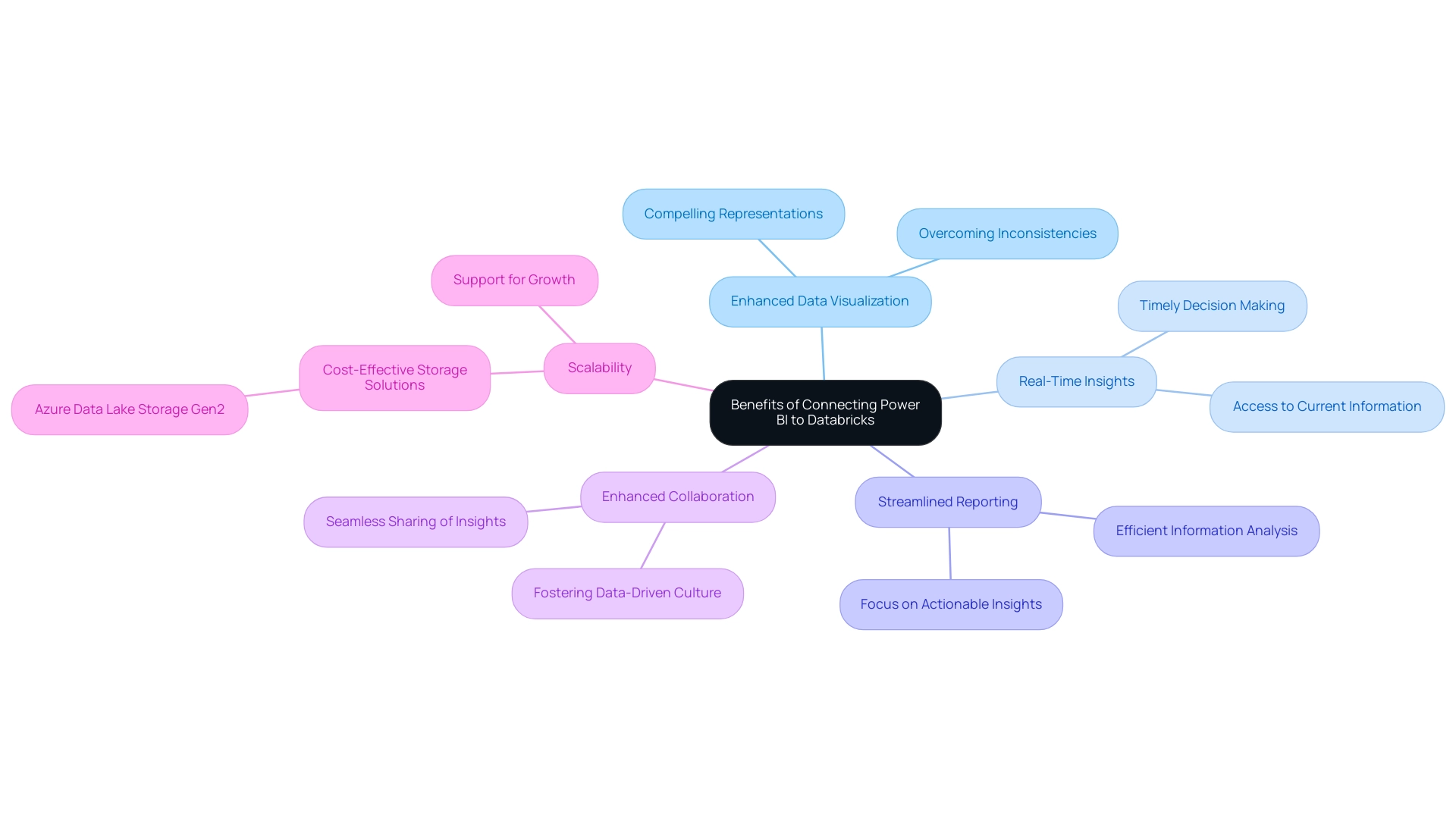
Conclusion
Connecting Power BI with Databricks offers significant advantages that can transform an organization’s approach to data analytics. By ensuring that the prerequisites are met, such as having an active Databricks account and the latest version of Power BI, teams can establish a seamless connection that not only enhances data visualization but also supports real-time insights. This foundation allows organizations to navigate the complexities of data management with confidence.
Implementing best practices, like leveraging Direct Query mode and optimizing queries, further enhances the integration, enabling teams to work more efficiently and effectively. Regularly monitoring performance metrics and troubleshooting common issues ensures that the connection remains robust, allowing for uninterrupted access to critical data. The integration of Robotic Process Automation (RPA) also streamlines repetitive tasks, freeing up valuable time for strategic analysis.
Ultimately, the combination of Power BI and Databricks not only improves operational efficiency but also fosters a culture of collaboration and data-driven decision-making. By embracing this integration, organizations can unlock the full potential of their data, driving innovation and growth in an increasingly competitive landscape. The time to enhance data analytics capabilities is now, and the pathway is clear: connect, optimize, and thrive.
Overview:
To create Power BI conditional columns that effectively handle null values, users should follow a step-by-step process that includes defining conditions using DAX functions to ensure data integrity and improve analysis. The article supports this by detailing the importance of addressing null values, highlighting their potential to distort insights, and providing practical steps to create conditional columns that enhance operational efficiency and decision-making.
Introduction
In the dynamic landscape of data analysis, leveraging conditional columns in Power BI emerges as a game-changing strategy for organizations striving to enhance operational efficiency. These powerful tools allow users to transform raw data into actionable insights by categorizing and managing information effectively, particularly when dealing with the pervasive issue of null values.
As data integrity becomes increasingly vital in decision-making, understanding how to implement these conditional columns can significantly improve data workflows and analysis accuracy. With the right techniques, organizations can not only mitigate the challenges posed by incomplete data but also harness the full potential of their data assets, paving the way for informed strategies and sustained growth in a competitive environment.
This article delves into the practical applications of conditional columns, offering step-by-step guidance and best practices to empower teams in their data management journey.
Understanding Conditional Columns in Power BI
Conditional columns in Power BI are a crucial tool that enables users to extract new insights from existing information through specified rules. For instance, categorizing sales figures into ‘High’, ‘Medium’, or ‘Low’ based on defined thresholds enhances interpretability and directly addresses challenges like missing or null values, which is essential for ensuring the accuracy of a Power BI conditional column null. This functionality is crucial for Directors of Operations Efficiency seeking to enhance information accuracy and reliability.
To create these conditional fields, simply navigate to the ‘Modeling’ tab within the Power BI interface, where intuitive options await. Mastering this feature is not merely a technical skill—it represents a strategic advantage in your analytics toolkit. With 54% of companies prioritizing cloud computing and business intelligence to enhance their information strategies, the adept use of conditional fields can assist organizations in leveraging their resources more efficiently.
Furthermore, as the quantity of IoT devices is expected to rise to 20.3 billion by 2025, generating vast streams of information, robust management strategies, including conditional columns, become essential for extracting actionable insights. The worldwide big information analytics market, valued at $271.83 billion in 2022, highlights the increasing demand for skilled analysis. Our 3-Day BI Sprint can expedite your mastery of these essential features, while the General Management App offers comprehensive management tools to enhance operational efficiency.
As we investigate effective methods for handling null entries, understanding how to utilize power bi conditional column null will be crucial for optimizing workflows and improving operational efficiency, tackling the issues of inconsistencies and absence of actionable guidance.
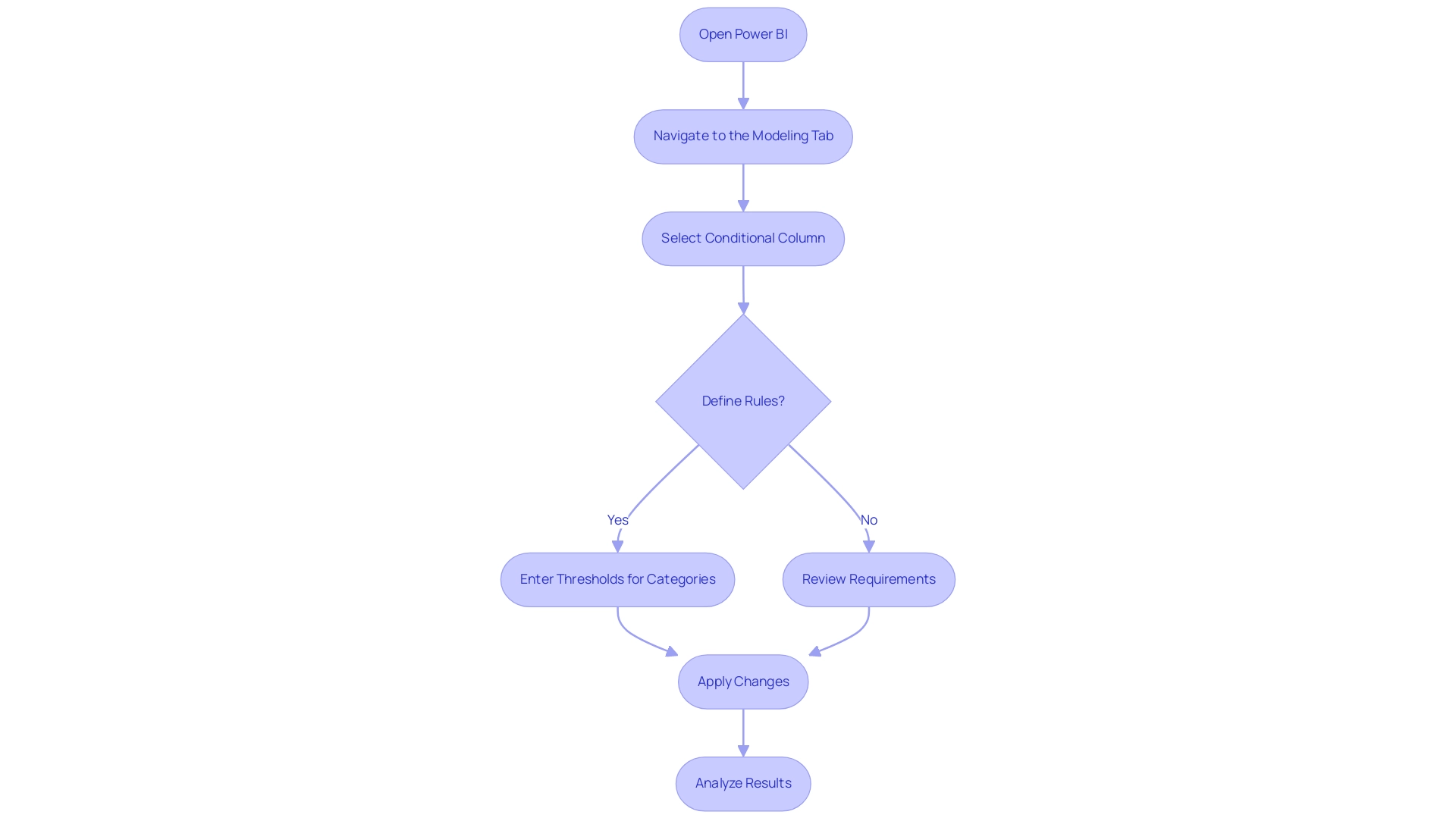
Challenges of Handling Null Values in Power BI
Null entries in Power BI can significantly distort analysis, leading to misleading insights and incorrect conclusions. In today’s information-rich environment, where approximately 30% of datasets contain null values, understanding the implications of these gaps is crucial for effective management. These common challenges include:
- Difficulties in aggregation
- Inaccuracies in calculations
- Complications in visualization
For instance, a null sales figure can skew average calculations or result in incomplete reports, ultimately hindering decision-making. By unlocking the power of Business Intelligence, you can transform raw data into actionable insights that drive growth and innovation. Using Power Query, examine your dataset to find fields with null entries, enabling focused remediation.
Recognizing these challenges underscores the importance of creating a Power BI conditional column null that adeptly manages nulls. Furthermore, a novel method is to handle absent entries as a machine learning challenge, where a portion of the initial information is employed to forecast these omissions. This method not only tackles the challenge of managing null entries but also improves the dataset’s completeness, although it may diminish the overall effectiveness of your analysis, requiring a careful assessment of your results.
As the Statsig Team aptly states,
Interpreting results requires understanding what the numbers represent,
reinforcing the critical need for transparency about analysis limitations. Incorporating RPA solutions like EMMA RPA and Power Automate can streamline the process of managing null values, automating cleansing and enhancing operational efficiency. By recognizing and tackling these common issues, you enhance your analysis processes to produce more dependable and actionable insights, ultimately boosting operational efficiency and informed decision-making.
In a competitive landscape, failing to extract meaningful insights from your information can leave your business at a disadvantage, making it imperative to tackle these challenges head-on.

Step-by-Step Guide to Creating Conditional Columns for Null Values
To create conditional columns that effectively handle null values in Power BI and mitigate challenges like time-consuming report creation and data inconsistencies, follow this comprehensive step-by-step guide:
- Open Power BI Desktop and load your data model to begin the process.
- Navigate to the Modeling tab and select New Column to initiate the creation of a new column.
- In the formula bar, utilize the DAX function
IFto define your conditions. For instance:
DAX
new column = IF(ISBLANK([ExistingColumn]), "No Data", [ExistingColumn])
- This formula checks whether the content in
Existing Columnis blank (null). If it is, ‘No Information’ is assigned; otherwise, the original value is retained, ensuring that your information remains intact and actionable. - Press Enter to finalize the creation of the new section.
- Examine your newly created section in the information view to confirm that it functions as intended, ensuring precision in your analyses.
- Utilize this new column in your reports or for additional calculations as required to improve the quality of your insights.
By mastering these steps, you can effectively manage null values in a Power BI conditional column, which will lead to more accurate and meaningful analyses. This approach not only enhances your current analysis but also establishes a foundation for advanced strategies, including dynamic targets for KPIs in Power BI, customized through DAX formulas based on various conditions.
Moreover, a robust governance strategy is essential to prevent inconsistencies and ensure that your insights are reliable. Without such governance, businesses risk encountering a competitive disadvantage, as they may struggle to extract meaningful insights from their information, ultimately hindering informed decision-making. As emphasized in industry discussions, precise information handling is crucial for calculating profit margins, which are determined by dividing profit by total sales, underscoring the importance of maintaining integrity.
For further assistance, engage with the BI community for support, and consider exploring case studies like ‘How to Create a Dashboard on BI,’ which illustrates the practical application of these concepts by detailing the process of opening a report, editing it, pinning visualizations, and creating new dashboards tailored for sharing.
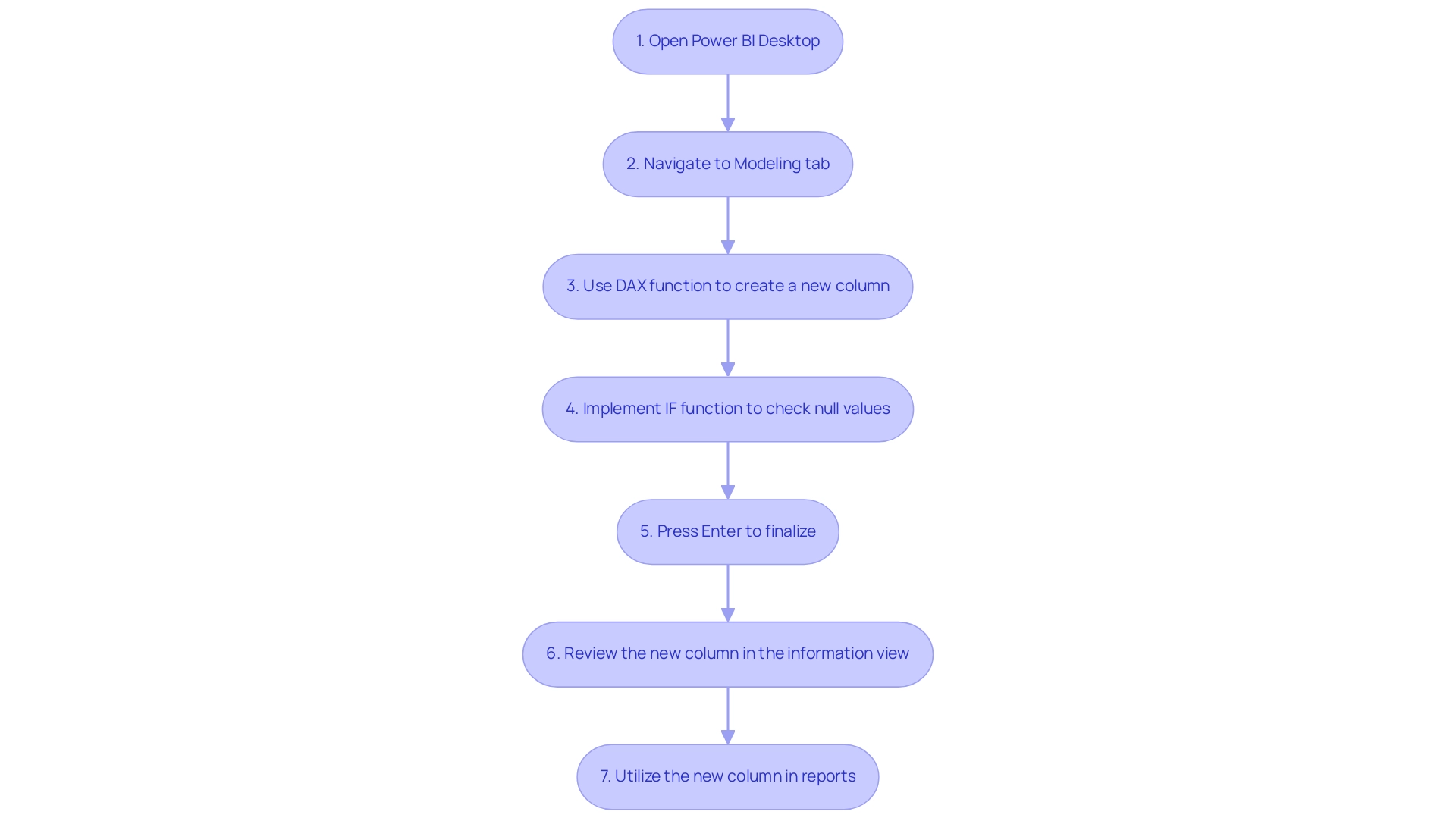
Best Practices for Managing Conditional Columns and Null Values
When handling Power BI conditional column null fields and addressing null values in Power BI, it’s essential to apply best practices that improve your information management capabilities while utilizing Robotic Process Automation (RPA) to optimize manual workflows. RPA can significantly reduce the time spent on repetitive tasks, allowing your team to focus on strategic initiatives. According to recent findings, switching to Delta Tables in Databricks has led to immediate improvements in query times, underscoring the impact of effective information management on performance.
Here are crucial strategies to consider:
- Always Validate Your Information: Before creating conditional sections, ensure that your information is clean and accurately reflects the insights you aim to derive. Precise information is the basis of efficient analysis, and RPA can assist in automating validation processes, tackling issues connected to inadequate master information.
- Use Descriptive Names: Assign descriptive titles to your new sections. This practice aids in quickly understanding their purpose, facilitating better collaboration and communication across your team.
- Document Your Logic: Maintain clear documentation on the logic applied in your conditional sections. This not only streamlines future updates but also assists in troubleshooting when issues arise, ensuring that your data-driven insights are actionable.
- Test with Sample Data: Before deploying your logic across larger datasets, test it with a small sample. This method enables you to confirm that your logic functions as anticipated, diminishing the likelihood of mistakes in your reports.
- Regularly Review Your Model: As your information evolves, it’s important to revisit your conditional columns to ensure they continue to meet your analytical needs. Ongoing observation and enhancement, potentially aided by RPA, are crucial for maximizing the benefit of your BI reports.
- Utilize Ongoing Observation: Establishing a system for ongoing observation, as emphasized in the case study on BI, guarantees alignment with business goals and promotes a culture of continual optimization. This is essential for conquering obstacles linked to inadequate master information quality and impediments to AI implementation.
- Utilize Power BI Conditional Column Null for Managing Null Entries: Power BI conditional column null can be employed to automate the identification and management of null entries in your datasets. For example, RPA tools can be set up to substitute empty entries with predefined defaults or to highlight records for examination, thereby improving information integrity and operational efficiency.
By following these practices and incorporating RPA where relevant, you can greatly enhance your information management skills, ensuring that your Power BI reports are not only precise but also insightful, thereby promoting informed decision-making within your organization.
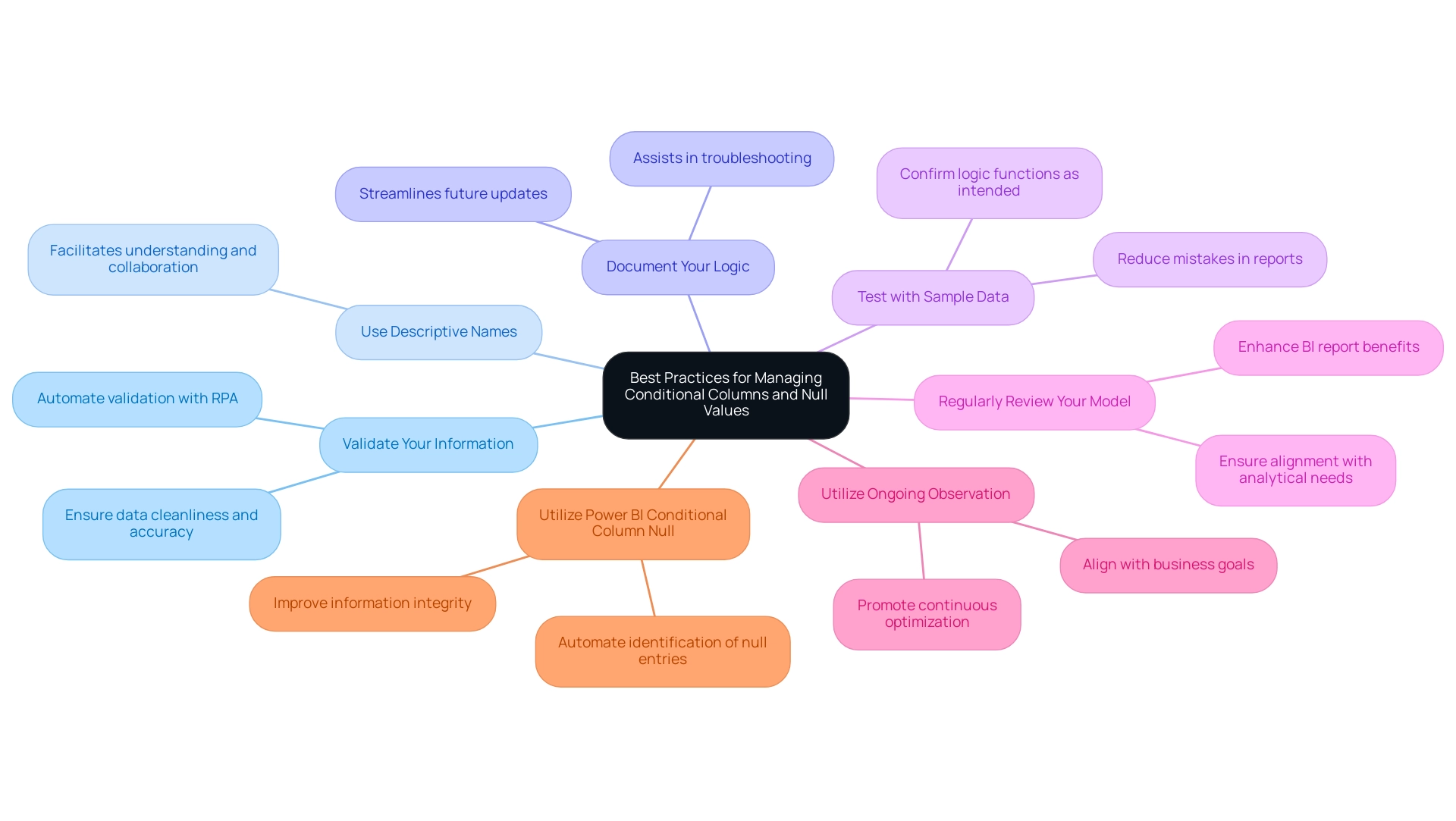
Real-World Applications of Conditional Columns in Power BI
Conditional fields are powerful tools that can significantly improve information operations across various sectors, especially when integrated with Robotic Process Automation (RPA) and Business Intelligence (BI) solutions. Here are several impactful applications:
-
Sales Analysis: A retail organization effectively utilizes conditional fields to categorize its sales information, designating entries with null values as ‘Pending’. This approach not only facilitates the tracking of incomplete transactions but also ensures that teams can swiftly address any issues, leading to a more streamlined sales process. By automating these workflows using RPA, the organization can further reduce manual oversight and enhance operational efficiency through the use of tools like the General Management App.
-
Customer Feedback: In the service industry, a company has harnessed the power of conditional data fields to analyze customer sentiment. By categorizing feedback into ‘Positive’, ‘Neutral’, or ‘Negative’, the organization gains valuable insights into customer perceptions and can respond appropriately to enhance satisfaction, even when some feedback entries are considered as power bi conditional column null. Incorporating RPA can streamline feedback classification, guaranteeing prompt reactions and enhanced customer interaction, in line with customized AI solutions that meet particular business requirements.
-
Financial Reporting: Financial institutions gain from Power BI conditional column null by marking absent information in expense reports. This proactive identification of discrepancies during audits simplifies the review process and enhances information integrity and compliance. Utilizing BI and RPA together can streamline reporting workflows, ensuring accurate insights with minimal manual intervention. The 3-Day BI Sprint can be especially impactful in swiftly generating these reports.
With more than 2000 satisfied clients, Hevo shows how useful conditional fields can be in optimizing operations. By implementing conditional columns effectively, organizations can transform their reporting capabilities. As mentioned by Joleen Bothma, a Data Science Consultant, the ability to customize visual elements in BI—such as using imported icons for conditional formatting—further enriches the data representation.
Notably, the case study titled ‘Changing Color Based on Value in Power BI‘ illustrates how users can click the function icon in the Data Colors section to set conditions and define color ranges based on field values. Ultimately, these strategies lead to improved decision-making and operational efficiency, positioning businesses for success in today’s rapidly evolving data-driven landscape.
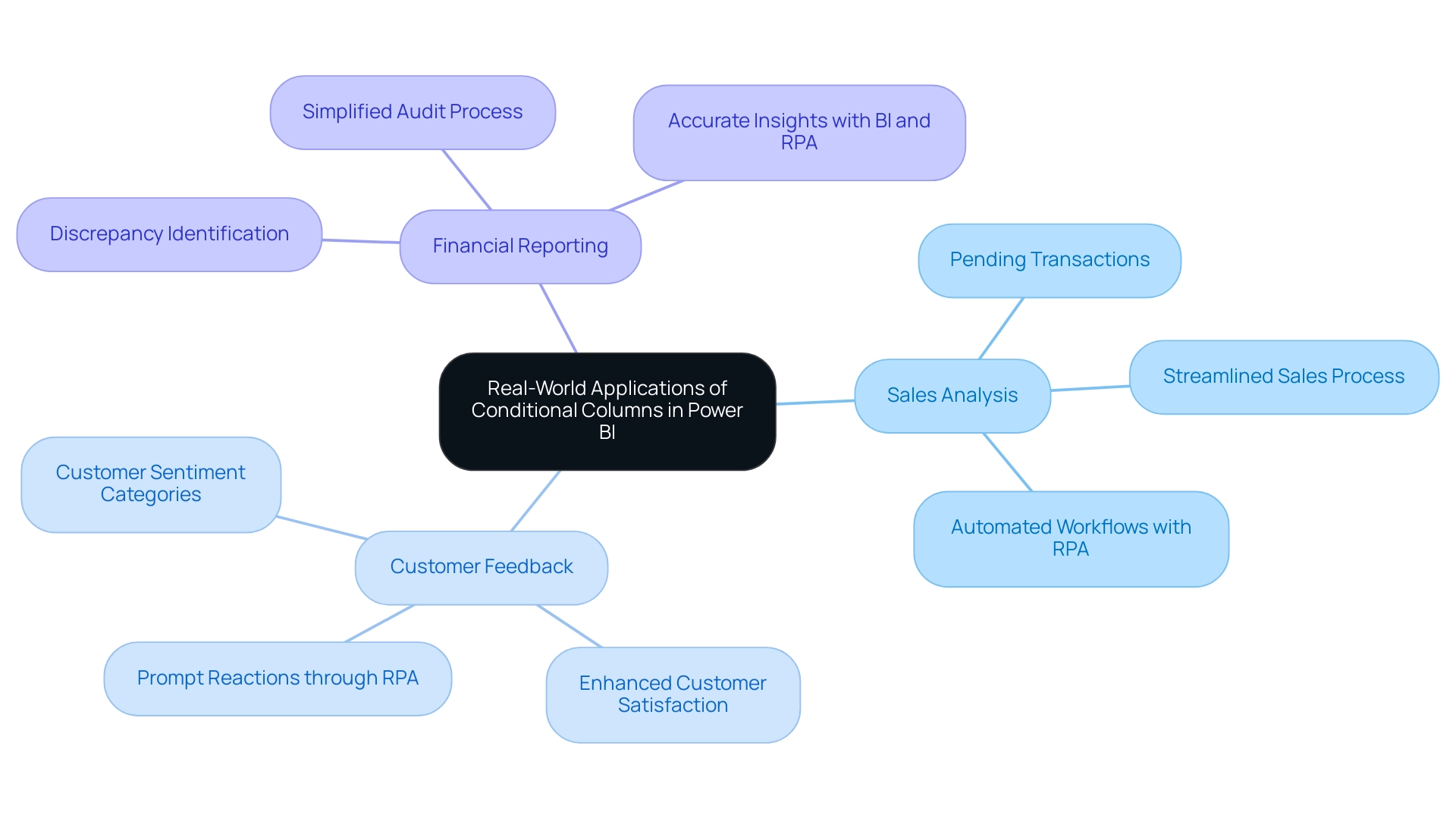
Conclusion
Harnessing the power of conditional columns in Power BI is pivotal for organizations striving to maintain data integrity and derive actionable insights from their datasets. By effectively managing null values and establishing clear categorizations within data, businesses can enhance the accuracy of their analyses and streamline their decision-making processes. The step-by-step guidance provided illustrates how easy it is to implement these conditional columns, ensuring that data remains intact and actionable, even when faced with gaps.
Moreover, adopting best practices in data management—such as:
– Validating data
– Utilizing descriptive naming conventions
– Documenting logic
can significantly improve the reliability of insights. Integrating Robotic Process Automation (RPA) into these workflows not only mitigates the challenges posed by null values but also frees up valuable resources for strategic initiatives. The real-world applications discussed highlight how various sectors are successfully leveraging conditional columns for:
– Sales analysis
– Customer feedback
– Financial reporting
ultimately driving operational efficiency.
In a landscape where data is a critical asset, the proficient use of conditional columns positions organizations to unlock the full potential of their data. By embracing these tools and practices, businesses can transform their data management strategies, leading to enhanced insights, informed decision-making, and sustained competitive advantage. The time to act is now; mastering these techniques can pave the way for a more data-driven future.
Overview:
To calculate the difference between two dates in Power BI, users can utilize functions such as DATEDIFF and NETWORKDAYS, which allow for straightforward calculations and the exclusion of weekends and holidays, respectively. The article emphasizes the importance of selecting the appropriate method based on the analysis requirements, demonstrating how these functions enhance operational efficiency and provide actionable insights through effective date management.
Introduction
In the realm of data analysis, mastering date difference calculations in Power BI is not just a technical skill; it is a gateway to unlocking valuable insights that can drive strategic decisions. As businesses strive to enhance their operational efficiency and make informed choices, understanding how to accurately calculate the time between dates becomes essential.
Whether tracking project timelines, analyzing sales periods, or measuring performance metrics, the ability to manipulate date data effectively addresses common challenges such as report inconsistencies and time-consuming processes.
This article delves into various methods, from basic functions like DATEDIFF to advanced techniques involving DAX, equipping professionals with the tools they need to transform their data into actionable intelligence. By exploring practical examples and case studies, readers will discover how to navigate the complexities of date calculations, ultimately empowering them to leverage their data for greater success.
Understanding Date Difference Calculations in Power BI
Understanding how to power bi calculate difference between two dates is an essential skill for analysis, enabling professionals to efficiently monitor project timelines, examine sales intervals, and assess performance metrics. This functionality empowers users to derive actionable insights from their data, addressing common challenges such as time-consuming report creation, data inconsistencies, and the lack of actionable guidance. For instance, when comparing two specific points in time, such as July 15, 2023, and July 31, 2023, the difference amounts to 16 days.
Utilizing Moment JS allows for finding the numeric difference between two points in time by parsing them into Moment JS objects, which enhances the accuracy of these calculations. A practical example of this can be seen in the case study titled ‘Difference Calculation,’ which demonstrates how to calculate the difference in days between the specified times, confirming the 16-day difference. Comprehending how to manipulate periods also allows for expressing these differences in various units—days, months, or years—tailored to the specific analysis requirements.
As Telmo Silva aptly noted, ‘Theoretically, we know the time up to the millisecond, but did it happen in Sydney or Toronto time?’ This foundational knowledge is essential as we prepare to explore the various operations and techniques in Power BI that allow us to calculate the difference between two dates, ensuring you are equipped to maximize the potential of your data while overcoming the prevalent issues of report construction, clarity, and the need for actionable guidance.
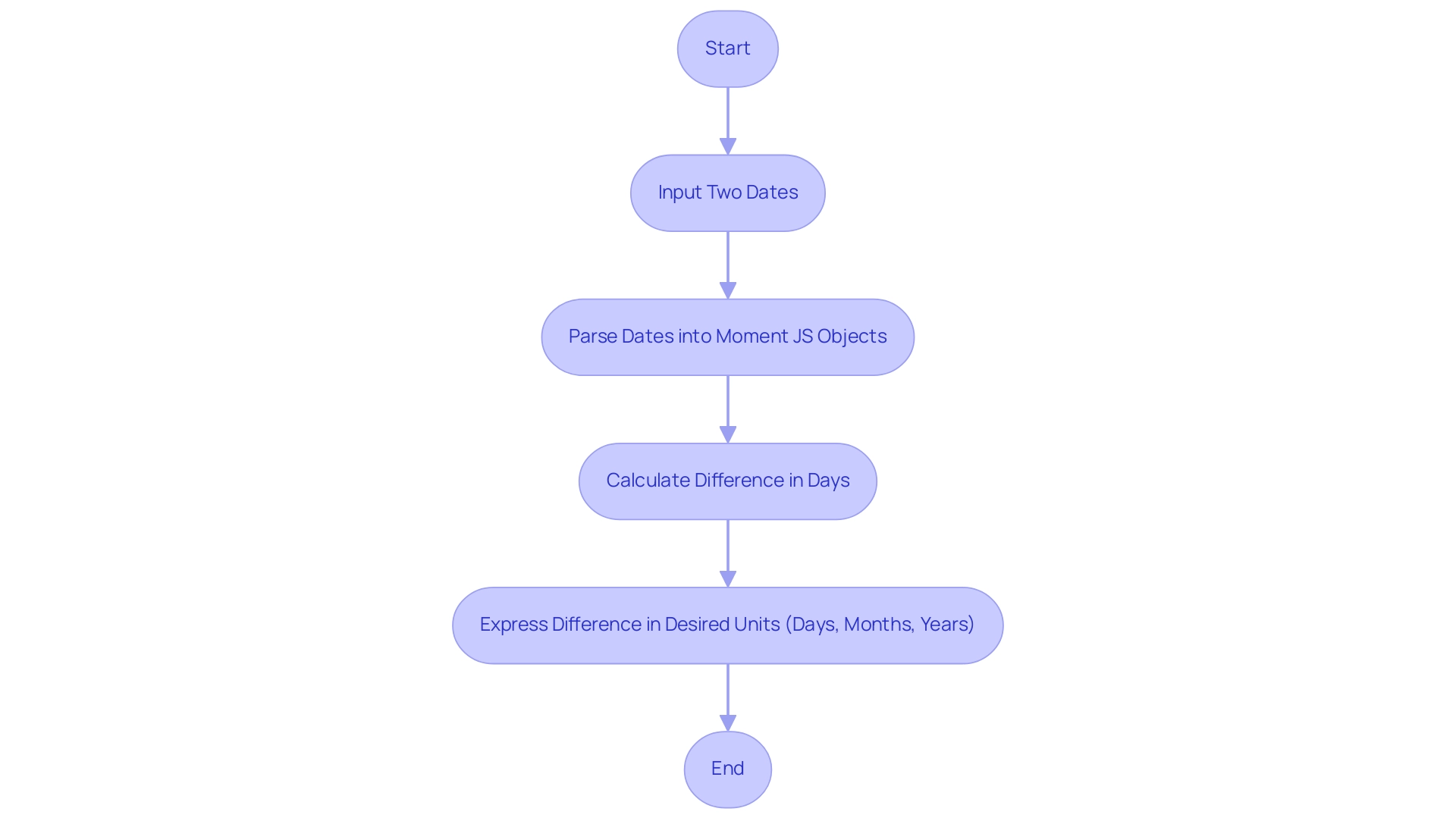
Using the DATEDIFF Function for Date Calculations
To effectively power bi calculate difference between two dates, utilize the DATEDIFF tool with the following syntax: DATEDIFF(Start_Date, End_Date, Interval). The Interval parameter can be designated as DAY, MONTH, or YEAR, depending on the type of difference you wish to measure. For instance, if you’re interested in determining the number of days between January 1, 2023, and January 31, 2023, you would apply the method as follows: DATEDIFF('2023-01-01', '2023-01-31', DAY).
This method is not only straightforward and effective for basic time difference calculations, but it also plays a crucial role in business analysis by using Power BI to calculate the difference between two dates, thereby deriving key insights from time-related information and addressing challenges like time-consuming report creation and data inconsistencies. By leveraging the DATEDIFF tool in Power BI, businesses can calculate the difference between two dates to gain clarity on timelines and improve decision-making processes, ultimately enhancing data-driven insights. The consistent demand for Power BI to calculate the difference between two dates across various reports highlights its importance in driving operational efficiency.
For example, the expected output for the value ‘-8’ is 11 occurrences, which can illustrate trends in reporting and operational performance. As noted by Lin from the Community Support Team, > I have had the same problem as you, but now I understand it’s very simple <. This sentiment resonates with many users who find clarity and efficiency through mastering this essential capability.
Furthermore, integrating RPA solutions can further simplify the use of Power BI features like DATEDIFF, automating repetitive tasks and enhancing overall operational strategies. Case studies such as ‘Creating Measures for On-time Shipping’ further demonstrate how the DATEDIFF tool in Power BI can calculate the difference between two dates to analyze shipping occurrences effectively, reinforcing its value in enhancing overall operational strategies.
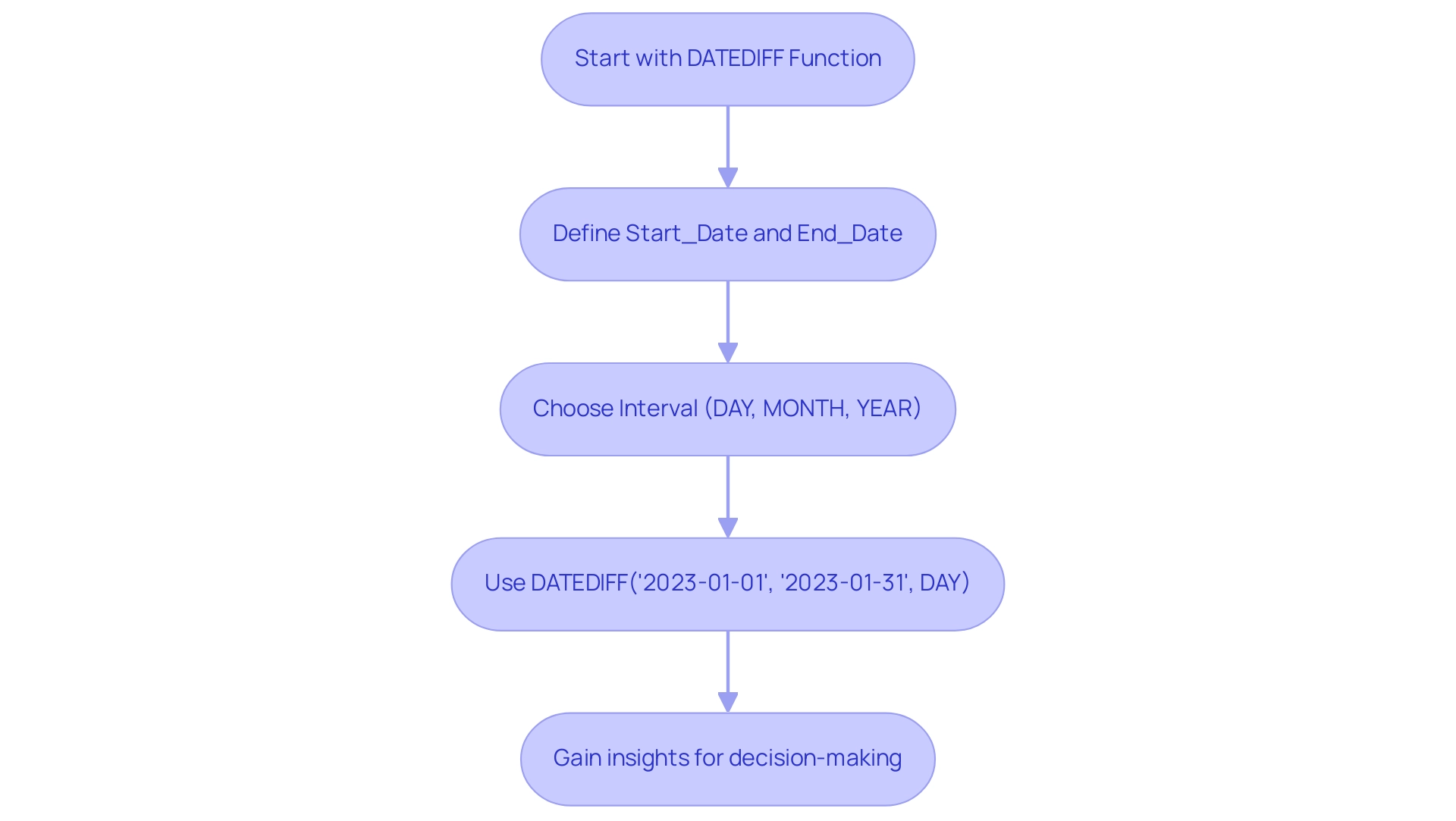
Calculating Working Days Between Two Dates
To accurately power BI calculate the difference between two dates, the NETWORKDAYS method serves as a powerful tool, essential for driving operational efficiency and addressing the lack of data-driven insights. This function effectively excludes weekends and can be tailored to account for specific holidays when included, addressing the common challenge of data inconsistencies in report creation. Its syntax is straightforward: NETWORKDAYS(Start_Date, End_Date, [Holidays]).
For example, if you’re tasked with calculating the working days from January 1, 2023, to January 31, 2023, while factoring in holidays, your formula would look like this: NETWORKDAYS('2023-01-01', '2023-01-31', Holidays). This approach is crucial as it ensures your analysis accurately reflects the actual working time available for projects and helps power bi calculate difference between two dates, directly impacting growth and innovation. With an average of 22 working days in a month, it’s important to note that for a partial month with 10 days, the result would yield approximately 7.33 working days.
Incorporating holidays and weekends in your assessments can significantly impact project timelines and resource allocation. Furthermore, the Timeboard Package for Business Days showcases efficient business day computations while taking holidays in different countries into account, offering a practical example of how such processes can be executed. Particular RPA tools, like EMMA RPA and Power Automate, can further improve operational efficiency by automating these processes and ensuring consistency in reporting.
As ZdPo Ster wisely remarked, ‘If someone is seeking a resolution regarding holidays (without any extensive library like pandas), consider this method…’ highlighting the significance of including holidays in temporal assessments to foster data-driven insights and operational efficiency.
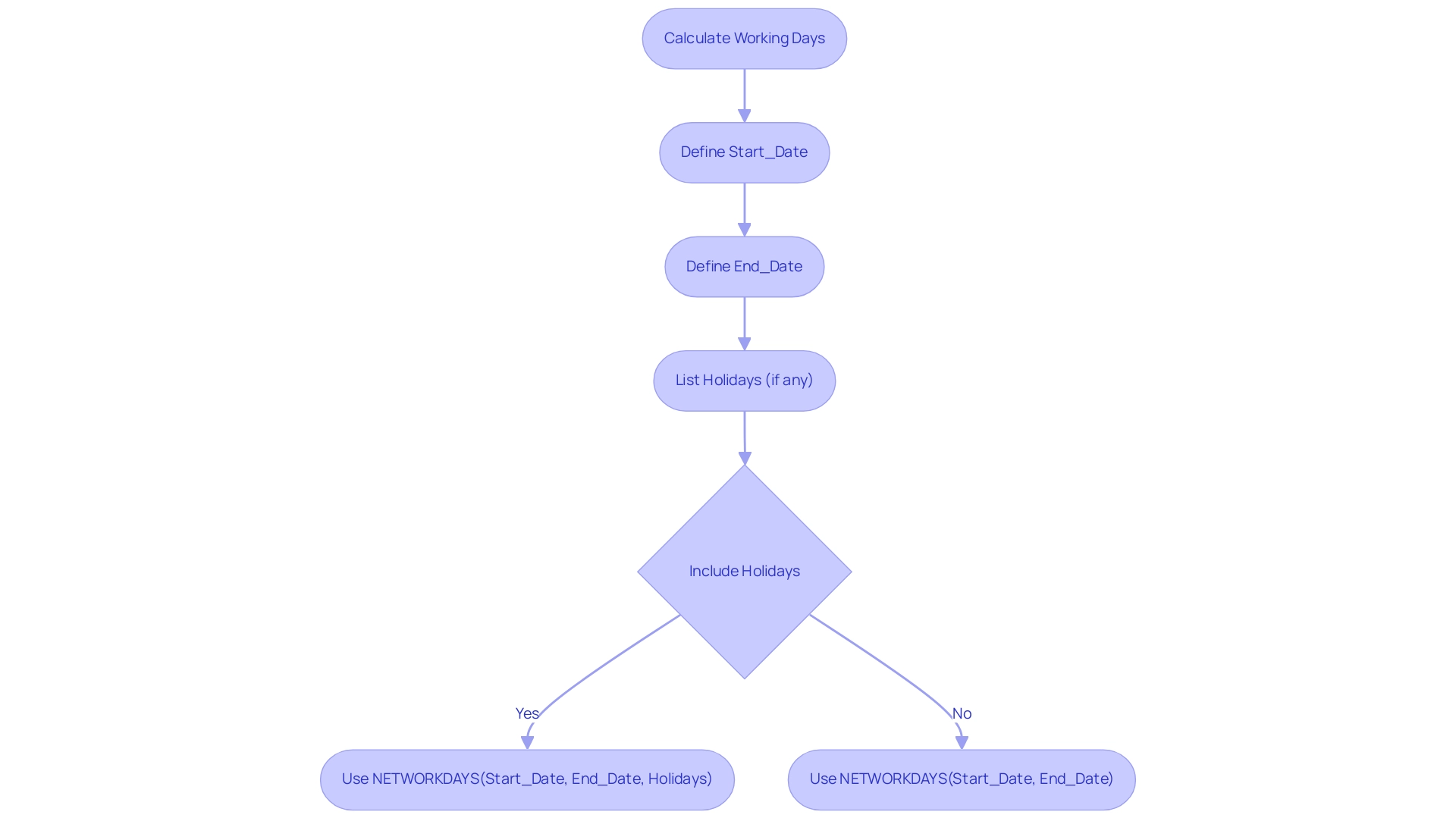
Advanced Techniques for Date Difference Calculations
For those aiming to power BI calculate the difference between two dates accurately, utilizing a combination of DAX functions such as CALCULATE, FILTER, and DATESINPERIOD is essential. A practical method in Power BI to calculate the difference between two dates entails generating a calculated column that efficiently filters out weekends, enabling a more precise assessment of business days. By excluding Saturdays and Sundays, you can focus solely on weekdays, which is crucial for operational efficiency—especially when integrated with Robotic Process Automation (RPA) to automate these workflows.
RPA not only streamlines processes but also significantly reduces errors and frees up your team for more strategic, value-adding work. Furthermore, creating a custom calendar table can enhance your ability to manage holidays and other non-working days, which is crucial for using Power BI to calculate the difference between two dates and ensuring that your date assessments align with your specific business needs. DAX allows users to craft dynamic visualizations that update automatically based on real-time data changes, further enhancing your analytical capabilities.
Furthermore, it’s important to consider the ERROR function, which plays a crucial role in debugging and managing unexpected situations within your computations. Incorporating a reference to the case study on troubleshooting common DAX issues can also provide real-world relevance, demonstrating the practical implications of these techniques, particularly in optimizing calculations and enhancing performance. This customized approach not only leads to more precise reporting but also enhances decision-making through improved insights.
As Yash Sinha aptly states,
Master analytics and tech with top-notch resources in Power BI, SQL, Machine Learning, and AI. Level up your skills and stay ahead in the data game!
Embracing these advanced DAX techniques, alongside RPA, will elevate your analytical capabilities, providing a solid foundation for informed decision-making and driving business growth in a rapidly evolving AI landscape.
To navigate these challenges effectively, consider exploring additional resources that can guide you in leveraging these technologies for your operations.
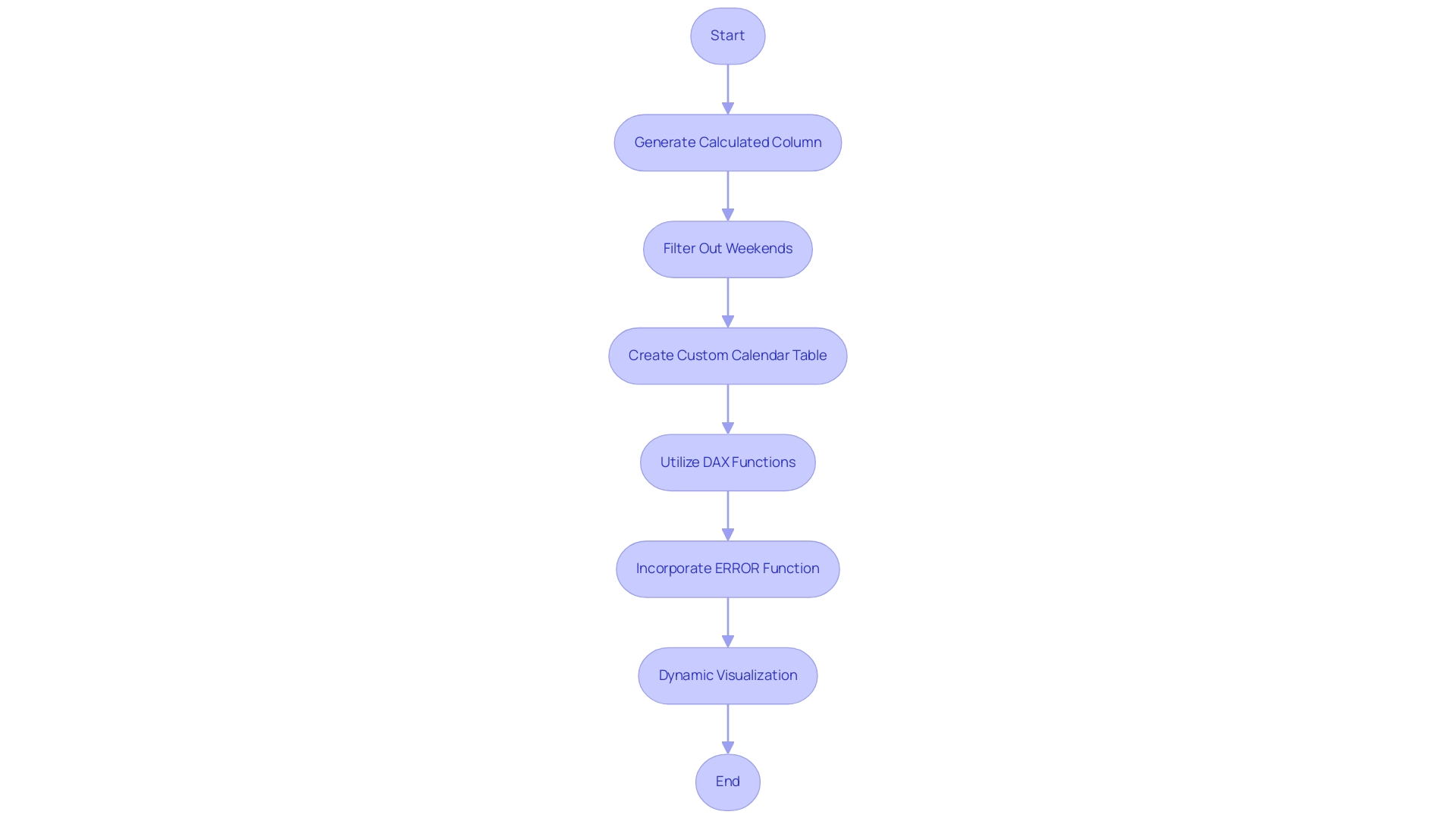
Choosing the Right Method for Your Date Calculations
Selecting the appropriate method for Power BI to calculate the difference between two dates is essential to meet the specific needs of your analysis and drive operational efficiency. For basic scenarios, the DATEDIFF operation provides a straightforward solution. However, when your analysis requires a more nuanced approach—such as accounting for working days, weekends, and holidays—the NETWORKDAYS function or advanced DAX techniques should be your go-to options.
As community expert littlemojopuppy highlights, “It’s beneficial to consistently include a calendar table in your information models,” improving precision and adaptability in computations. Be aware that the Auto Date/Time feature in Power BI can create hidden tables that are not easily customizable and may lead to performance issues in large datasets. Therefore, it’s crucial to evaluate your information context and the insights you aim to derive to make informed choices regarding your date calculation methods.
By leveraging Time Intelligence, you can simplify many basic functions of business reporting, significantly improving the quality of your reporting and empowering your operational decision-making processes. Additionally, integrating RPA solutions like EMMA RPA and Power Automate can further enhance operational efficiency by automating repetitive tasks, allowing your team to focus on strategic analysis and decision-making. This strategic evaluation aligns with best practices and positions you for success in utilizing Power BI effectively, ultimately unlocking the power of Business Intelligence to transform your raw data into actionable insights.
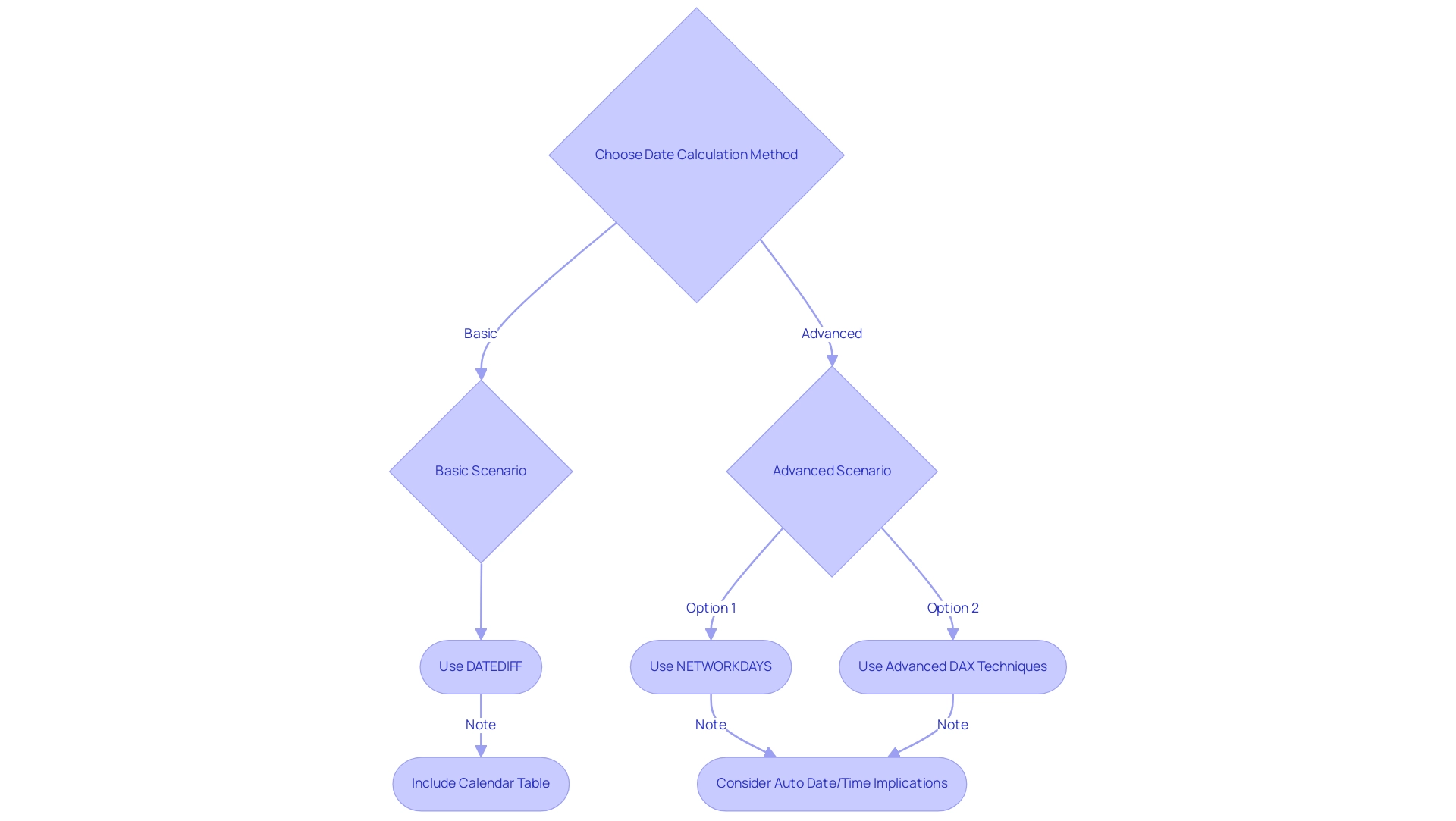
Conclusion
Mastering date difference calculations in Power BI is a transformative skill that empowers professionals to derive significant insights and improve operational efficiency. The article explored various methods, from the straightforward DATEDIFF function to more advanced DAX techniques and the NETWORKDAYS function, each tailored to different analytical needs. By understanding the nuances of these functions and their applications, users can navigate the complexities of date calculations, ensuring accuracy and relevancy in their reports.
The importance of selecting the right method for date calculations cannot be overstated. Whether addressing basic timelines or complex scenarios involving working days and holidays, the appropriate choice enhances clarity and decision-making. As demonstrated through practical examples and case studies, leveraging these tools not only streamlines processes but also leads to more informed strategic decisions.
Ultimately, the ability to manipulate date data effectively positions organizations to overcome common challenges in reporting and analysis. By embracing these techniques and integrating automation solutions, businesses can unlock the full potential of their data, driving growth and innovation in an increasingly data-driven landscape. As operations become more efficient and insights more actionable, the path to achieving operational excellence becomes clearer.
Overview:
To create a Power BI calculated column based on another table, users should follow a step-by-step process involving loading data, selecting the appropriate table, and writing a DAX formula that references the desired column from the other table. The article outlines this process, emphasizing the importance of establishing relationships between tables and testing DAX formulas incrementally to ensure accuracy and optimize performance, thus enhancing the overall effectiveness of data analysis in Power BI.
Introduction
In the dynamic landscape of data analytics, calculated columns in Power BI emerge as a vital resource for enhancing operational efficiency and data representation. These powerful tools enable users to create new data columns by leveraging existing information, seamlessly integrating them into reports and dashboards.
However, the journey to mastering calculated columns is often fraught with challenges, including:
- Data inconsistencies
- The complexities of DAX formulas
This article delves into the intricacies of calculated columns, offering practical guidance on their creation, effective use cases, and troubleshooting strategies. By harnessing the full potential of calculated columns alongside innovative tools like Robotic Process Automation (RPA), organizations can transform their data into actionable insights, ultimately driving informed decision-making and fostering growth in an ever-evolving business environment.
Understanding Calculated Columns in Power BI
Calculated fields in Power BI serve as a transformative tool, allowing users to create a power bi calculated column based on another table, derived from existing information within the same or related tables. These sections are calculated during the refresh procedure and stored within your model, enabling smooth integration into visualizations, filters, and slicers. For example, the total items shown indicate the number of items presented, which can be especially beneficial when computed fields are employed to improve information representation.
Mastering the use of computed fields is crucial, as they enable the handling and alteration of information directly within BI, significantly improving your reporting and analytical abilities. However, challenges exist, such as those highlighted in case studies regarding report limitations, leading to user dissatisfaction and a lack of actionable guidance. This highlights the necessity for a strong governance strategy to ensure consistency and deliver clear, actionable insights.
By utilizing computed fields in conjunction with BI services—such as our 3-Day Sprint for quick report generation and the General Management App for thorough oversight—you’ll acquire deeper insights from your information that inform decisions and enhance operational efficiency. Additionally, using a power bi calculated column based on another table can streamline report creation by automating transformations, thus reducing inconsistencies and enhancing clarity in the insights provided. As the BFSI sector is anticipated to undergo swift expansion, remaining informed about BI features will directly influence your organization’s analysis strategies and results.
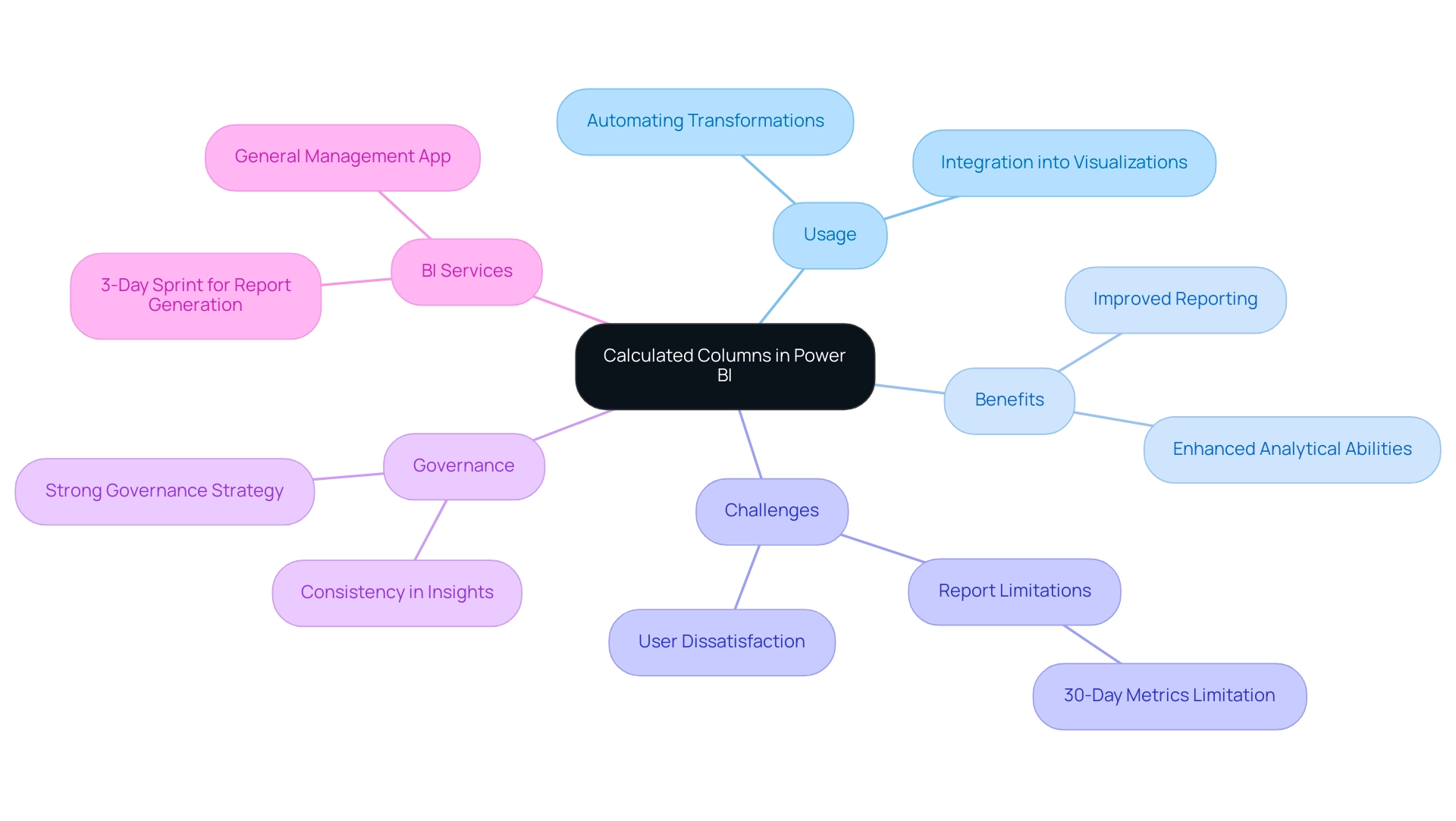
Step-by-Step Guide to Creating a Calculated Column from Another Table
-
Launch BI Desktop: Start by opening the BI Desktop application on your computer to access its powerful information manipulation capabilities that can enhance your business productivity through actionable insights.
-
Load Your Data: Import the necessary tables into Power BI that you wish to analyze. Ensure that both tables are visible in the Fields pane, as this is crucial for referencing information across them, particularly when addressing common challenges such as inconsistencies.
-
Navigate to Data View: Click on the ‘Data’ icon located on the left sidebar to switch to Data View, where you can work directly with your data and prepare it for effective reporting.
-
Select the Table for the Calculated Field: Choose the specific table where you want to add the new calculated field, ensuring it aligns with your analytical goals and the insights you need to drive operational efficiency.
-
Create the Calculated Field: In the ribbon, click on ‘Modeling’ and select ‘New Field’ to initiate the field creation process, which will help streamline your report creation process.
-
Write Your DAX Formula: In the formula bar, compose your DAX formula that references the other table. For instance, use the following structure to create a power bi calculated column based on another table:
NewColumn = RELATED(OtherTable[ColumnName])
Here,OtherTabledenotes the name of the table you are accessing, andColumnNameis the specific field you wish to retrieve information from. -
Press Enter: After completing your formula, press Enter to finalize the creation of the derived field. This new section will now show in the Fields pane below the selected table, improving your information model.
-
Use in Reports: With your calculated column established, you can now incorporate it into your reports and dashboards, enhancing your visualization and analysis efforts, which is crucial for making informed decisions that drive growth.
Effective documentation of your calculations, such as using comments within your DAX formulas, can significantly enhance understanding and maintainability of your model. For example, by documenting your calculations, you can clarify logic and assist in troubleshooting, a practice that becomes essential when leveraging insights from large datasets. As noted by software engineer Douglas Rocha, “Hope I’ve helped you in some way and see you next time!”
This approach is especially important when dealing with large datasets, where the threshold for defining large transactions is set at 10,000, making clear documentation even more critical.
Moreover, think about using BI Shape Maps in your visualizations for a contemporary method of representation, enabling you to examine information geographically and personalize your reports efficiently, thereby improving your overall operational effectiveness.
Furthermore, integrating Robotic Process Automation (RPA) can significantly streamline your workflow. By automating repetitive tasks such as information entry and report generation, RPA can free up your team to focus on more strategic initiatives, ultimately enhancing productivity. For example, when RPA is utilized to automate the import process into BI, it decreases the time allocated to manual tasks and lessens the risk of mistakes, enabling more precise and prompt insights.
This synergy between RPA and Business Intelligence tools such as BI is essential for transforming unprocessed information into actionable insights that propel informed decision-making.
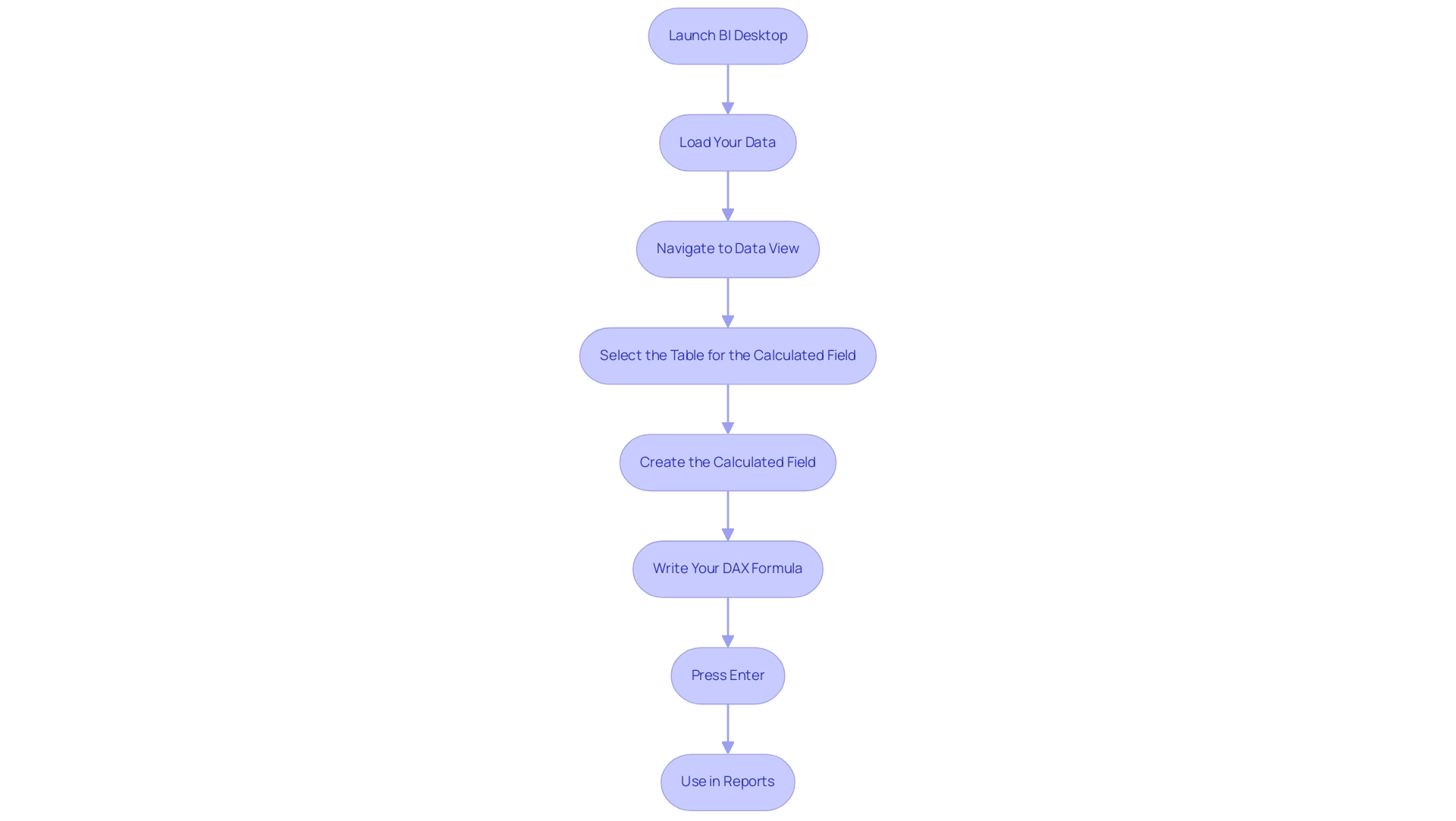
Calculated Columns vs. Measures: Key Differences Explained
In BI, derived attributes and measures serve distinct yet complementary roles, each essential for effective data analysis amid common challenges faced in report creation. With 80%-90% of Power BI’s target market consisting of business users, understanding these concepts is particularly relevant. Many users discover they spend too much time creating reports instead of utilizing insights from dashboards, frequently because of the complexities related to calculated fields and measures.
Computed fields are generated during the information loading process and stored within the model, allowing them to execute row-level calculations. This functionality enables users to extract new information from current fields, offering a strong framework for filtering, grouping, and summarizing content. Conversely, measures are calculated at the time of query execution and are not stored within the model.
They are specifically crafted for aggregations and calculations that rely on the context of the report, such as computing sums or averages. This critical distinction is akin to the analogy of calculated columns as floor tiles—once installed, altering them necessitates substantial effort and can disrupt the entire structure of your report. Additionally, inconsistencies in information across various reports due to a lack of governance strategy can lead to confusion and mistrust in the information presented.
To address these issues, it’s crucial to implement a governance strategy that ensures information consistency and reliability. A case study titled ‘Visual Use of Calculated Columns and Measures’ illustrates how understanding these distinctions aids users in effectively utilizing BI’s capabilities for analysis and reporting. Furthermore, many reports are filled with numbers and graphs yet lack clear, actionable guidance, leaving stakeholders without a defined direction on the next steps.
Mastering when to utilize computed fields versus measures is essential for optimizing your Power BI reports, particularly when creating a Power BI calculated column based on another table, ensuring precise information representation, and enhancing the overall user experience. Ultimately, this understanding not only enhances reporting efficiency but also enables users to make informed decisions based on their information.
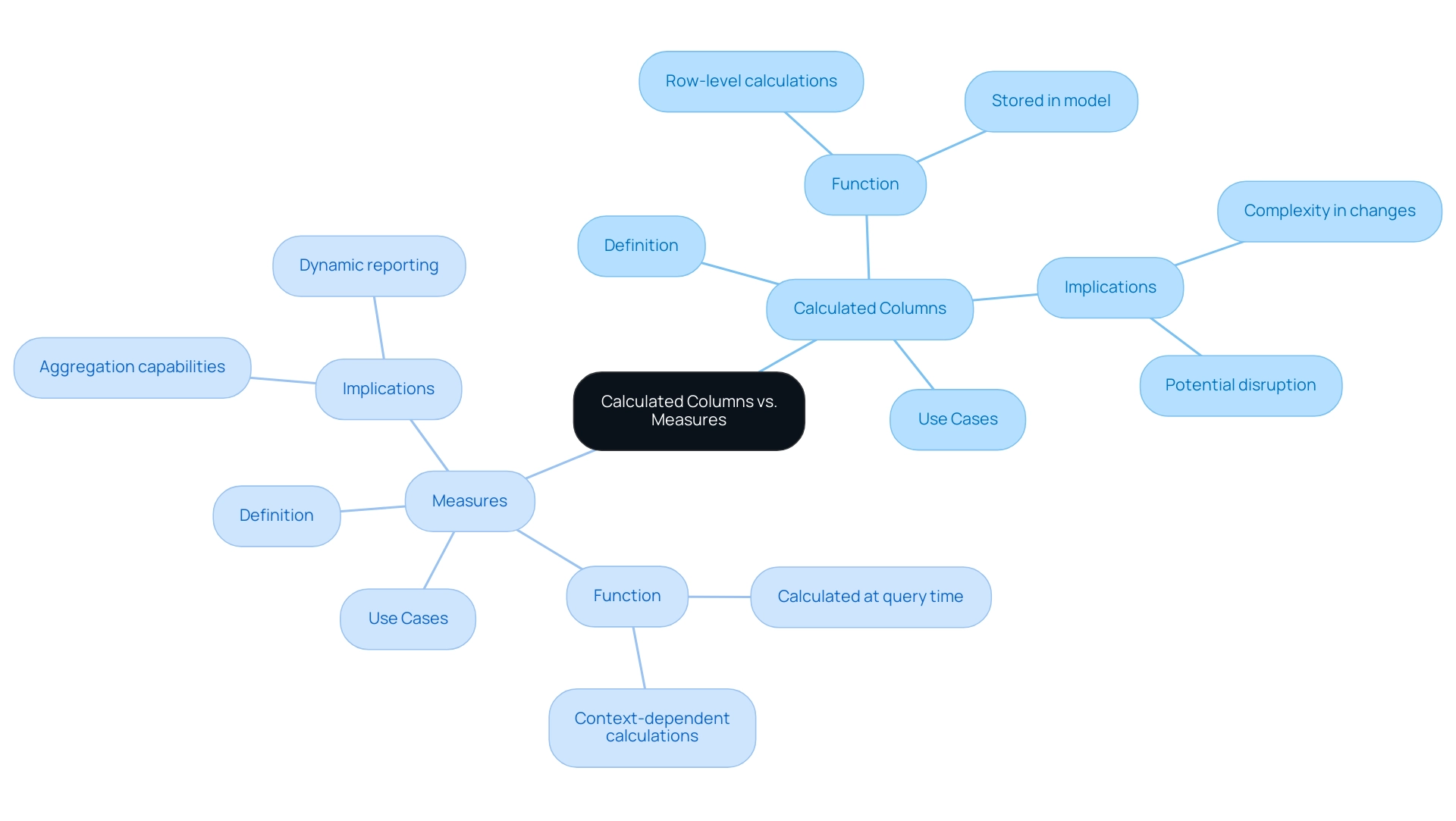
Practical Use Cases for Calculated Columns in Power BI
-
Creating Full Names: By merging separate first and last name sections into a calculated field, you enhance report readability significantly. This practice not only simplifies information presentation but also enhances user experience when accessing reports, ultimately supporting operational efficiency through clearer insights.
-
Classifying Information: Computed fields can convert numerical values into significant categories, such as tagging sales figures as ‘Low’, ‘Medium’, or ‘High’. This categorization assists analysts in quickly interpreting information, streamlining decision-making processes, and enhancing overall effectiveness, particularly when paired with RPA tools that automate these categorizations. Research indicates that organizations utilizing such categorizations see a 30% increase in decision-making speed.
-
Date Calculations: Implementing derived fields to determine the age of items based on date fields is invaluable for inventory management. This practice provides real-time insights into stock levels and helps in generating timely reports that can influence purchasing decisions, showcasing how RPA can ensure this data is updated automatically for enhanced accuracy.
-
Conditional Logic: Employing computed fields for conditional logic enables you to establish dynamic flags or indicators based on specific criteria. This capability enhances reporting flexibility and enables more targeted analyses, addressing the unique needs of your operations while leveraging RPA to automate these processes.
In a case study titled ‘Conclusion on Best Practices,’ it is emphasized that while concerns about DAX computed fields are often exaggerated, business users can concentrate on their analysis without worry of major problems. Douglas Rocha, a data science enthusiast, aptly notes, “Last but definitely not least is the Mode,” emphasizing the importance of understanding data in context for effective reporting. However, it is essential to acknowledge that DAX computed fields can lead to performance issues if not used judiciously.
Incorporating relevant statistics on the effectiveness of calculated columns in reporting, alongside RPA implementations, would further enhance the credibility of these claims.

Troubleshooting and Best Practices for Creating Calculated Columns
-
Check Relationships: It is essential to ensure that DAX functions like RELATED operate effectively by establishing correct relationships between the tables involved in your analysis within Power BI. Well-defined relationships are essential for precise information retrieval and calculations, which is crucial in an information-rich environment where insightful business intelligence can promote growth and innovation.
-
Review DAX Syntax: Conducting a thorough review of your DAX formulas for syntax errors is crucial. Common pitfalls include missing parentheses and incorrect column or table names, which can lead to erroneous outputs. By taking the time to verify syntax, you can save significant troubleshooting time later, ultimately enhancing operational efficiency and decision-making.
-
Set Type to Text: To prevent the aggregation of a field in Power BI Desktop, ensure its type is set to Text. This step is vital for maintaining the integrity of your information, avoiding unintended calculations, and ensuring that you can leverage actionable insights effectively.
-
Performance Considerations: Be aware of the potential effect that derived attributes may have on your data model’s performance. Excessive use of derived fields can bloat your model and slow down processing times. Where possible, opt for measures, which are typically more efficient and can enhance overall performance, thus facilitating quicker decision-making.
-
Test Incrementally: When constructing complex DAX formulas, it is beneficial to build and test them incrementally. This approach allows you to verify the accuracy of each component before finalizing the calculated data, ensuring that any issues are identified and resolved early in the process. Utilizing the DEFINE COLUMN syntax in DAX Studio can help create query columns that persist only for the session, providing a versatile tool for testing without impacting the overall model.
-
Case Study on Aggregation: Consider the example of changing numeric field aggregation in BI visualizations. Users can customize how numeric fields are aggregated, such as displaying the average units sold instead of the sum. By right-clicking the measure in the Visualizations pane and selecting the desired aggregation type, users can tailor their visualizations to better reflect their analytical needs, overcoming common challenges and enhancing the utility of insights derived from BI dashboards.
-
Integrate RPA Solutions: To further enhance operational efficiency, consider integrating RPA solutions that can automate repetitive tasks and reduce the workload on your team. This synergy between BI and RPA can streamline processes and allow for more focus on strategic decision-making.
-
Navigating AI Options: As you utilize BI for insights, be aware of the overwhelming number of AI solutions available. Tailored AI solutions can help cut through the noise, aligning with your specific business goals and challenges, ensuring that you make informed decisions that drive growth.
By following these guidelines, you can navigate the common challenges associated with a Power BI calculated column based on another table, ensuring a smoother and more efficient data modeling experience that empowers informed decision-making and promotes operational efficiency. For further assistance, consider booking a consultation to explore how RPA and AI can enhance your data-driven strategies.

Conclusion
Harnessing the power of calculated columns in Power BI is essential for any organization aiming to elevate its data analysis and reporting capabilities. By understanding how to create and utilize these columns effectively, businesses can transform existing data into actionable insights that drive operational efficiency. The article highlights the importance of mastering DAX formulas and recognizing the distinct roles of calculated columns versus measures, ensuring a more streamlined and effective reporting process.
Practical applications such as creating full names, categorizing data, and implementing conditional logic demonstrate how calculated columns can significantly enhance data representation and decision-making speed. Moreover, incorporating best practices and troubleshooting strategies, like ensuring proper relationships and reviewing DAX syntax, empowers users to navigate potential challenges with confidence.
Ultimately, integrating calculated columns with advanced tools like Robotic Process Automation (RPA) can further optimize workflows, allowing teams to focus on strategic initiatives rather than repetitive tasks. As organizations continue to evolve in a data-driven landscape, leveraging these insights will not only foster growth but also support informed decision-making, setting the stage for sustained success in an increasingly competitive environment.
Overview:
Power BI clusters are essential for enhancing data visualization by allowing users to group data points based on shared characteristics, which helps identify patterns and trends. The article highlights that this functionality not only simplifies the analysis of complex datasets but also improves decision-making processes by enabling clearer visual representations and targeted insights, thus maximizing the effectiveness of business intelligence efforts.
Introduction
In the rapidly evolving landscape of data analytics, the ability to derive meaningful insights from complex datasets is paramount for organizations seeking a competitive edge. Power BI clusters emerge as a transformative tool, enabling users to group data points based on shared characteristics, thereby simplifying the identification of trends and patterns.
This article delves into the mechanics of Power BI clusters, exploring their role in:
- Enhancing data visualization
- Streamlining report creation
- Driving informed decision-making
With practical guidance on configuring clusters and troubleshooting common issues, readers will discover how to harness the full potential of this powerful feature to enhance operational efficiency and unlock actionable insights.
Understanding Power BI Clusters: A Fundamental Overview
Power BI cluster functionality is a crucial feature within the Microsoft Power BI suite, enabling users to group points based on shared characteristics. This powerful feature not only simplifies the identification of patterns and trends within extensive collections but also enhances the overall effectiveness of visualization. In the context of operational efficiency, the Drill Down Combo Bar PRO can visualize up to 25 series, significantly aiding in displaying complex grouping results.
By employing these grouping methods, users can significantly enhance their reports and dashboards, resulting in clearer understandings of distributions and interconnections. As Rico Zhou aptly states,
Create tooltips based on report pages in Power BI Desktop,
emphasizing the importance of detail in information representation. Addressing the lack of data-driven insights is crucial, as grouping techniques can significantly reduce the time-consuming nature of report creation and help resolve data inconsistencies.
Understanding the mechanics and benefits of clustering is crucial for maximizing its potential in data-driven decision-making. With the integration of RPA and tools such as Automate, you can streamline workflow automation, assess ROI risk-free, and execute professional solutions effectively. Furthermore, a continuous flow of information from Databricks to the Power BI cluster in Power BI allows for real-time monitoring of cluster metrics, empowering users to make informed decisions backed by robust analytics.
It’s vital to remember that to ensure correlation in the Usage Metrics Report, users must view the content from within the workspace at least once; otherwise, no information will be processed for the report, which can obstruct analysis and reinforce the practical implications of clustering techniques. To learn more about how our services can improve your data-driven understanding, book a free consultation today.
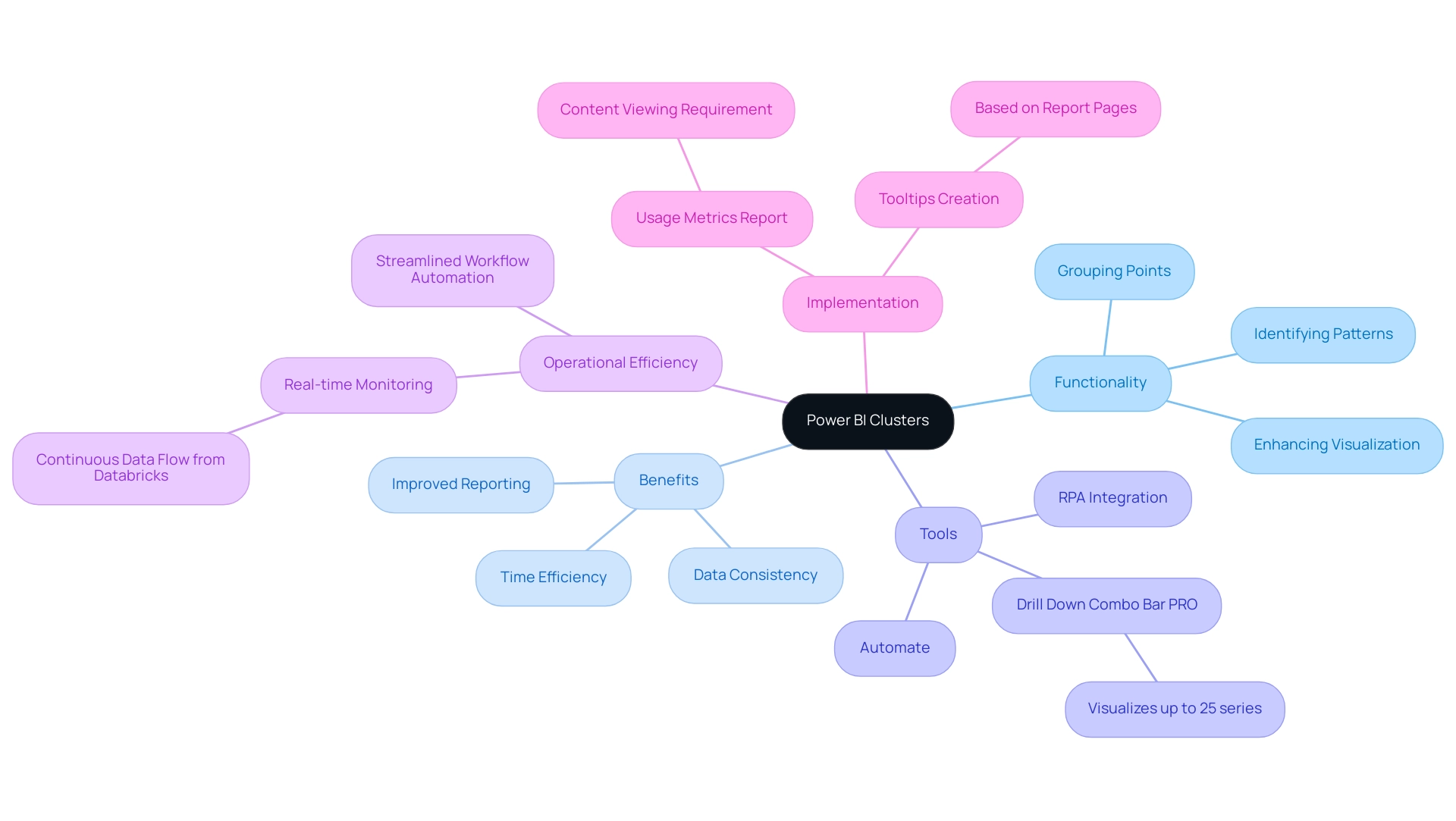
The Role of Clusters in Enhancing Data Visualization in Power BI
The power BI cluster is crucial for improving data visualization, as it enables users to divide data into significant groups that provide valuable understanding. This segmentation facilitates the creation of insightful visualizations—such as scatter plots and heat maps—that uncover underlying patterns and correlations, driving data-driven decision-making. For instance, a retail business can utilize grouping techniques to identify diverse customer segments based on purchasing behavior, allowing for the development of targeted marketing strategies that significantly enhance customer engagement.
In the context of today’s data-rich environment, struggling to extract valuable information can leave your business at a competitive disadvantage, making the use of BI tools essential for growth and innovation. Eralda Gjika notes that,
With user-friendly tools like the K-means Clustering Shiny App, individuals can easily perform cluster analysis, visualize their results, and make data-driven decisions with minimal effort.
This emphasizes the accessibility of powerful grouping techniques within a Power BI cluster to drive actionable insights.
By effectively utilizing group techniques, users can transform complex datasets into coherent visual narratives, ultimately leading to more informed business decisions and improved operational efficiency. Furthermore, our RPA solutions, including EMMA RPA and Power Automate, automate repetitive tasks associated with management, thereby freeing time for deeper analysis and improving operational efficiency. In a case study centered on geochemistry, grouping was employed to examine chemical properties across different sample sites, which improved the comprehension of geochemical variations and highlighted the practical uses of grouping in analysis.
Moreover, the rank-sum test for grouped information reported an estimated difference of 0.2015, offering quantitative support for the effectiveness of grouping techniques. Visualizing grouping results can also be achieved through confusion matrices, illustrating the performance of classification or grouping algorithms against established standards. Furthermore, model-based grouping, especially via Gaussian mixture models, provides a solid framework for comprehending information as originating from a blend of probability distributions, expanding the range of grouping applications in analysis.
In navigating the overwhelming AI landscape, these clustering techniques can simplify complex interpretations, making it easier for businesses to identify the right solutions tailored to their needs.
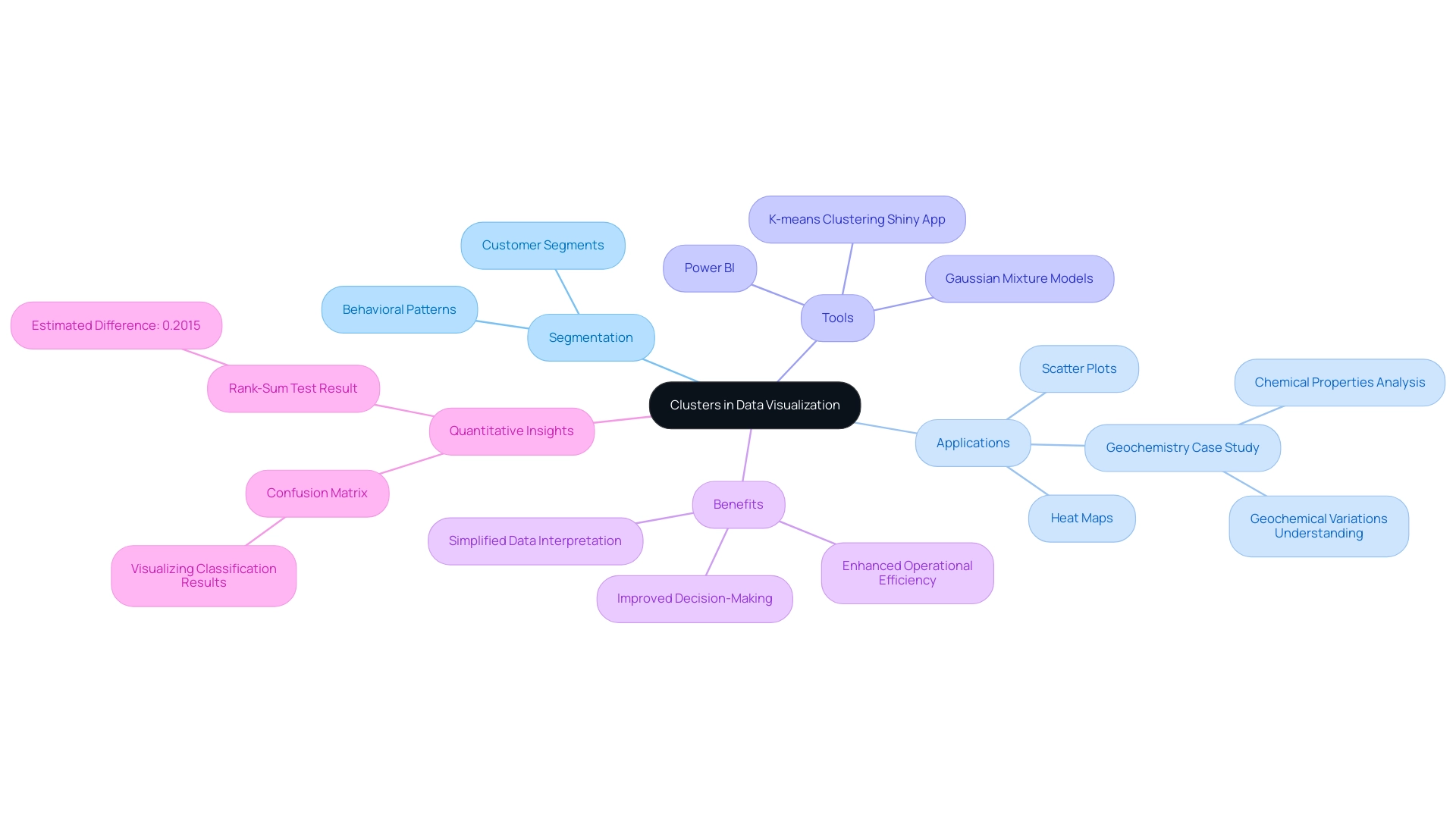
Configuring Power BI Clusters: Step-by-Step Guide
Setting up a Power BI cluster is a straightforward process that can significantly enhance your data visualizations, especially in overcoming common challenges such as time-consuming report creation and data inconsistencies stemming from a lack of governance strategy. To effectively set up clusters, follow these detailed steps:
- Open your BI report and select the visual that will benefit from clustering.
- Navigate to the ‘Analytics’ section in the Visualizations pane.
- Click on ‘Add Cluster’ to start the grouping feature for your selected visual.
- Select the fields you wish to group; Power BI will automatically analyze the dataset, which comprises 2,216 observations and 29 variables detailing customer habits and demographics, to identify clusters.
- Customize the cluster settings as necessary, including adjusting the number of clusters or choosing the algorithm that best fits your analysis needs. Carefully review the visualizations to confirm they accurately reflect the clustered data.
By following these steps, you not only enhance the clarity and understanding of your data visualizations but also drive data-driven decision-making. Many users encounter challenges when configuring clusters, such as incorrect field selections or misunderstanding the group settings. To prevent these drawbacks, acquaint yourself with best practices and utilize community knowledge on the newest BI grouping tools and features.
As pointed out by analytics enthusiast Douglas Rocha, ‘there isn’t a native DAX function to calculate it,’ underscoring the necessity for strategic setup to achieve precise understandings that align with a governance strategy.
For example, the bivariate grouping implementation case study illustrates how to visualize and analyze two quantitative variables using a scatter chart in BI, resulting in the creation of distinct customer clusters. Engaging with such real-world examples can further illuminate effective grouping strategies within the Power BI cluster. Moreover, community perspectives indicate that artificial intelligence is progressively impacting large information analysis, especially in information segmentation and machine learning algorithms, improving the effectiveness of your grouping efforts and ultimately promoting operational efficiency.
By adopting a strong governance strategy along with grouping methods, companies can guarantee information consistency and obtain practical understandings that aid informed decision-making.
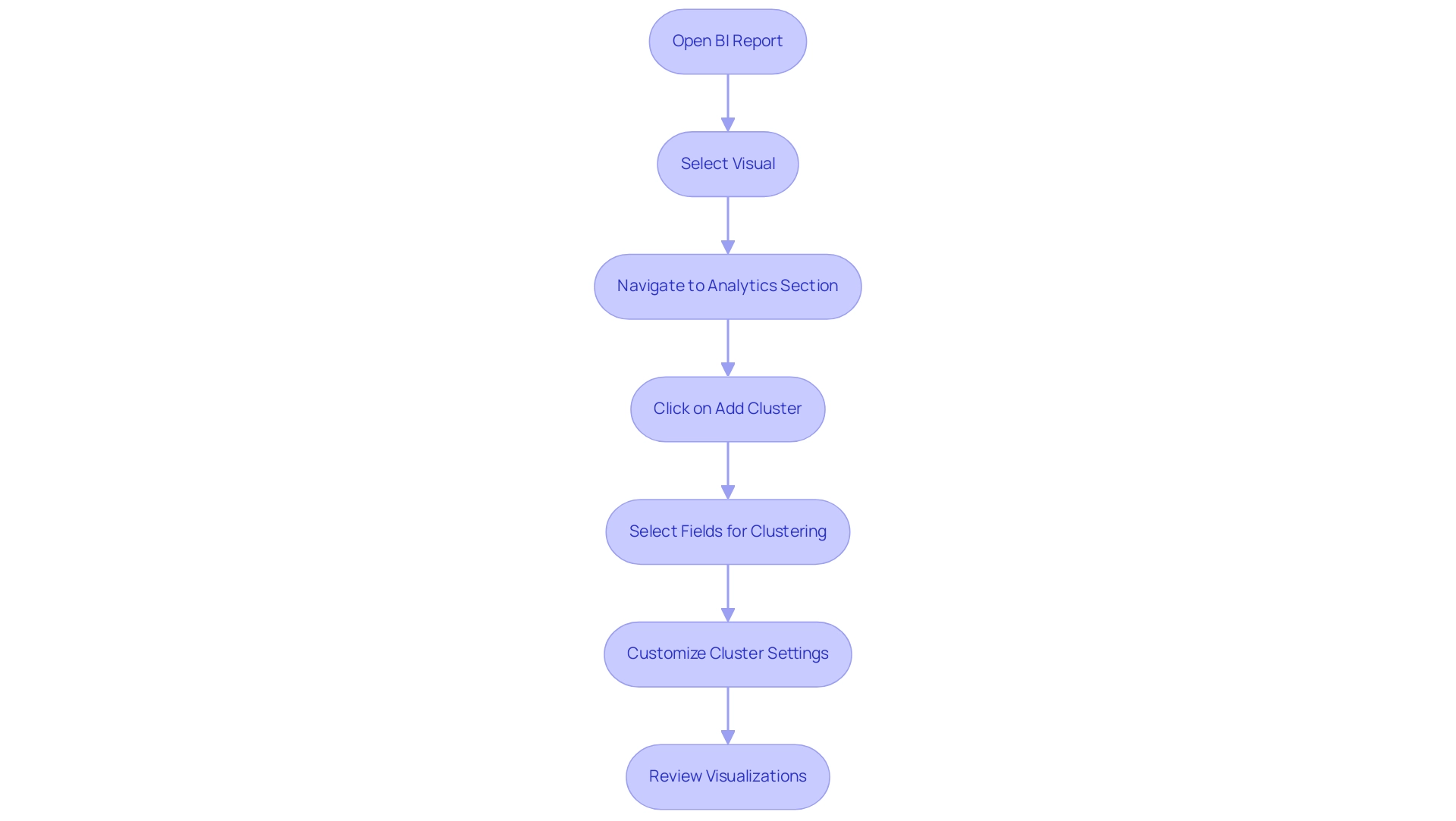
Benefits of Utilizing Clusters in Power BI for Data Insights
Utilizing clustering methods within a power bi cluster provides multiple benefits that greatly improve analysis and decision-making procedures, particularly in the realm of addressing difficulties encountered in utilizing information. Key benefits include:
- Improved Data Insights: Clustering unveils hidden patterns within datasets, enabling businesses to make more informed and strategic decisions. This is essential as the model encompasses terms for both within-cluster variation and between-cluster variation, allowing for a nuanced understanding of distributions. In today’s data-rich environment, effective extraction of these insights is vital to avoid competitive disadvantages.
- Enhanced Visualization: By grouping similar points, clusters transform complex information into visually comprehensible formats, facilitating easier interpretation and presentation, thus addressing issues of inconsistencies in reports.
- Targeted Analysis: Organizations can concentrate their efforts on specific segments of data, allowing for tailored strategies that address unique customer needs and market dynamics. As mentioned by Google, ‘If the examples are labeled, then grouping becomes classification,’ emphasizing the significance of clear categorization in decision-making.
- Increased Efficiency: Clustering streamlines the analytical process, conserving valuable time and resources while boosting overall productivity. In the face of time-consuming report creation, grouping can significantly enhance operational efficiency. Additionally, integrating Robotic Process Automation (RPA) solutions can further optimize these processes, automating repetitive tasks and allowing teams to focus on strategic initiatives. A relevant case study, titled “Performance of Statistical Tests on Simulated Datasets,” illustrates that valid statistical tests should reject the null hypothesis for approximately 5% of datasets when no real difference exists. This highlights the need for suitable statistical techniques in grouped data analysis, reinforcing the necessity of grouping in informed decision-making.
These advantages highlight the critical role of the power bi cluster in BI, underscoring its necessity for maximizing data-driven insights and fostering effective business decision-making, ultimately enhancing operational efficiency through advanced tools like RPA. For further engagement, consider exploring our RPA solutions that enhance these grouping techniques and drive even greater operational efficiency.
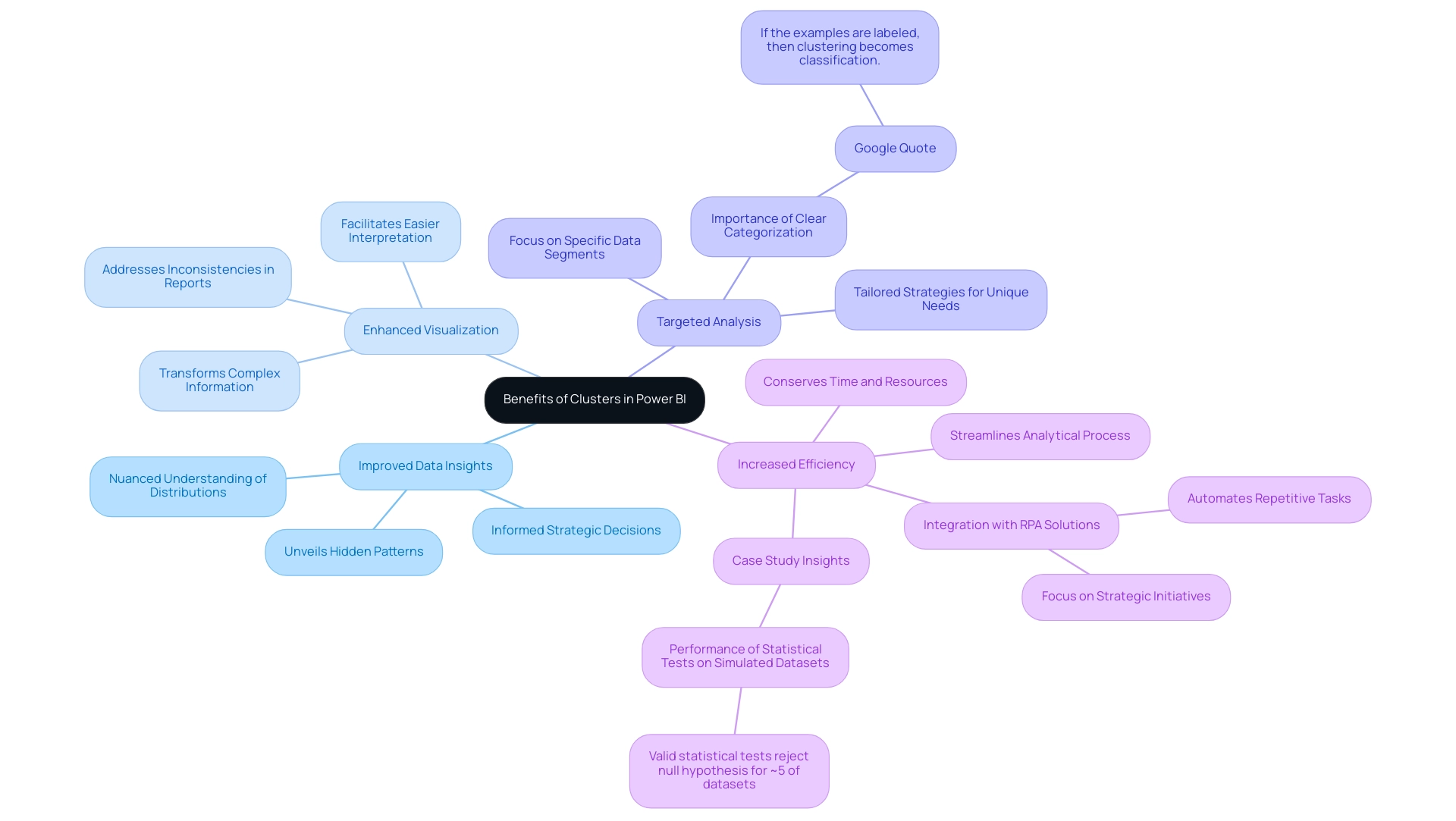
Troubleshooting Power BI Clusters: Common Issues and Solutions
Individuals utilizing a Power BI cluster frequently encounter various typical problems with grouping that can obstruct efficient analysis and visualization. Ongoing upkeep of the Power BI cluster is vital for peak performance and reliability, which is important in tackling these grouping issues. Here are some common challenges and their solutions:
-
Flawed Grouping Outcomes: When groups do not appear as expected, it’s essential to check that the right information types are utilized and that the suitable fields are chosen for grouping. Misalignment in information types can lead to misleading cluster formations.
-
Performance Issues: Working with large datasets can significantly impede clustering performance. To combat this, consider optimizing your models or reducing dataset sizes to enhance processing speed and efficiency. Utilizing Robotic Process Automation (RPA) can also streamline information processing, reducing the time spent on manual tasks and improving operational efficiency.
-
Visualizations Not Updating: If adjustments to clusters fail to reflect in visual outputs, ensure that you refresh the report and check connections. At times, a straightforward refresh can fix the inconsistencies between the information and visual depiction.
A practical instance of grouping issues can be observed in the case study of a user encountering a problem with a report created in BI. This user experienced a static output in a Stacked Column Chart despite attempts to dynamically edit it using a slicer connected to an Oracle Database. This scenario highlights the significance of ensuring that the data connections and configurations are set correctly, as well as the value of customized AI solutions that can cut through the noise of complex data environments.
To navigate these issues effectively, users are encouraged to utilize BI community forums and official documentation for additional support and tailored troubleshooting tips related to the Power BI cluster. Additionally, using appropriate evaluation metrics is necessary to assess clustering quality and select the best algorithm, ensuring that the clustering results are both statistically sound and meaningful. As Viraj Dhanusha aptly notes,
Sometimes, the results are statistically sound but fail to provide meaningful distinctions or actionable segments, which diminishes their utility in real-world applications.
To further enhance your BI experience, consider our ‘3-Day BI Sprint,’ where we create a fully functional, professionally designed report on a topic of your choice. This service enables you to concentrate on leveraging insights instead of becoming overwhelmed with report generation. Additionally, testimonials from users who have successfully navigated these challenges with BI highlight the effectiveness of our customized solutions.
By staying informed about these challenges and utilizing comprehensive services within the Power BI cluster, users can uphold robust data visualization practices and maximize the efficacy of their Power BI environment.
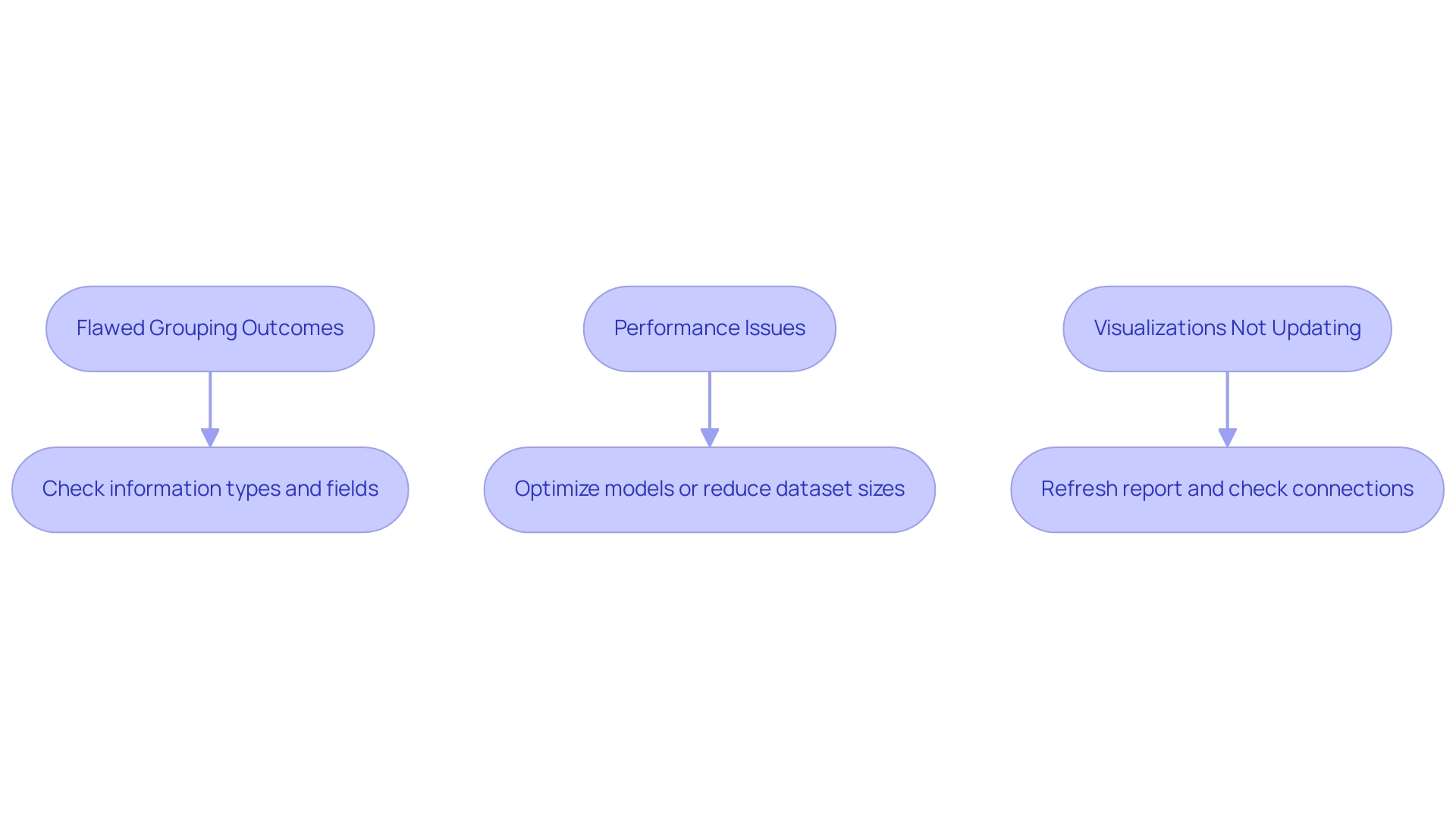
Conclusion
Harnessing the power of clusters in Power BI is a game-changer for organizations striving to enhance operational efficiency and make informed decisions. By grouping data points based on shared characteristics, clusters simplify the identification of trends and patterns, leading to improved data visualization and more insightful reporting. The ability to segment data facilitates targeted analyses, enabling businesses to tailor their strategies to meet specific customer needs and market dynamics.
The configuration of Power BI clusters, though straightforward, requires attention to detail to avoid common pitfalls that can hinder effective data analysis. By following best practices and leveraging community insights, users can optimize their clustering efforts, ensuring that the visualizations accurately reflect the underlying data. This not only enhances the clarity of insights but also drives efficiency by streamlining the reporting process.
Moreover, addressing common issues such as inaccurate clustering results and performance challenges is essential for maintaining the integrity of data analysis. By utilizing available resources and adopting a proactive approach to troubleshooting, users can maximize the benefits of clustering techniques. The integration of Robotic Process Automation further amplifies these advantages, allowing teams to focus on strategic initiatives rather than mundane tasks.
In conclusion, the strategic use of Power BI clusters is vital for any organization aiming to thrive in today’s data-driven landscape. By unlocking actionable insights and fostering effective decision-making, clusters become an indispensable tool in enhancing operational efficiency. Embracing these techniques not only positions organizations for success but also empowers them to navigate the complexities of data analytics with confidence.
Overview:
The article focuses on how to master Power BI animated visuals to enhance data storytelling for data analysts. It provides a comprehensive guide on creating these visuals, emphasizing their role in engaging audiences and effectively communicating insights, supported by evidence of their effectiveness in improving user engagement and clarity in data presentation.
Introduction
In the realm of data visualization, animated visuals in Power BI emerge as a transformative tool, turning complex datasets into engaging narratives that resonate with stakeholders. These dynamic representations not only streamline the often tedious process of report creation but also address critical issues such as data inconsistencies and clarity. By harnessing the power of animations, analysts can effectively highlight trends and changes, elevating static reports into captivating, interactive experiences. As organizations strive to enhance user engagement and drive actionable insights, the integration of animated visuals is no longer just an option; it is a necessity for fostering deeper connections with audiences and unlocking the full potential of Business Intelligence. Through a comprehensive exploration of techniques, best practices, and real-world examples, this article will guide professionals in leveraging animated visuals to enhance their data storytelling capabilities, ultimately paving the way for informed decision-making and business growth.
Introduction to Animated Visuals in Power BI
Power BI animated visuals serve as a catalyst for transforming information into compelling narratives. By employing dynamic representations, these visuals engage viewers and communicate complex information with clarity, tackling common challenges such as time-consuming document creation and inconsistencies. Significantly, visuals allow analysts to effectively emphasize trends, transitions, and changes over time, thereby transforming static documents into engaging, interactive experiences that offer clear, actionable guidance for stakeholders.
In a landscape where many struggle to extract meaningful insights, the power of Business Intelligence becomes paramount for driving growth and innovation. Evidence shows that companies with high customer engagement rates enjoy significantly higher staff Net Promoter Scores, underscoring the value of engaging content. Furthermore, video marketing has proven to be highly effective, with 85% of businesses using video reporting it as an effective tool, reinforcing the importance of animated visuals in enhancing user engagement.
As Vinay Koshy, founder at Sproutworth, points out,
Articles containing relevant images get 94% more total views compared to those without visuals.
This statistic reflects the necessity of integrating Power BI animated visuals to improve storytelling capabilities. Such skills are vital for contemporary analysts aiming to connect with their audience meaningfully.
The case study of GO-Globe illustrates this approach; they employ a strategic, data-driven methodology to create explainer videos that resonate with viewers and achieve client objectives. This illustrates how impactful Power BI animated visuals can improve storytelling in BI while offering clear, actionable guidance and tackling challenges associated with governance and clarity.
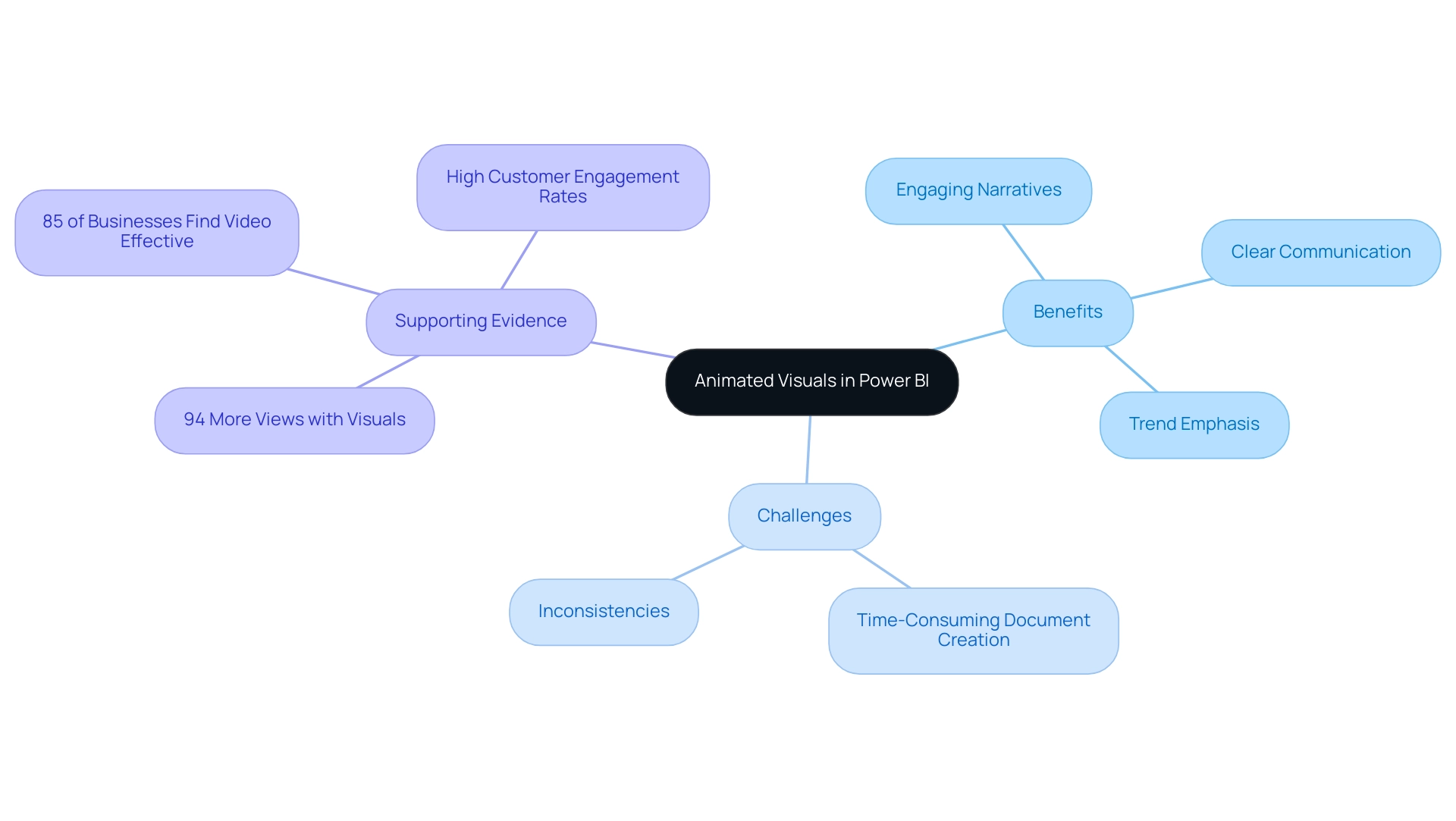
Step-by-Step Guide to Creating Animated Visuals
Creating power bi animated visuals can significantly enhance data storytelling and user engagement, addressing common challenges such as time-consuming document creation and data inconsistencies. To get started, follow these detailed steps:
- Select the visual you wish to animate from your report.
- Go to the ‘Visualizations’ pane and click on the ‘Play Axis’ option.
- Drag your selected time-based field into the ‘Play Axis’ area to define the timeline for your motion.
- In the ‘Properties’ pane, adjust the duration of the sequence to control its speed and fluidity.
- Preview your sequence by clicking the ‘Play’ button to see how it flows.
- Finally, fine-tune the visual settings to achieve the desired aesthetic and clarity.
This structured method not only simplifies the visual creation process for data analysts but also contributes to a more engaging presentation of insights, aligning perfectly with the growing demand for interactive and visually compelling data narratives. It is essential to provide training and raise awareness among users regarding the available BI products and features, particularly power bi animated visuals, to maximize their effectiveness.
As Brad Leiby, Founder & CEO of Uncommon Solutions, observes, ‘User metrics are a dependable indicator of a specific document’s failure, but aren’t as predictive of success on their own.’ This emphasizes the need for metrics to be considered in context, particularly when assessing user engagement with power bi animated visuals. Moreover, establishing a governance strategy is essential to guarantee consistency across documents, which can aid in fostering trust in the insights provided.
Additionally, incorporating feedback from focus groups during development can significantly enhance user adoption of these animated features and help establish a consistent look and feel while defining success criteria. To provide actionable guidance, consider including clear next steps or recommendations alongside the visuals to direct stakeholders on how to utilize the insights effectively.
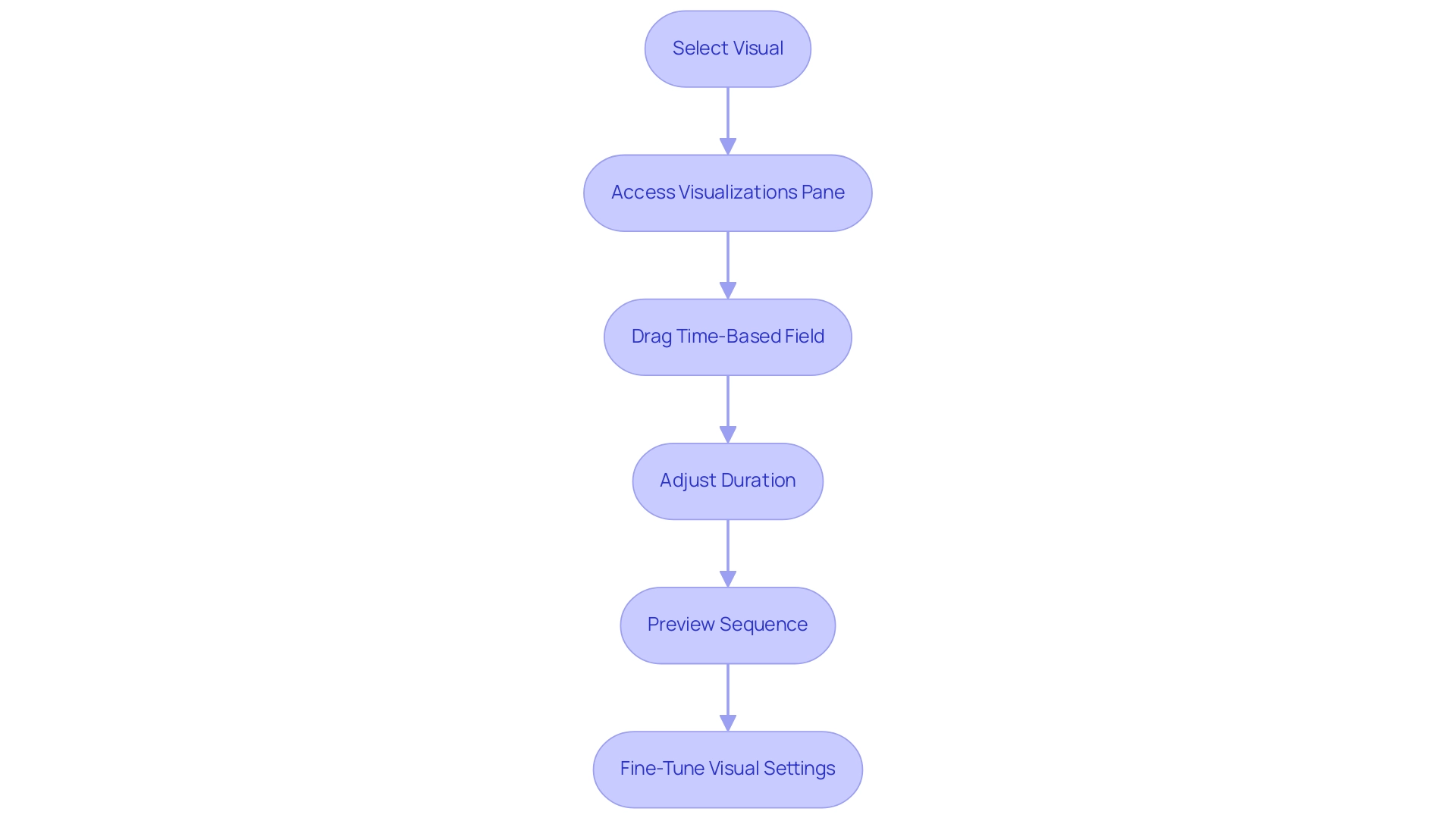
Leveraging Custom Visuals and SVG Animations
To effectively utilize custom visuals and SVG animations in BI while overcoming common obstacles such as time-consuming document creation and inconsistencies in information, follow these essential steps:
- Start by visiting the Power BI Marketplace, where you can explore a wide range of available custom visuals designed for your narrative.
- Carefully choose visuals that connect with your narrative and incorporate them into your document.
- For SVG visuals, either create your own or download SVG files that visually represent your data; as David Bacci notes,
To create your own SVGs, you can use any design tool, like Figma.
- Utilize the ‘Image’ visual feature to embed your SVG files directly into your document.
- Adjust the effects through the Power BI settings to ensure they enhance your presentation effectively.
Incorporating Power BI animated visuals along with personalized visuals and SVG animations can greatly enhance the aesthetic charm and interactivity of your presentations, making analysis not only more captivating but also more influential for your audience. Remember, while custom visuals can enrich your presentations, simplicity in core visuals is advisable unless there’s a clear business rationale for complexity.
A strong governance strategy is crucial to reduce data inconsistencies and ensure confidence in your documents. To further enhance your skills and community involvement, consider taking part in BI challenges, which not only improve your expertise but also provide practical advice for your documents. Exploring the Enterprise DNA Forum can offer additional insights as well.
Furthermore, a practical example is the ‘Creating a Fresh Usage Metrics Document’ case study, which demonstrates how users can effectively leverage BI after making necessary adjustments to their documents, offering clear, actionable guidance for stakeholders.
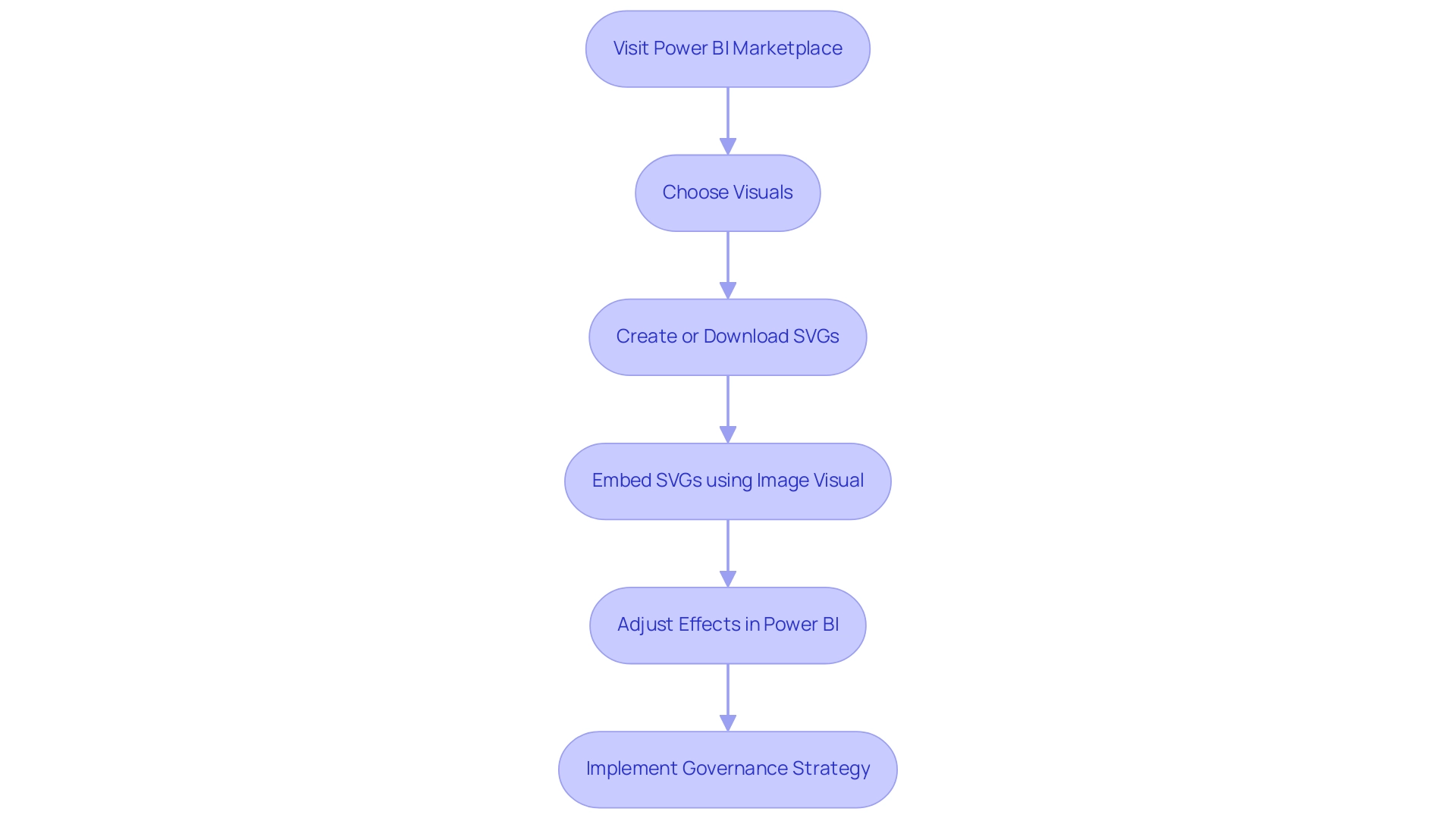
Advanced Techniques for Dynamic Animations
To craft engaging Power BI animated visuals, mastering advanced techniques is essential. Begin by using bookmarks to enable users to move through different perspectives of your analysis, improving the narrative element of your information. Integrate dynamic controls, such as slicers or buttons, which empower users to interact with visuals, tailoring their experience based on their specific needs.
This approach tackles common challenges, such as the time-consuming nature of document creation and the inconsistencies often found in data presentation due to a lack of governance strategy. Combining bookmarks with the ‘Selection Panel’ allows for seamless transitions, creating a fluid experience as users shift between different visual states. Additionally, consider layering visuals to add depth and movement, which can captivate your audience and enrich the narrative you are conveying.
It’s crucial to recognize that while interactivity can enhance engagement—evidenced by the 14,051 views on related content—it can also lead to confusion if not executed clearly. As David Cather points out, users often seek suggestions to navigate these complexities effectively. The recent case study on visual interactivity in Power BI documents suggests that using filters instead of highlighting in pie charts can enhance clarity.
This emphasizes the balance needed between interactivity and readability. Furthermore, incorporating Robotic Process Automation (RPA) solutions can streamline the document creation process, enhancing operational efficiency. By embracing these advanced techniques alongside RPA, you can develop reports that not only engage but also effectively communicate insights through Power BI animated visuals, ultimately transforming your storytelling while leveraging Business Intelligence to drive growth and operational efficiency.
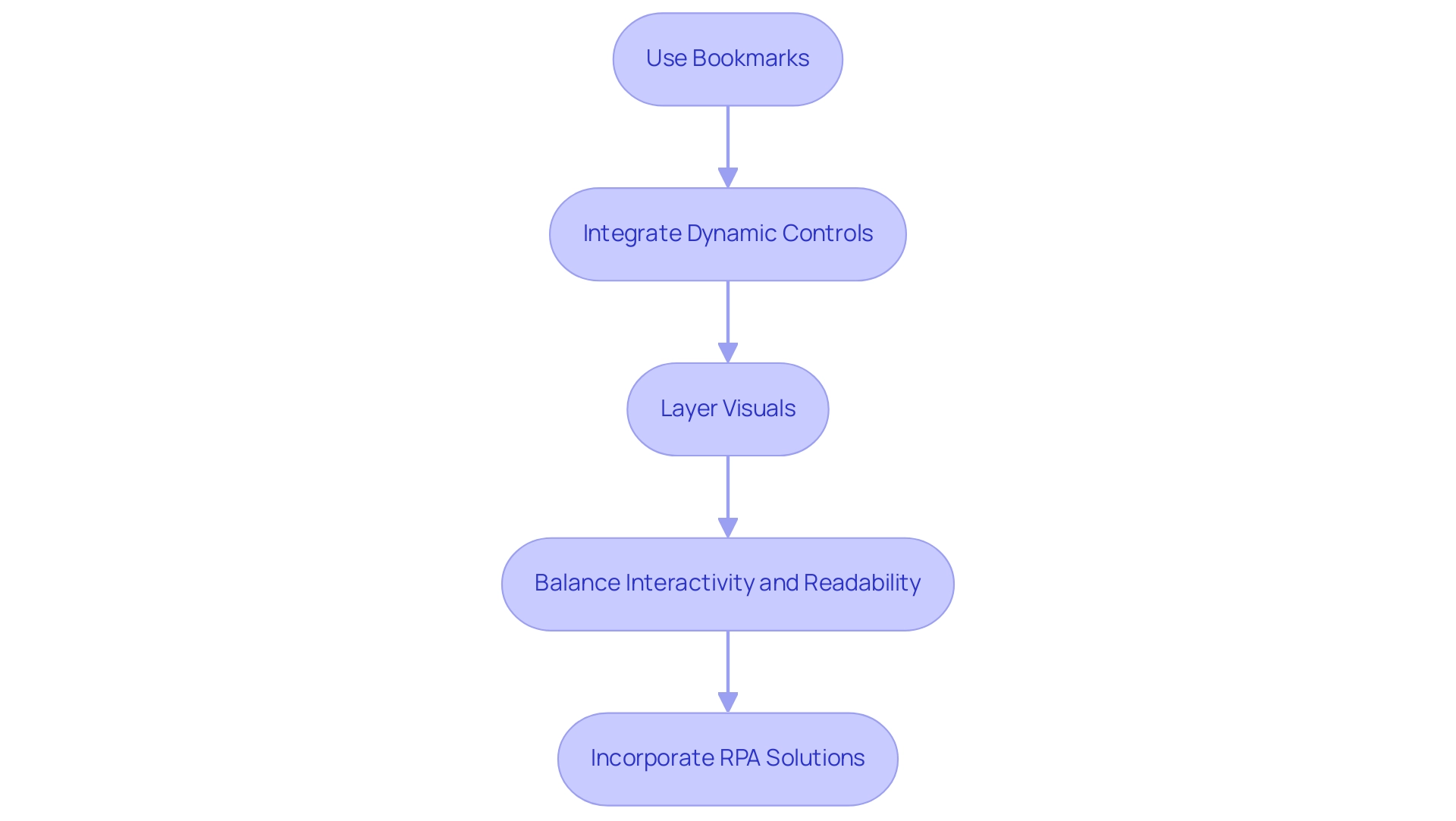
Best Practices and Troubleshooting for Power BI Animations
To maximize the effectiveness of power bi animated visuals in BI and enhance your reporting capabilities, adhere to these essential best practices:
- Maintain subtlety in power bi animated visuals to ensure that the focus remains on the data rather than on the visual effects.
- Evaluate your visuals across different devices to ensure compatibility and a seamless user experience.
- Regularly update your BI software to take advantage of the latest features that enhance performance and usability.
Monitor the overall performance of your documents, as excessive power bi animated visuals can lead to slower loading times, detracting from user engagement. Additionally, consider our 3-Day BI Sprint, designed to create a fully functional, professionally designed report that allows you to focus on utilizing insights for impactful decisions. This sprint includes personalized consultation to identify key metrics, data integration strategies, and design best practices tailored to your business needs.
Significantly, Sahir Maharaj provides over 100 complimentary BI Themes, which can be a useful asset for improving your visual presentations. When facing problems with visuals not functioning as expected, start by examining visual settings to guarantee correct configuration. Engaging with community forums can provide insights, but remember that customizing interactions between visualizations can significantly improve user understanding and support informed decision-making, as illustrated in our case study where a client increased their reporting efficiency by 30% after implementing our recommendations.
By implementing these best practices and troubleshooting strategies alongside our comprehensive Power BI services, you can significantly enhance your power bi animated visuals and reporting, resulting in more impactful and interactive presentations that resonate with your audience. As Sahir Maharaj states, ‘Effective data presentation is crucial for driving insights and decisions.
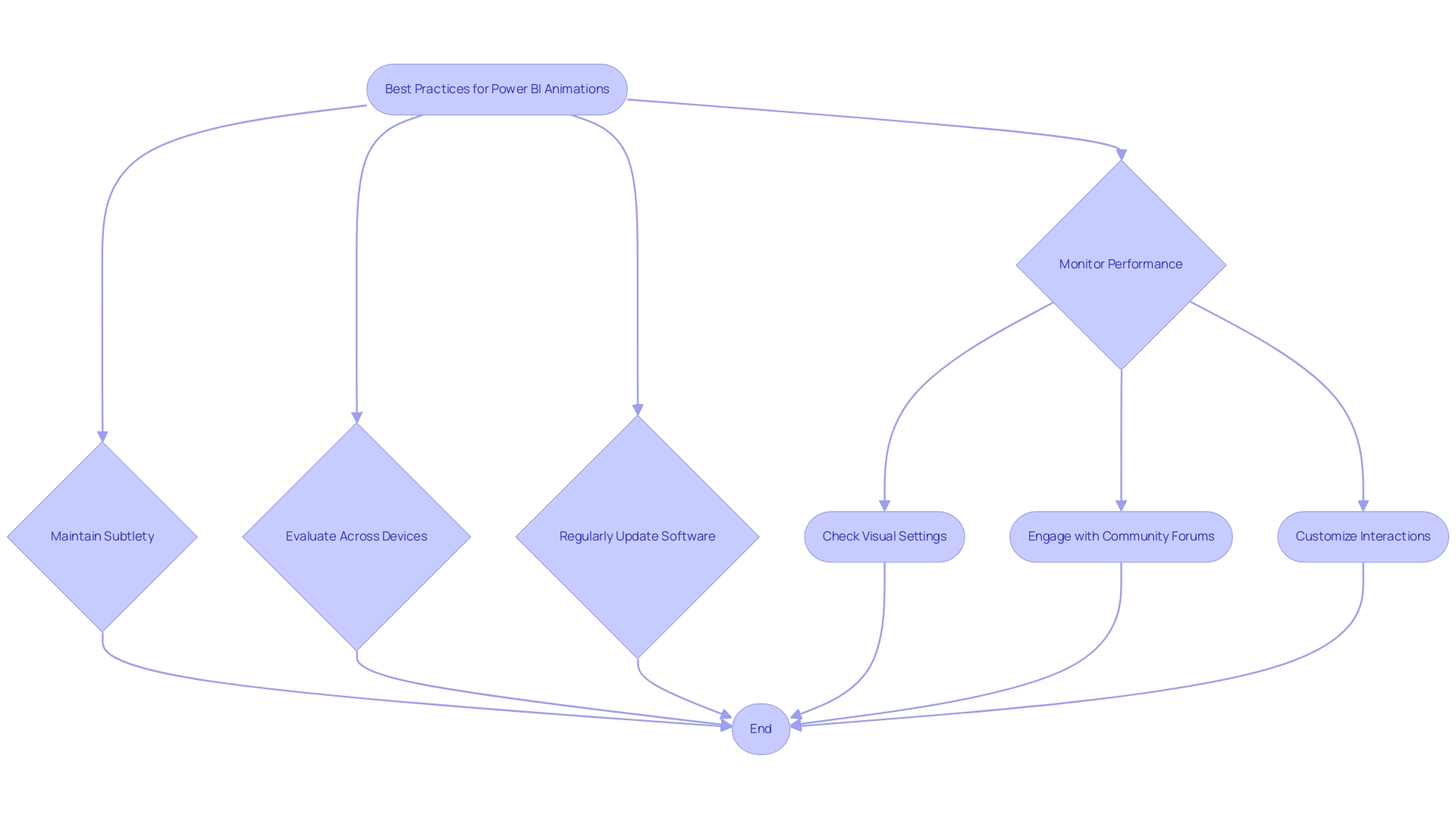
Conclusion
The integration of animated visuals in Power BI is a game-changer for data storytelling, transforming complex datasets into engaging narratives that resonate with stakeholders. By employing dynamic representations, analysts can effectively address common challenges such as:
- Time-consuming report creation
- Data inconsistencies
While also enhancing user engagement. The step-by-step guide and advanced techniques outlined provide a clear pathway for professionals to create compelling animations that not only captivate audiences but also convey critical insights.
Leveraging custom visuals and SVG animations further enriches reports, allowing analysts to present data in a visually appealing and interactive manner. Best practices for implementing these animations ensure that the focus remains on the data while maintaining performance across various platforms. The emphasis on subtlety and clarity in visual effects reinforces the importance of effective communication in data presentation.
Ultimately, embracing animated visuals in Power BI is not merely a trend; it is an essential strategy for organizations aiming to foster deeper connections with their audiences and drive informed decision-making. By mastering these techniques and adhering to best practices, professionals can unlock the full potential of Business Intelligence, paving the way for meaningful insights and business growth. The time to elevate data storytelling is now—embrace the power of animations and transform the way data is perceived and utilized within your organization.
Overview:
Power BI animation enhances data visualization by transforming static reports into engaging narratives that improve understanding and retention of information. The article emphasizes that incorporating visual effects, such as transitions and dynamic animations, not only captures audience attention but also facilitates clearer insights and actionable guidance, ultimately driving better decision-making and operational efficiency.
Introduction
In an age where data reigns supreme, the ability to transform static reports into dynamic narratives is crucial for effective communication. Power BI offers an innovative approach to data visualization that not only captivates audiences but also enhances understanding and retention of information.
By incorporating animations, organizations can address common challenges such as:
- Time-consuming report creation
- The need for actionable insights
As visual storytelling becomes increasingly important, mastering techniques like:
- CSS animations
- Dynamic visuals
- Bookmark animations
can empower users to present data in a compelling way that drives engagement and informs decision-making.
This article delves into the various methods of integrating animation in Power BI, providing practical solutions to elevate data presentations and foster deeper connections with stakeholders.
Introduction to Power BI Animation: Enhancing Data Visualization
Power BI animation acts as a powerful tool that transforms static reports into captivating narratives, effectively addressing the common challenges of time-consuming report creation and the lack of actionable guidance. For example, employing transition effects can assist in emphasizing crucial insights while leading individuals through intricate information pathways, thereby minimizing discrepancies and building confidence in your findings. Research shows that approximately 50% of the human brain is dedicated to processing visual information, suggesting that compelling visuals significantly enhance engagement and understanding.
On average, the brain can hold 7 pieces of information in short-term memory for 20-30 seconds, which highlights the importance of concise visual storytelling through Power BI animation. Moreover, incorporating visual effects not only fosters improved user engagement but also enhances information retention, as individuals retain up to 65% of information three days after viewing an image, compared to a mere 10% from auditory channels. The findings from the case study titled ‘Data Visualization Statistics on Brain Processing’ further underscore the effectiveness of visual content in communication and learning.
With the trend that by 2026, 75% of all information will be visualized, it is essential to understand the various types of visual effects available in Power BI animation, such as:
- Fade-ins
- Zooms
- Motion paths
and their applications in storytelling. By embracing these dynamic elements, you position your documents as not just informative pieces, but as visually compelling stories that foster greater understanding and retention among your audience, ultimately turning data into actionable insights.
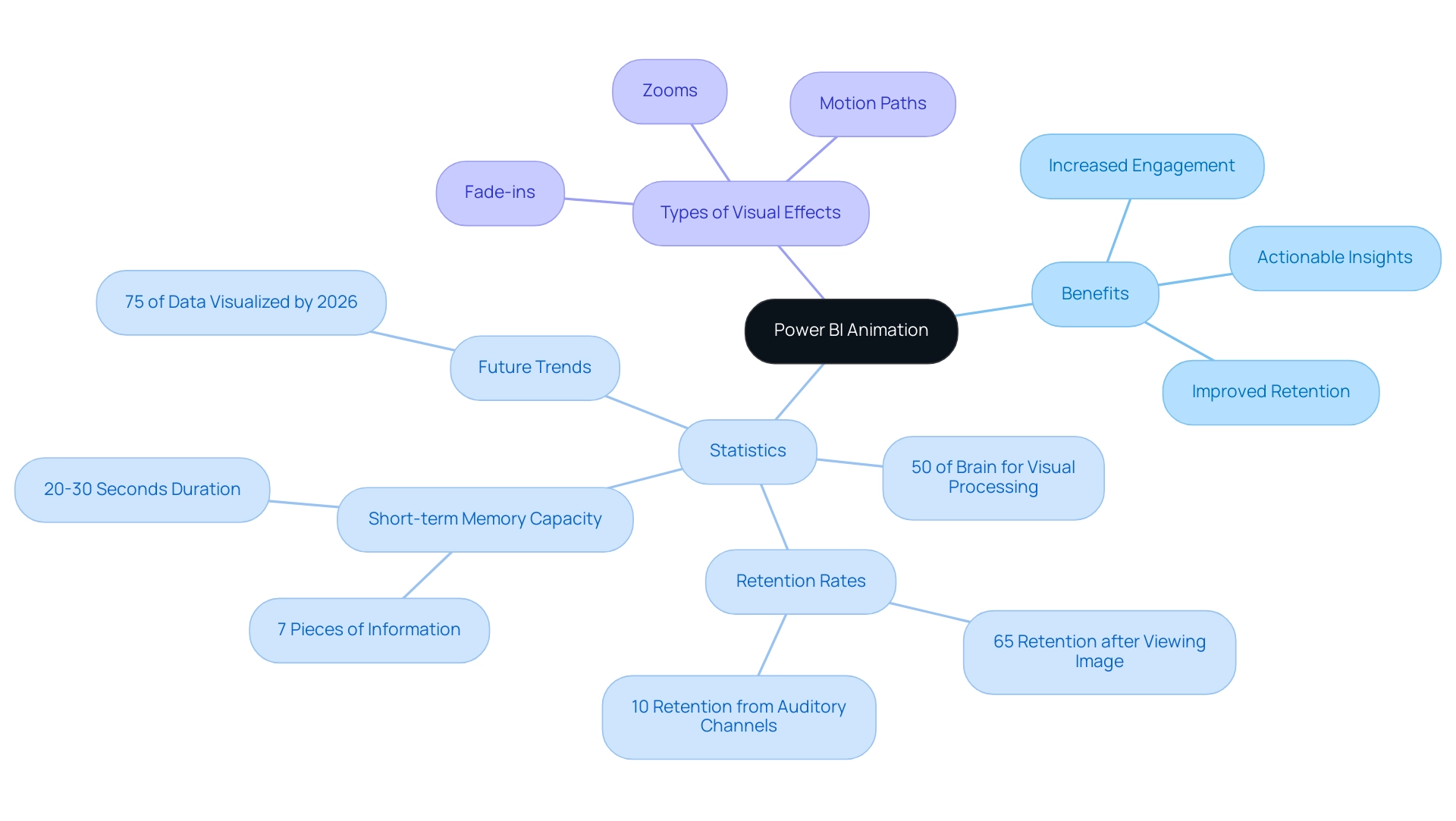
Utilizing CSS Animations for Engaging Power BI Reports
To effectively incorporate CSS animations in Power BI animation, begin by utilizing the Power BI service to embed your visualization within a web page. This step not only enhances the visual appeal but also addresses the challenge of time-consuming report creation by streamlining the presentation of insights. By applying various CSS styles, you can significantly enhance your visuals, making it easier for stakeholders to trust the information presented while also providing clear, actionable guidance.
For example, utilizing CSS transitions in a Power BI animation can enhance the appearance of information points—creating an engaging experience that highlights key metrics and clarifies the next steps for your audience. A practical example could involve adding a CSS class to a point that enlarges it upon hover, thereby drawing attention to crucial insights. Furthermore, implementing a governance strategy can help mitigate data inconsistencies, ensuring that the visuals reflect accurate information and support decision-making.
As Navid M., a Software Engineer, suggests,
For JavaScript-driven visual effects, use
requestAnimationFrameinstead ofsetTimeoutorsetInterval. This method provides a more efficient way of creating smooth visuals by allowing the browser to optimize timing, which enhances interactivity and aligns movements with the display refresh rate, optimizing CPU usage while avoiding unnecessary frame rendering. It’s important to note that reflows occur when the browser recalculates the positions and geometries of elements in the document, which can impact performance.
To mitigate this, consider using transform: scale() for resizing elements instead of animating width or height. Furthermore, an extensive examination of HTML5 web technologies has demonstrated that contemporary CSS effects and Power BI animation can greatly enhance user involvement in reports, offering a remedy to the difficulty of displaying intricate information. However, it is essential to uphold a sense of professionalism; therefore, keep visual effects understated to ensure they improve rather than divert attention from your presentation.
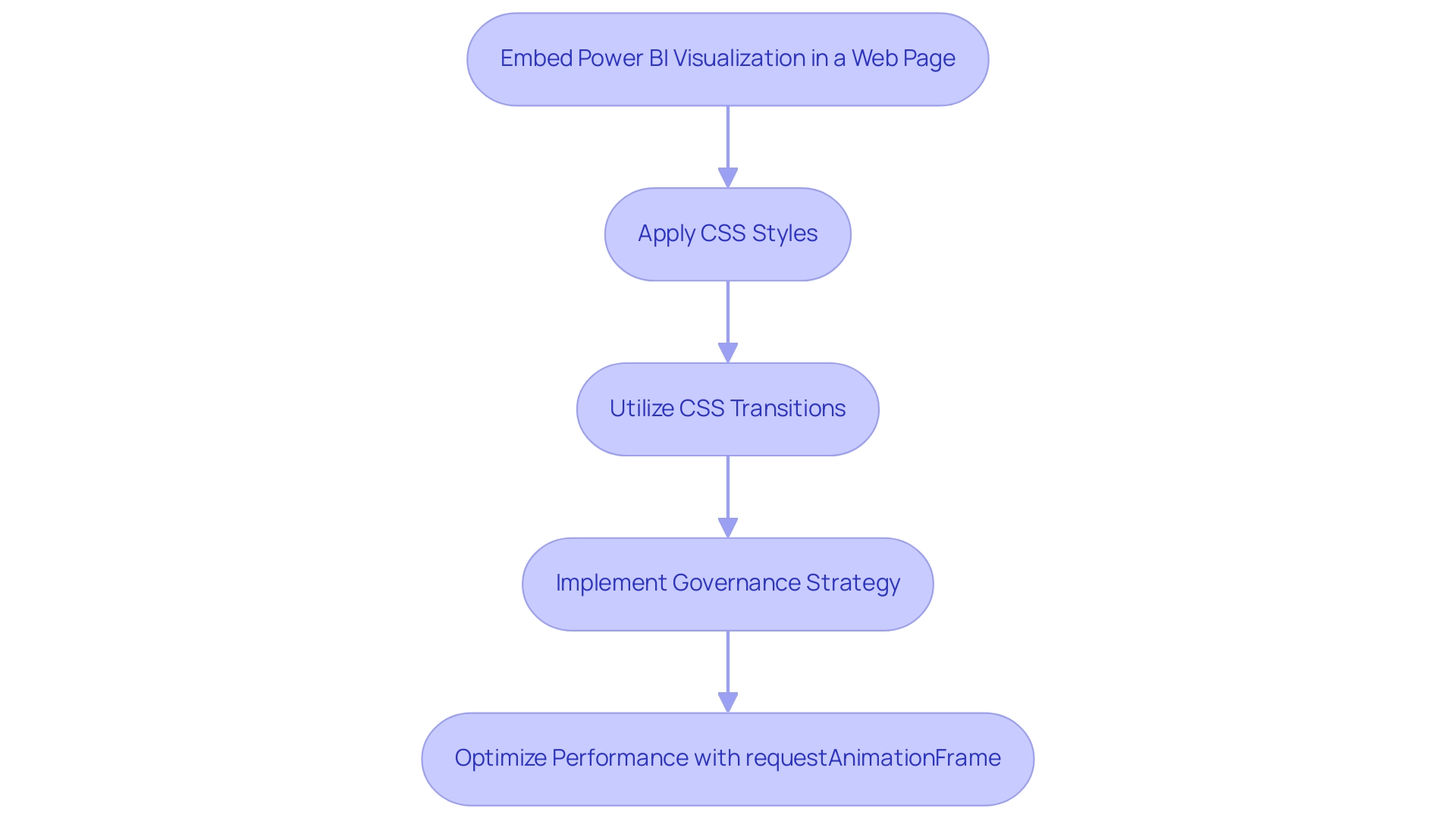
Creating Dynamic Animations with Inovista Animator Visual
To utilize the capabilities of dynamic visuals with the Inovista Animator Visual in Power BI, begin by confirming your information is organized and tidy, as this is an essential step in producing dynamic presentations. Once your information is prepared, download and import the visual into your report. After integration, link it to the pertinent information fields to establish a strong connection for your visuals.
This setup enables you to configure Power BI animation that responds to changes, such as transitions reacting to applied filters or slicers. For instance, think about animating sales growth over time; each point can dynamically animate as you move through various months or years. Aashi Verma, a dedicated researcher in enterprise and cloud technologies, emphasizes that these tools are at the forefront of improving visualization.
By utilizing such features, companies can address typical obstacles in document creation, such as information inconsistencies and absence of actionable insights. Not only do these visuals enhance the aesthetic charm of your documents, but they also significantly increase viewer involvement through Power BI animation by demonstrating real-time information changes in an engaging way. Moreover, incorporating RPA solutions can optimize the information preparation procedure, guaranteeing that your documents are consistently refreshed and precise, thus minimizing the time devoted to manual tasks.
Ultimately, by utilizing such animations and RPA, you empower your audience with clearer insights, fostering a deeper understanding of the information at hand and driving operational efficiency. The shift from fixed summaries to interactive displays signifies a notable progress in information interaction, as highlighted in a recent case analysis, where dynamic dashboards offered real-time insights and permitted individuals to tailor their perspectives, greatly improving information exploration and decision-making. Failure to utilize these powerful tools can leave businesses at a competitive disadvantage, underscoring the importance of adopting Business Intelligence strategies.
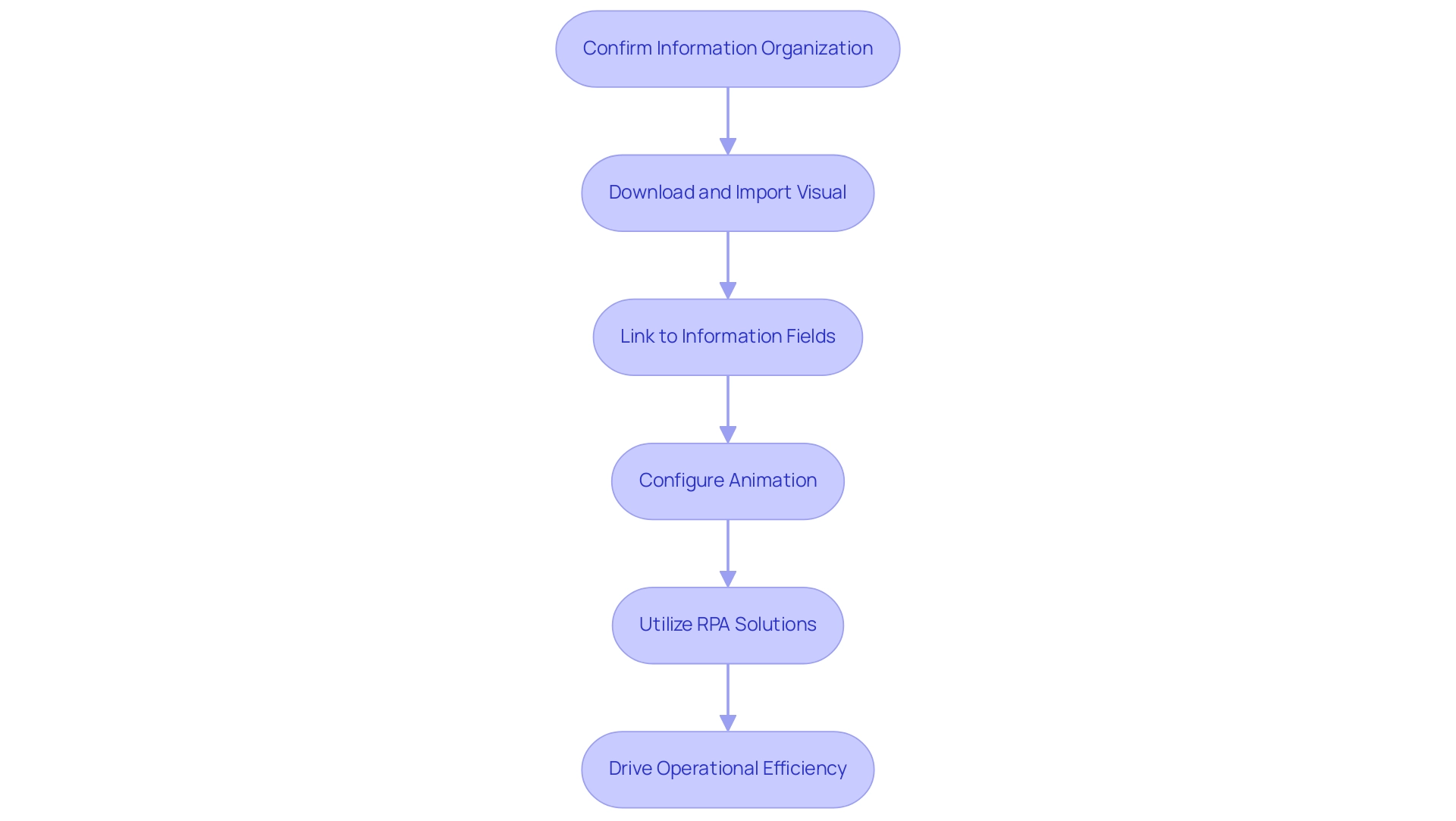
Animating Reports with Bookmarks: A Step-by-Step Guide
Power BI animation through animating documents with bookmarks can significantly improve experience and interactivity, a crucial aspect in today’s data-driven landscape. However, many individuals encounter difficulties such as time-consuming document creation and data inconsistencies when utilizing insights from Power BI dashboards. To achieve a more effective presentation, start by creating bookmarks that represent different states of your report; for example, one bookmark could display total sales while another illustrates sales by region.
Next, assign buttons to each bookmark, enabling individuals to easily navigate between these states. To add a Power BI animation effect, you need to adjust the transition settings of the bookmarks, which will determine how quickly or slowly each transition occurs. This method not only offers a seamless experience as individuals explore various data perspectives but also contributes to a more engaging presentation.
Remember, enhancing user experience in this manner can lead to substantial improvements in both customer retention and overall profitability; an increase in UX design by just 5% can result in a 25% profit boost. In fact, it takes less than 500ms to make a good first impression, underscoring the importance of immediate engagement when using bookmark effects. By utilizing these Power BI animation features, you enable your audience to explore further into the narrative you are presenting.
Additionally, integrating RPA solutions like EMMA RPA and Power Automate can further streamline processes, addressing staffing shortages and outdated systems that complicate report generation. As highlighted in our exploration of Business Intelligence, understanding client needs is essential for effective data presentation strategies. Furthermore, case studies demonstrate that brands leveraging effective UX strategies can see substantial returns; for instance, the average ROBO multiplier for brands in the Bazaarvoice Network is 3.91x, indicating that every $1 of revenue influenced online can lead to $3.91 in-store.
This clearly illustrates how enhancing experience through Power BI animation and robust RPA solutions can lead to significant financial outcomes, ultimately driving business growth and operational efficiency.
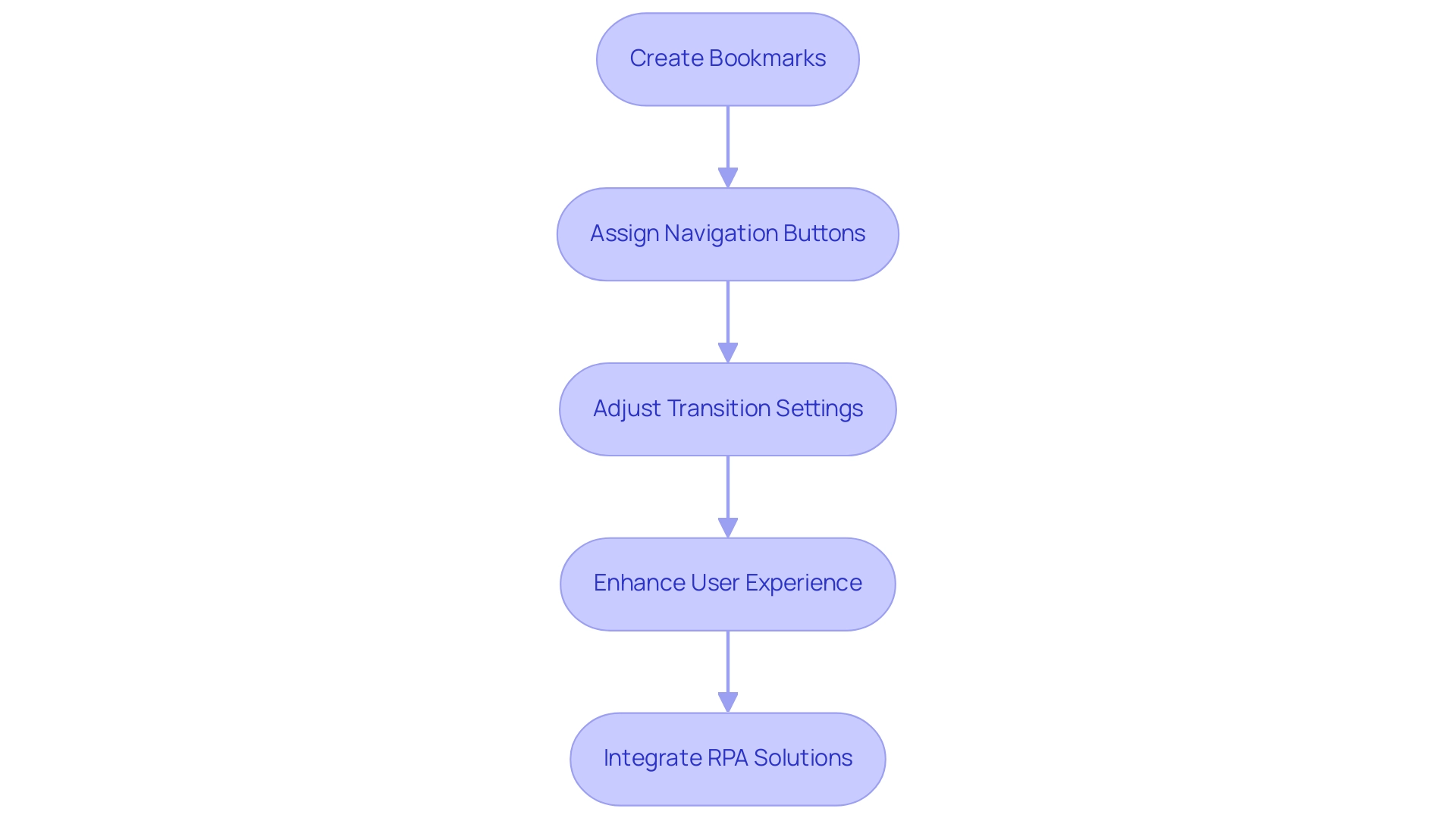
Adding Animated Effects to Power BI Buttons for Enhanced Interactivity
To create engaging animated effects for buttons in Power BI animation, begin by crafting a custom button using the button visual. Once established, you can enhance its interactivity by applying CSS styles for hover effects, which might include color transitions or size adjustments. For example, when a user hovers over the button, changing its background color not only signals interactivity but also draws attention to the element, enhancing the overall user experience.
Recent updates recommend:
- Setting the State to ‘On Hover’
- Adjusting the Blur option to 25px in the Glow section, which is ideal for buttons.
This configuration creates a Power BI animation effect where the button glows and decreases in size, revealing a colorful animated GIF behind it. As Prathy Kamasani noted, “Steve, Updated the post with a link,” emphasizing the importance of staying informed about these enhancements.
Additionally, the case study titled ‘Grouping Visuals for Enhanced Clarity’ illustrates how organizing related visuals can improve dashboard effectiveness, complementing the discussion on button interactivity. Encourage experimentation with various effects to discover what resonates most with your audience while ensuring that the buttons remain functional and accessible. Following best practices for interactive buttons can significantly improve engagement, making your Power BI animation more effective and visually appealing.

Conclusion
Incorporating animations into Power BI transforms static reports into dynamic narratives that captivate and engage audiences. By addressing common challenges such as time-consuming report creation and the need for actionable insights, these techniques enhance the clarity and retention of information shared. The use of CSS animations, dynamic visuals, and bookmark animations not only provides a visually compelling experience but also empowers users to convey meaningful stories through their data.
The ability to animate reports with bookmarks and interactive buttons further elevates the user experience, making it easier for stakeholders to navigate complex datasets and derive valuable insights. By employing these strategies, organizations can significantly improve their communication effectiveness, ultimately leading to better decision-making and operational efficiency.
As the landscape of data visualization continues to evolve, embracing these innovative techniques will be essential for staying competitive. The shift from static reporting to interactive, animated dashboards marks a pivotal advancement in how data is presented and understood. By harnessing the full potential of Power BI animations, businesses can foster deeper connections with their audience and drive impactful outcomes.
